Madi’s Kitchen is a delightful page of all of Madi’s recipes, updated with the newest recipe each week.
Madi will provide a recipe that she has developed that has been tested on her friends and family. Read more about Madi, and other contributors to The Ratonian on the About Us page.
Madi’s Recipes
Posted in 2025
Posted in 2024
- Snowball Cookies
- Gingerbread Recipe
- Roasted Balsamic Winter Vegetables
- Ambrosia Salad and Fruit Turkey
- Pumpkin Pie and Pie Crust
- Patriotic Pound Cake
- Two Layer Skull Cookies
- Trick or Treat Shakes
- Chile Chicken Stew
- The Sweet World of Caramel Apples
- Nostalgic Tomato Soup
- Fluffy’s Fluffy Biscuit Sandwich
- Lavash bread
- Modern Cheesecake
- Sweet Pickled Watermelon Rinds
- Pokémon Toast Curry
- Pokémon Sandwich Extravaganza
- Salsa Fresca
- Donuts
- Super Easy Two Ingredient Gummies
- Bagels
- Mango Highlight
- Grandpa’s Pizza
- Pumpkin Spice Puppy Treat
- Very Berry Birthday Crepe “Cake” (Crepes Revisited)
- Flan
- Better than Cheez-Its
- Greek Salad
- Chicken and Dumpling Soup
- Chinese Fried Rice
- Pecan Shortbread
- Spring Asparagus Pasta
- Strawberry Rhubarb Crepes
- Homemade Marshmallow Peep
- Hot Cross Buns
- Corned Beef and Cabbage
- Mashed Potato Leftover Waffles
- Basic Egg Bread
- Nana’s Favorite Chocolate Chip Cookies
- Sourdough
- February 11, 2024 Valentine’s Day special German Chocolate Cake
- February 4, 2024 Pumpkin Ravioli
Onigiri Rice Rolls
Posted May 26th, 2025
Onigiri are portable and easy-to-eat rice balls wrapped in seaweed, with various fillings and flavors. These are Onigiri but if you watch the original Pokémon anime, you might remember them being called jelly donuts. While these are not chili donuts, they are just as tasty and delicious. The reason they were dubbed like that is because the channel that dubbed it as such thought that some young kids might not know what Onigiri is and so called the many different things, most famously jelly donuts. Specifically, the time when Brock said that donuts are great and jelly filled are his favorite.
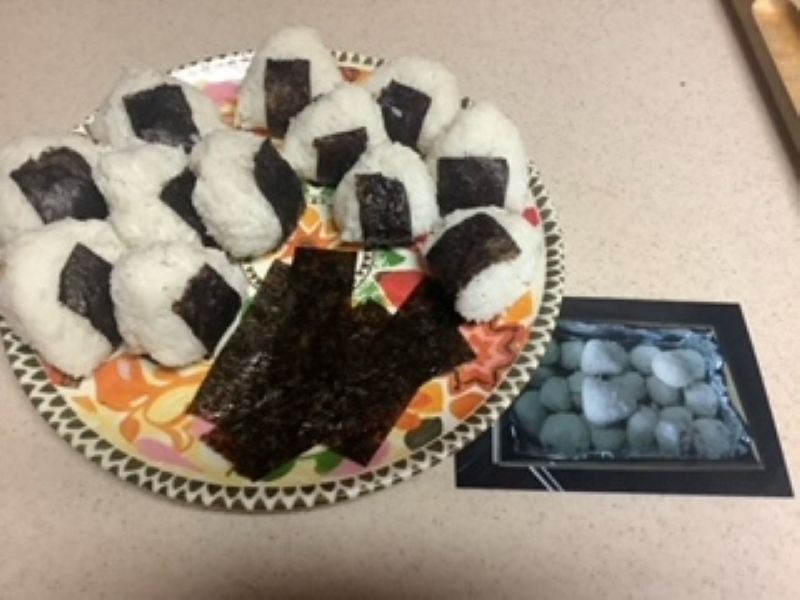
Personally, I’d prefer a plain doughnut since I’ve had trouble making jelly filled in the past. I still think jelly filled donuts are amazing too. For the recipe you will want to use short white grain rice since it will be stickier than longer grain rice. You will also want to wash your rice before cooking it. Triangle shapes are the most common to see. You could, if you wanted to, shape them into a square, a circle, or a rectangle. They’re also molds you can use to help shape the onigiri. Also, if you want, you can wrap them with some seaweed on the outside.
You do not have to fill these if you do not want to, but if you want, you can. For this recipe I just use some tuna and mayo but also ate some plain.
Recommendation time! This week my first recommendation is Komi Can’t Communicate. Komi is a high school girl with extreme social anxiety who struggles to communicate with covers and mostly uses a notebook to speak to people, especially, in the early parts of the manga and show. On her first day at ltan Private Highschool she has already become extremely popular, with her unsurpassed stoic, beauty and refined elegant. Tadano sits next to her in class and on the first day of school he talks to Komi with the chalkboard learning that her goal for high school is to make 100 friends and he decides to help her make a 99 more. Another quite common character you will see in the show is Najimi who is a childhood friend with everyone in school. Komi was the only one that they could not befriend.
This high school is full of strange but fun kids. Some of them can be stranger than others but all of them play a role in the story and I like all of them except Yamai who is obsessed with Komi and literally kidnapped Tadano in one of the episodes. She does get better, I think? She at least doesn’t kidnap him again.
The second one I recommend if you like, Komi Can’t Communicate would be Frieren Beyond Journey’s End. This anime is about Frieren and her journey after defeating the demon king with the party of heroes. Frieren is an elf who will live longer than most people in the show can imagine, except the other elves. After defeating the demon king for around 50 years Frieren just traveled from one place to another before visiting her old party again. Soon after one of the members of the party died, and she realized how she wished she spent more time with them learning about them in more than 10 years of travel together. A few years after that she decides to visit another one of her party members a “corrupt priest” she calls him. He asks her to teach fern magic. Fern is a little girl he adopted after her parents died. Essentially, she did, after his passing (or close to it) she and Fern go and travel, eventually meeting a young man named Stark. Frieren and Fern helped him slay a dragon. This one is very touching and in the first few episodes time goes fast. It slows down a bit more in later episodes.
I hope you enjoy this recipe, and I hope you enjoy these anime shows too. I love watching these and I love giving recommendations. Enjoy!
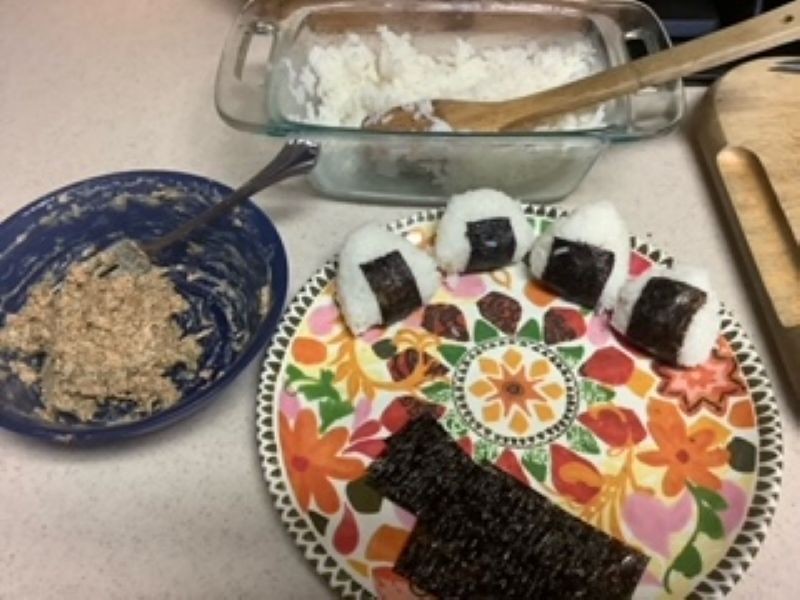
INGREDIENTS:
Rice:
- ¾ cup short-grain rice
- 200 ml of water
- ¼ teaspoon salt, fine-grained sea salt or kosher salt
- 1 teaspoon rice vinegar
Wrap:
- 1 sheet of dried nori seaweed
Filling:
- 1 can of tuna
- Mayo
- Seasoning as desired
INSTRUCTIONS:
Preparing Rice
- Transfer freshly cooked rice from your rice cooker or pot to a large bowl or glass baking dish.
- Using a spatula, gently spread out the rice to cover the bottom of your bowl.
- Sprinkle the salt (¼ tsp) and vinegar over the top of the rice and then mix into rice by lightly tossing and folding over.
- Cool the rice until you no longer see clouds of steam and the rice has cooled just enough so that you can hold it in your bare hands.
Shape Onigiri by Hand
- Fill a bowl with room temperature water and a small dish with salt. Keep these nearby to use as needed.
- Using your spatula, divide the cooked rice into three equal sections in your bowl or pan.
- Dip both of your clean hands into your bowl of water. Shake off the excess water.
- Using your hands or spatula, scoop up enough rice to make one onigiri.
- First, like making a snowball in two hands, gently form the rice into a sphere. Make it a ball shape but not too compact.
- Then, gently squeeze the rice ball with your hand to make it V-shaped forming one corner into a triangle.
- Repeat this rotating and squeezing process until you’ve made a neat triangle shape.
- Once you have done that, you can cover with a thin slice of seaweed
- If you want to fill these, just take a little bit of the tuna mixture and put it inside the rice before you shape it.
- Take the tuna and drain off any extra liquid put it into a bowl and add in the seasoning and mayo mix altogether and you’re done

Tres Leches 2025
Posted April 26, 2025
One of my favorite cakes is tres leches, because of the rich milk and all the fruit that I like to put on in a pattern! This cake would probably be considered a straightforward cake with no fancy flavoring, and easy enough instructions, especially if you already know how to bake. Even so, it is a great cake with a lot of flavors. Tres leches means three milks in Spanish referring to the three milks in the mix that you pour over the cake. The three milks are of course evaporated milk, sweetened condensed milk and cow milk. If you want, you can replace the cow milk with coconut milk and coconut cream like I did in this recipe.
Like many recipes, there are variations of this cake from all around the world and it’s hard to track down exactly where it originated. The recipes are from many places like Mexico, Colombia, and Puerto Rico. The story and how the tres leches came to be varies from place to place. The inspiration for this cake most likely originated from England around the Middle Ages. This cake is remarkably similar to a trifle in the ingredients and how you put it together. In a trifle you have a pudding, a sponge cake, usually some whip cream or something similar and fruit, sometimes jam also. And then you layer the ingredients in a dish similar to the tres leches cake. In England, in the Middle Ages, soaking a cake with milk was an easy way to save or repurpose older and staler cakes, and even to the day this is a great way to repurpose an older cake. I personally go to more of the cake pop route with older cakes, but both are really good options.
This cake, and this variation, probably didn’t happen until around the 1940s when can goods like evaporated or condensed milk would be more widespread and easier to get hold of for cooking or baking. I made a tres leches cake for my Grandpa’s birthday last year. In the future, I’m hoping I’ll be able to make this cake with our own fruit from our garden and enjoy it with my brothers, while just enjoying watching Pokémon together. Or have it for a Saturday at the farmers’ market. That would be amazing and maybe someday it will be true!
Like all foods this tres leches cake is changing all the time, with new recipes being made, old recipes being lost, and people innovating it further. I’m excited to see how people will try to innovate this cake in the future. Maybe with different milks or more fancy fruit. Either way this cake will always be one of my favorites!
I really hope you enjoyed this week’s recipe and if you did come over to our farm this Saturday, I hope you enjoyed the tour of our farm and the food that I made! Enjoy the cake!
Tres Leches Cake Ingredients:
- 5 eggs, divided, separating the whites and yolks
- 1/2 cup of butter, softened (1 stick)
- 1 cup granulated sugar
- 1 and 1/2 teaspoons vanilla
- 1 and 1/2 cups flour, spooned and leveled
- 1/2 teaspoon kosher salt
- 1 teaspoon of baking powder
- 1/4 teaspoon baking soda
Tres Leches Milk Mix Ingredients:
- 1 (13.6-oz) can full-fat coconut milk
- 2 cups Coco Crema (coconut cream), about 1 (15-oz) can or cow milk if you prefer
- 1 (14-oz) can sweetened condensed milk
- 1 (12-oz) can evaporated milk
Tres Leches Toppings:
- Berries of your choice (I used strawberries, raspberries, and my favorite blueberries!)
- Whipped Cream
Instructions:
- Preheat the oven to 350 degrees F.
- Grease a 9×13-inch cake pan with butter.
- In a large bowl or stand mixer, add 5 egg whites. Place the egg yolks in a small bowl and set aside.
- Beat the egg whites for about 2-4 minutes, until stiff peaks form.
- Scrape the egg whites into a medium bowl and store in the fridge.
- In the same bowl that you beat the egg whites, add 1/2 cup butter, and beat until smooth, scraping edges. Add 1 cup sugar and beat until light and fluffy, about 2 minutes, scraping sides halfway through. Add 1 and 1/2 teaspoons vanilla and beat well.
- Add the egg yolks one at a time, beating well after each addition.
- In a medium bowl, whisk together 1 and 1/2 cups flour, 1/2 teaspoon salt, 1 teaspoon baking powder, and 1/4 teaspoon baking soda.
- Get the beaten egg whites out of the fridge. Now you are going to add the flour mixture and the beaten egg whites into the butter/sugar mixture in alternating batches. Add about half the flour to the butter mixture, stir. Then add half the beaten egg whites to the butter mixture, stir. Continue adding and stirring until it is all added but be careful, do not over mix, once it is combined, stop.
- Scrape the batter into the prepared pan and spread out with a spatula.
- Bake the cake at 350 degrees for about 25-30 minutes or until the edges are pulling away from the sides of the cake pan. Double check with a toothpick inserted in the center of the cake, if it comes out with no batter on it is baked.
- While the cake is baking, make the milk mixture in a large glass measuring cup or bowl. Add 1 can of coconut milk. Stick it in the microwave for 30-60 seconds and stir until all the lumps have disappeared. Add 2 cups Coco Crema (coconut cream), 1 can sweetened condensed milk, and 1 can evaporated milk. Stir together until combined.
- When the cake is baked, remove from the oven, turn off the oven, and set a timer for 5 minutes. When the timer goes off, use a chopstick to poke holes into the cake. You want a LOT of holes.
- Once you have holes poked into the cake, take 3-5 minutes to SLOWLY pour the milk mixture over the top of the cake. If you pour too quickly, the top of your cake will not absorb the liquid. Yes, pour all of the liquid on the cake. It seems like too much. It’s not!
- Once the liquid is poured onto the cake, you can set it in the fridge and let it soak for a few hours. You don’t have to let it soak for a few hours if you don’t want to you as you could probably serve this after an hour, but it does taste better after it has a chance for all of the milk to soak in.
- Once the cake has soaked enough for your liking, top it with whip cream, and lots of fruit for a delicious cake ready for any occasion!

Chocolate Nests – Pascha Basket
Posted April 13, 2025
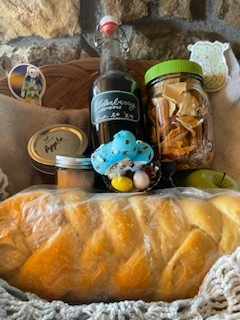
This week’s recipe is a fun spring / summer treat that can be made with a few ingredients. This chocolate nest recipe is simple enough that you could probably make it with most people pretty easily, and even if not, at least you can still enjoy it together.
Pascha, also called Easter, is the feast of the Resurrection of Christ. The preparation of the Pascha basket is one of the most cherished customs associated with Easter. This basket, filled with a variety of specially prepared foods, is an essential part of the Paschal celebration
I made a Pascha Basket for some of our friends. One item we put in our basket, includes these chocolate nests – of course! A couple of other things include basic egg bread (the same recipe I put up last year), elderberry wine that my mom made, dried apple slices, two stickers (from my personal collection, I love stickers so much!), salt, apple butter, and balm of Gilead. Plus a few more things too, they just weren’t in the basket while I’m writing this.
Some of these items are traditional to put in a Pascha basket, like wine, bread, and butter. Often the butter is shaped like a cross or a lamb. We ended up just putting ours in a jar for the basket. A couple of other things that are usually included are eggs, sausage, ham, cheese, or some horseradish with beets. Some of these could be a bit hard to get, especially right now, like fresh horseradish and beets (and maybe eggs).
Each item in a Pascha basket does represent something. To learn more about those, this article is rather good and has a great diagram of the Pascha basket. https://www.asceticlifeofmotherhood.com/blog/traditionalpaschabasket
In making our egg bread and adding eggs to our basket we are lucky enough to have our own chickens, so eggs are not a problem for us. We actually sell our eggs sometimes, mostly to Skateland in Trinidad and to close friends in Raton and Trinidad. We also offer eggs, mostly in the summer when it’s farmers market season.
Right now, one of our chickens is sitting on a batch of 16-18 eggs! She is just so puffed up, which is so cute since she is literally a Bantam chicken. Our ducks are sitting for the first time in like seven years. The two Peking ducks are actually sitting on a nest with 26 eggs! Maude and Marie Curie, two of our first ducks who have now passed away, would be so proud of them.
We also have some turkey eggs in an incubator that we’re trying to hatch out with some more on the way of species we don’t currently have. Right now, we have three turkeys, all of which are blue slate turkeys. Their colors can range anywhere from black pitch to pure white, which means they usually end up looking really cool. We have two gray ones and one black one. Unlike what you might think they are actually very snuggly and sweet. They are pretty much just like big feathery dogs.
I hope you appreciate this simple recipe and all the delicious food in your own Pascha basket. Enjoy!
Chocolate Easter Nests (Baskets)
Ingredients:
- 1/4 – 1/2 cup chocolate chips
- Marshmallow peeps (I have a recipe for them from last year)
- Small chocolate eggs
- 1/8 cup coconut, shredded
- 1 1/2 teaspoons ginger powder or chili powder
Instructions:
- In a double boiler melt the chocolate over low heat, this could take anywhere from 5 to 10 minutes. Once the chocolate has melted, take a cupcake wrapper and pour a little bit of chocolate inside, spread it around, so it covers the sides. Repeat with the rest of the chocolate and let them rest in the freezer.
- While the chocolate is setting take the coconut and ginger or chili powder and mix them together in a small bowl.
- Once the chocolate is done setting, just take it out of the freezer, take a bit of the coconut mix and lay it down inside. Then just line with your chocolate eggs and marshmallow peep and they are all done!



Stuffed Bell Peppers and Tomato Sauce
Posted April 5, 2025
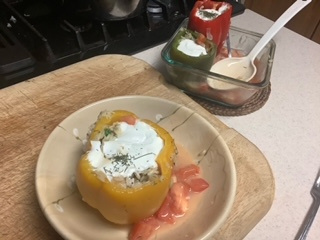
I love bell peppers for a snack or a meal and this is a great way to cook them up. I got this recipe from an old cookbook that my mom bought at the library. The cookbook series is called “Foods of the World”. It’s a series of cookbooks published in the 1968-1970’s timeframe and we have 6 books from the series. The “Foods of the World” series had 27 cookbooks and was published by Time Life Books. They started in 1968 and continued into the late 1970’s. The cookbooks represent many different countries and foods around the world.
Individual volumes were written by well-known experts in various cuisines and included significant contemporary food. Writers like Julia Child, James Beard and Pierre Franey were contributors and were all overseen by Michael Field, who died before the series was complete. Each cookbook had recipes from different countries. The ones I have are The Cooking of Germany, Pacific and Southeast Asia Cooking, Middle Eastern Cooking, The Cooking of the British Isles, Cooking of Provincial France, and A Quintet of Cuisines.
This recipe for stuffed bell peppers comes from the last one. If you want one of these books yourself, they are pretty widespread so you could probably get your hands on one easily for like 20 dollars or so. The covers have a big photo with food you can find in the book or ingredients that you will be using. I’m not sure how many were printed. I am sure that there were quite a few considering they have 27 cookbooks, and it is not too hard to find at least some of them for sale.
Some of the more common ones I’ve seen for sale are the Germany and the British Isles cooking books. Please remember if you cook a recipe for one of these cookbook’s that they are old recipes. So, there might be some ingredients or items in the instructions that you may not know of or have. For this week’s recipe I did edit it so it would work for modern kitchens. This warning is more just to let you know edits may be required for most old recipes.
You can find some fun recipes in old cookbooks that’s why me and my mom love them! They’re old and fun, like a peek into the past, it’s even better when there’s some photos to look at – a remanence of times long ago.
I hope you enjoy this recipe and when you have a chance and find an old cookbook, take a look through it. See what old recipes you can find and try them out if you think they’re interesting and just enjoy!
Ingredients:
- large bell peppers (without the seeds)
- 1 tablespoon 1 1/2 teaspoons salt
- 1 cup of rice (white or brown, your choice, but know that brown rice takes a bit longer to cook)
- 5 tablespoons of butter
- 1 cup plus 2 tablespoons of freshly chopped onion
- 1/4 cup of freshly cut parsley
- 2 tablespoons freshly cut fennel (fennel is the leaf part of the plant not the seed)
- Pepper to taste
- 1 egg lightly beaten
- 1 tablespoon of flour
- 1/2 cup of chicken stock
- 4 tomatoes, chopped
- 6 tablespoons of sour cream
Instructions:
- Preheat oven to 350 or 375 for high elevation. Place the cored-out peppers into a pot with boiling water, enough to cover them completely and boil for 2 to 3 minutes. After 2 to 3 minutes covering the pot, remove it from the heat and set it aside for five minutes. With tongs or a slotted spoon (if you don’t have either of those two forks work fine), carefully remove the peppers from the water and then place them on paper towels to drain.
- Bring water with 1 tablespoon of salt to boil in a saucepan, pour in the rice and bring back to a boil. Cover for 10 minutes then drain the rice. Set it aside.
- In a heavy skillet, melt 3 tablespoons of butter over medium heat. Once melted, add in one cup of onions. Cook them, stirring frequently until they are clear or light brown. Careful not to burn. Remove the skillet from the heat and stir in the rice, 2 tablespoons of parsley, the fennel, 1 teaspoon of salt and a few grindings of pepper.
- When all the ingredients are thoroughly mixed, cool to room temperature then stir in the egg. Set aside. Melt the remaining 2 tablespoons of butter over medium heat adding the remaining 2 tablespoons of onion and fry for 2 to 3 minutes. Then add the flour and mix thoroughly, pour in the stock, and stir consistently with a whisk or spoon. Cook over high heat until the sauce comes to a boil. Reduce to a low heat and simmer for a few minutes stirring in the tomatoes and the remaining salt, then remove from the heat. If needed, you can add a bit more chicken stock or take it off the burner sooner.
- In a casserole dish, put the peppers in and stuff them with the rice mix. Add the sauce around them in the peppers with a bit of sour cream and parsley (yes before you bake them). Bake for about 30 minutes and serve while still warm.
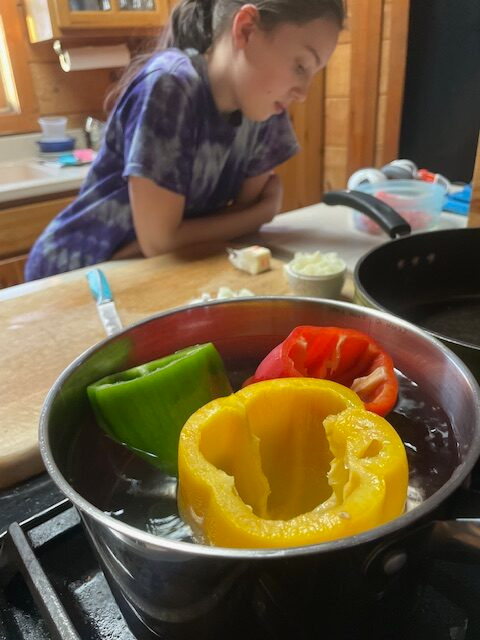
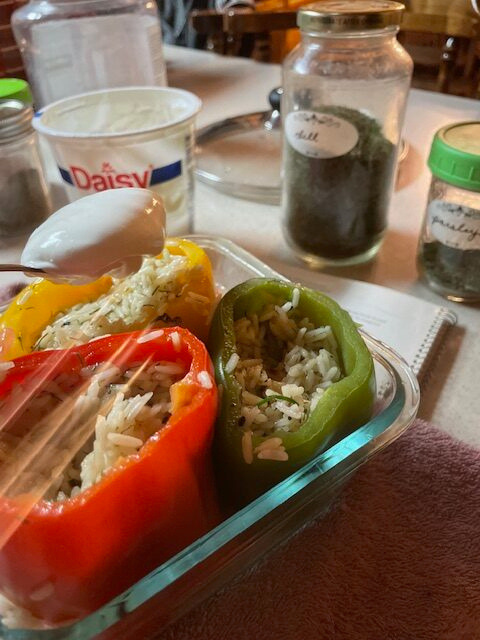

Gnocchi and Pesto Sauce
Posted March 30, 2025
Gnocchi is a great way to use extra potatoes, while not having to have all the potato dishes taste too similar. The dish also gives you a mixed-up texture unlike mashed potatoes or baked potatoes. It’s not really soft or a little mushy and it’s also not like pan fried potatoes where they’re crispy but maybe a bit dry. These are crispy on the outside, soft on the inside and refreshing.
You can do it two different ways; one way is where you just cook it and that’s it. Add some sauce and you’re done. The second way is when you cook it and then pan fry it to give it a light golden color and slight crunch plus a buttery flavor. That is how I prefer to make and eat it!
Since this is made in batches, not all of the gnocchi will rise at the same time or cook at the same pace. That’s perfectly normal and when that happens, just scoop out the cooked gnocchi and just set it to the side to eat it. It can take some time to get through the whole batch so, I’d suggest serving it as soon as you have enough for someone to eat. That way when you’re cooking the second batch two people or so have the first batch in their bowls eating it up. This way everyone also gets to eat it when it’s nice and hot. Not that these are bad when they’re cold, but they’re not quite as tasty. If you reheat these, I suggest reheating them by passing them in a pan with a bit of oil, be careful not to burn them though because when you reheat them, they are more likely to burn.
My favorite pasta sauce to have is pesto with fresh herbs. I have an even better one than this one somewhere that I got from a cooking class with CKC or Cultured Kids Cuisine. I wasn’t able to find it though, but if I did find it, I would’ve added it. Maybe in a future recipe! That special pesto recipe I got from a chef, and it also had mint, +not just basil. It was really good!
If you have left over gnocchi that you haven’t cooked yet and you want to save for it for later, I would freeze it. That way it keeps its shape and stays fresh. If you have left over gnocchi that is already cooked though just put it in the fridge and eat it soon. I’m not sure how long it could last in the freezer at least a couple of weeks though. This is a great quick recipe to make for dinner or lunch and if you make a big enough batch, you can have enough frozen for at least a week of meals. So essentially, it’s food prep.
I hope you have a good day, and I hope you enjoy this recipe and hopefully next time there’s a pesto dish, I have already found that special pesto recipe. Enjoy!
Gnocchi Ingredients:
· 1 pound of potatoes
· 1 cup of flour
· ½ teaspoon of salt
· 1 medium egg (room temperature)
Gnocchi Instructions:
· In a large pot boil the unpeeled potatoes until tender, remove from the pot, let cool, then remove the skin. Smash the potatoes with a fork making sure they are nice and smooth.
· Mix together the flour and salt, place on a flat surface or a bowl, make a well in the middle and add the potatoes and egg, mix together with your fingers to form a soft dough, it should not stick to your fingers. On a lightly floured surface, cut small amounts of dough to form ropes and cut into ¾ inch (2 cm) pieces, then slide each piece on a fork and squeeze a little (but not too hard). Sprinkle with a little bit of flour and toss, so they don’t stick together. Let the gnocchi rest for 20 minutes in the freezer before cooking. When you are ready to cook them, prepare a pot of boiling water. Don’t cook all of them in one go, take a few out at time and cook in batches. The batches are ready then the gnocchi is floating.
· If you like it with a bit of crunch, you can pan fry a batch gnocchi after it’s all done cooking with a bit of butter just heat it up in the pan until they are golden brown.
Pesto Alfredo Sauce Ingredients:
· 1 cup fresh basil leaves
· 1/2 cup pine nuts or walnuts, toasted
· 4 cloves of garlic
· 1/4 cup olive oil
· 1 teaspoon fresh ground black pepper
· 1/4 cup grated parmesan cheese
· 1 cup heavy cream
· Salt, to taste
Pesto Alfredo Sauce Instructions:
· Process basil, nuts, garlic, olive oil, and black pepper in food processor until smooth. Stir in grated parmesan and combine well.
· In a large sauté pan, over medium to high heat, heat heavy cream for several minutes until it starts to thicken considerably. Add pesto sauce and stir well to combine. Season with salt if needed.
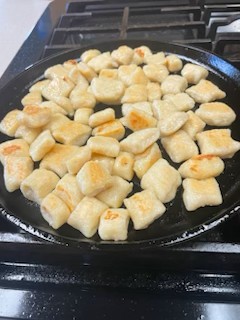
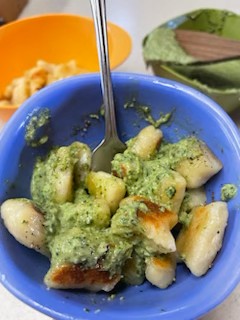

Key Lime Pie
Posted March 9, 2025
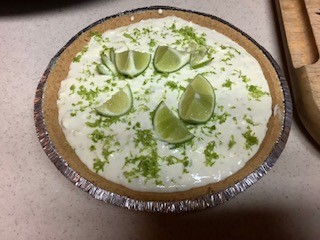
This key lime pie recipe is perfect for both Pi Day (March 14) and St. Patrick’s Day (March 17). With its light green color and golden looking crust, it looks like something a leprechaun would eat with some corn beef and cabbage. Pi Day is actually on the same day as White Day so it could be fun to make little tarts for White Day. Reference my macaroon recipe for more information on White Day. If you do make tarts, I’d suggest making them about the size of a cupcake that way it’s easy to carry around and eat and also you don’t have to buy lots of ingredients for a pie.
Did you know that Pi Day is for both the number and the dessert, which does make sense because you’re going to make pie for both of those days anyway so why not combine it into one and have a pie party? A pie party could be really fun! You could make different pies from around the world, or you could do a year of pie, doing a different pie for each different holiday.
If you want to make this recipe extra special for St. Patrick’s Day, you can make your own crust and make clovers out of lime slices and the pot of gold out of a lemon slice. I feel like this pie would fit beautifully with some corned beef and cabbage too. The pie has a tangy flavor while the soup has more of a rich flavor. If you want to learn more about corn beef and cabbage, you should check out my recipe from last year for St. Patrick’s Day. Both of these recipes aren’t the only two dishes you can make for St. Patrick’s Day you can also make something like soda bread or jacket potatoes which is my recipe for next week.
The good thing about this recipe is that it is a no bake pie, so you can make it any size you want easily! Because if it were a baked pie, you’d have to change the time and temperature to work better for the chosen size. It also makes this great for parties since you can make individual pies or one big one. If you want, you could also make this a lemon pie by changing the lime to a lemon. It might not work as well as a real lemon pie (I’m not sure I haven’t tried this method out yet) but I have a feeling it would be really good.
I hope you enjoy the recipe, and you have a magical and fun adventure for St. Patrick’s Day and plenty of pie for Pi Day. Enjoy!
Easy Key Lime Pie (no bake)
Ingredients:
- 16 ounces cream cheese (I used two 8-ounce blocks, softened at room temperature)
- 14 ounces sweetened condensed milk (1 can)
- 1/3 cup lime juice (2 large limes was enough for me, but get some extras just in case)
- Zest of 1 lime divided (leave 1/3 for garnish)
- Graham cracker crust (10-inch store bought) If you want, you can make your own crust to make it pop.
Instructions
- Add softened cream cheese, sweetened condensed milk, lime juice and 2/3 of the lime zest to a large mixing bowl, and beat on high until smooth and creamy (about 4 minutes).
- Transfer to a graham cracker crust.
- Sprinkle reserved lime zest in top, and refrigerate until filling is set, about 3 to 4 hours.
- Serve chilled, and garnish with extra lime slices, if desired
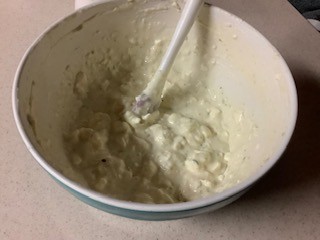
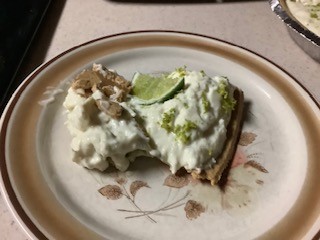

Coffee Jelly
Posted March 2, 2025
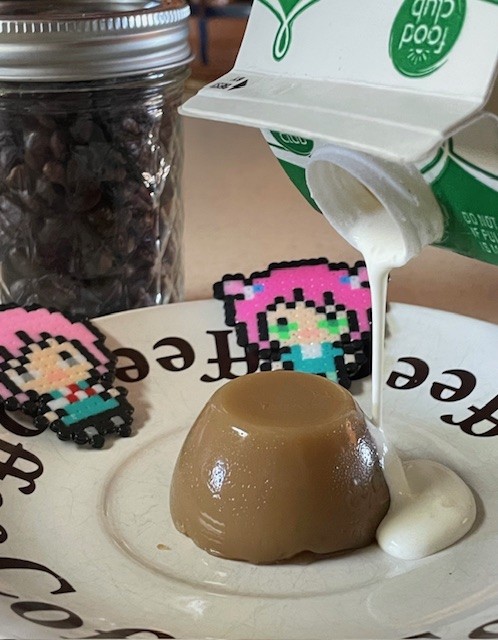
I don’t really like coffee, but despite that, even I wanted to take a crack at this historical dessert not very well known outside of Japan. Other than the handful of people I’ve met that have had this dessert, popular in cities with a large Asian-American population, most Americans haven’t tried coffee jelly, or even heard about it! In fact, I didn’t hear about it until a year or two ago, and that was from an anime (The Disastrous Life of Saiki K) where the main character’s favorite dessert is coffee jelly! If you have the time to give it a watch, then I would totally recommend doing so—though be warned that only the first season is dubbed in English. However, all three seasons do have subtitles in English, so if you don’t mind reading you can follow them all. I will also warn you that it can get pretty weird at times.
The cast of characters are a funny and charming group, and all quite different from each other. First there is Aaron, who used to be in a gang and quit that life, who’s now trying to have a peaceful high school experience and not succeeding very well. Then in contrast there is Teruhashi, the most popular and beautiful girl in school. Almost everyone sees her fall in love with her, either wanting to date her or at least be friends! There are lots of other charming secondary characters, but what ties the main plot of the show together is Suki K. The problem is that Saiki just wants to be a normal high school student and can’t because he has psychic powers. Throughout the show his friends get into antics, and he has to use his unique abilities to help. Saki pretends to be too cool and acts as if he doesn’t really like them, but I’m quite sure that he secretly does—even if they annoy him a lot of the time!
Part of what helps Saki keep his cool is his coffee jelly breaks. On the surface, the idea of coffee jelly is certainly off-putting. This coffee jelly is not really jelly like you’d put on a peanut butter and jelly sandwich, though. It’s jelly like 1950s housewives made Jello jellies: more like a gummy, but not quite as stiff. The key to this is the gelatin, and with it, you can make a ton of different flavors, from sweet to savory. I haven’t tried to make any other ones yet, but I’m excited to keep experimenting with the technique. I was asked by my mom to cater some of these later this spring, and I think a cherry flavored, candies cherry bloom jelly will be fun to put together.
While I probably will eventually share that recipe, in the meantime I hope you enjoy this coffee jelly. While you do, I think you should give The Disastrous Life of Saiki K. a try too.
Enjoy!
Coffee Jelly Ingredients
- 2 tablespoons unflavored gelatin powder
- ½ cup water to bloom the gelatin (cold is best)
- 2 cups of water (room temperature is fine)
- 2 tbsp instant coffee – (can adjust according to your preference)
- 3 tbsp sugar or according to your preference (can substitute with any sweetener of your choice)
Instructions
BLOOM THE GELATIN
This is a super important step so don’t miss out on it!
- Add unflavored gelatin powder to a bowl of ½ cup cold water, stir it once and leave it to bloom for about 10 minutes. Make sure you use only cold water.
- We can go ahead and make our coffee while the gelatin blooms.
MAKE THE COFFEE
Let’s make some nice hot coffee!
- Over medium-high heat, heat 2 cups of water in a saucepan.
- Once the water comes to a soft gentle boil (it doesn’t have to reach a rolling boil), reduce to medium heat.
- Add 2 tbsp instant coffee powder and 3 tbsp sugar to the hot water. A regular cup of strong coffee could work also instead of the instant coffee.
- Stir the hot coffee (I use a small whisk, makes things easy!) until the sugar has dissolved completely and everything has mixed together really well.
- Now turn off the heat and let the hot coffee stay in the saucepan.
MIX THE COFFEE AND GELATIN TOGETHER
- Wait for your hot coffee to cool a little for a minute or two. You don’t need to wait a lot; the coffee doesn’t need to cool down completely. Just wait until it’s not super-hot anymore.
- Now add in the bloomed gelatin (only once the 10 minutes of blooming is done!), add slowly in parts, while stirring the coffee gelatin mixture with a whisk. Stir gently so you don’t get too many bubbles in your coffee gelatin mix.
- Once you’re done adding the entire bloomed gelatin to the coffee, give everything a gentle stir using a whisk or a spoon until all that gelatin has mixed well with the coffee.
- Wait for the coffee gelatin mixture to cool down just a little more, no need to wait until it reaches room temperature, just so it’s safe enough to pour into your molds or whatever you’re using to set your coffee Jello in.
- Now you need to make your mind up on what you’d like to pour your coffee gelatin mix into. Here are a few ways you can enjoy your coffee jelly to help make your mind up on what to pour your coffee gelatin mix into:
- 1) You can pour your coffee Jello mixture into different-shaped silicone molds and get the prettiest shaped Jello or even cupcake molds – use molds you like!
- 2) You can use pretty serving bowls or glasses, let the coffee Jello set in there and serve it like that or super easily with some condensed milk cream on top.
- 3) You can pour your coffee gelatin mix into a glass tray and can slice your coffee Jello once it’s set into cubes and serve it mixed with the condensed milk cream – pour your coffee gelatin mixture into a glass tray you prefer. You can switch the size of your glass tray depending on how thick or thin you want your coffee Jello cubes to be. The smaller the tray, the thicker your Jello cubes, the bigger the tray, the thinner!
- After you’ve poured your coffee gelatin mixture into whatever you prefer, you may notice a few bubbles. If these bubbles are bothering you, you can always pop them with a toothpick or scoop them out using a spoon.
- Keep your coffee gelatin mix in the fridge and wait for it to become a delicious Jello! You can cover it with a plastic wrap too if you want.
- It’ll take about 2 to 4 hours for your coffee Jello to set. This depends on the brand of gelatin you’re using and your fridge

Macaroons
Posted February 15, 2025

Hi, I hope everyone had a great Valentine’s Day and got to spend time with your loved ones, whomever that be – friends, family, romantic partner or even a pet. If you got something for Valentine’s Day from someone you care about and you want to give them something back, why not make these macaroons? Of course you could give them to the person anytime, but I personally suggest giving them for White Day (that is what the holiday was originally called).
White Day is a holiday one month after Valentine’s Day on March 14, when people give reciprocal gifts to those who gave them gifts on Valentine’s Day. It began in Japan in 1978. Its observance has spread to several other East Asian nations like China, Taiwan, South Korea, and other countries worldwide.
I think it’s a sweet holiday where you can give something back to the people that gave you something and it’s also a fun way where you can be creative in what you’re making. You could make something by hand like knitting, crocheting, or making cards. You could also do something digitally with coding by making a design and printing it.
You can also bake something. I would go with something like bread or cookies if you’re going to give it out to a bunch of people, but if you’re going to have a small party or gathering, I go with something more like a cake or trifle. Bread is pretty easy. You can make a batch of dough and then separate it into a bunch of different tiny loaves and then just bake them. Similar to cookies you make the dough you put it on the tray and then you bake it. These macaroon cookies are a bit tricky. You don’t want to over or under mix the batter and you want to make sure that you let them cool properly before adding the filling.
The day was originally called Marshmallow Day and started when a marshmallow company launched a campaign in 1965 to encourage men to give marshmallows to women in return for chocolates received on Valentine’s Day. The campaign was based on the idea that it was unfair for men not to give gifts in return. The name was later changed to White Day to be more inclusive and reference the fluffy marshmallow roots.
White Day gets its name from white gifts that are traditionally given on this day. The color, white symbolizes purity and sincerity in the Japanese culture. The “sanbai gaeshi” concept suggests that a man’s gift on White Day should be two to three times the value of what he received on Valentine’s Day. Gifts that are commonly given on White Day can include white chocolate marshmallow, jewelry, lingerie, or other tokens of affection. Though it is up to you to decide what to give.
I hope you enjoy this recipe, and I hope you have a good day. Note, my plating picture shows mochi in the middle for comparison, surrounded by my delicious macaron cookies. Enjoy!
French Macarons
Ingredients
- 100g egg whites (usually between 3–4 large egg whites)
- 1/4 teaspoon (1g) cream of tartar or lemon/lime juice, (which I used).
- 1/2 teaspoon extract such as vanilla, almond, coconut, etc. (optional). I used elderberry syrup as my extract.
- 80g superfine sugar (aka caster sugar) Caster sugar falls between granulated (regular) sugar and powdered (confectioner’s) sugar when it comes to fineness.
- 1–2 drops gel food coloring (optional)
- 125g almond flour (roughly 28 grams to an ounce)
- 125g confectioner’s sugar
- Desired macaron filling(s) I used elderberry jam for mine. Try blackberry jam, peanut butter, or even cream cheese frosting as your filling.
Instructions
- Wipe down a large glass or metal mixing bowl with lemon juice or vinegar. Add egg whites. cover and refrigerate for 24 hours, then bring to room temperature.
- Line 3 large baking sheets with silicone baking mats or parchment paper. Set aside.
- Add cream of tartar and extract (if using) to egg whites. Using a handheld mixer or stand mixer fitted with a whisk attachment, beat together on medium speed until very soft peaks form. This takes a few minutes of beating. At first the egg white and cream of tartar mixture will be foamy, then the bubbles will begin to tighten, and the beaters will leave tracks as the egg whites build volume. Once they begin leaving tracks, you likely have soft peaks. Stop beating. Add about 1/3 of the superfine sugar. Beat at a medium-high speed for 5 seconds, then with the mixer continuing to run, add another 1/3 of the sugar. Beat for 5 seconds, then with the mixer continuing to run, add the remaining sugar. Beat at a medium-high speed until stiff glossy peaks form. This means the whites have stiff, smooth, and sharp points in the bowl or on the lifted whisk attachment/beaters. Stiff peaks do not droop down. You can turn the bowl upside down and the egg whites will not move or spill out. Using a rubber spatula, slowly and gently fold the food coloring (if using) into the egg whites.
- Sift the almond flour and confectioner’s sugar together in a large glass or metal mixing bowl. Use a spoon to help work any larger pieces through the sieve. You don’t want to discard a lot of that because then you won’t have enough dry ingredients in the batter.
- Slowly fold the beaten egg whites into the almond flour mixture in 3 separate additions, folding until combined before adding the next addition. After you added all of the egg whites, pay very close attention to the consistency of your macaron batter. Continue folding the batter (which deflates air) until it thins out into the consistency of honey. What’s a more helpful cue is the figure 8 test. Drop the macaron batter off of your spatula in the form of a figure 8. The figure 8 should take no more than 10 seconds to sink back into itself. If it takes less, your batter is overmixed and is too thin. If it takes longer, continue slowly folding the batter to deflate more air, then perform the figure 8 test again. It’s best to go very slow so you don’t accidentally overmix.
- Spoon the macaron batter into a piping bag fitted with a medium round piping tip, such as Wilton 12, Wilton 1A, or even Ateco 806. The macaron batter is very drippy, so transferring to the piping bag can be messy.
- Hold the piping bag at a 90-degree angle over the baking sheet, pipe batter in 1.5 to 2-inch rounds about 1-2 inches apart on prepared baking sheets. I usually pipe little mounds. The piped macaron batter flattens out. Bang the pan a couple times on the counter to pop any air bubbles, then use a toothpick to pop any remaining air bubbles.
- Let the piped macarons sit out until they are dry and no longer tacky on top, usually 30-60 minutes. This time allows the top to firm up and form a skin, which helps the macarons rise up and form their trademark ruffly “feet.” Do not let them sit out for longer than they need to because they could begin to deflate.
- Meanwhile, preheat the oven to 325°F (163°C).
- Bake for 13 minutes. As the macaron shells bake, they should form feet. To test for doneness, lightly touch the top of a macaron with a spoon or your finger (careful, it’s hot). If the macaron seems wobbly, it’s not done and needs another 1-2 minutes. If it seems set, it’s done. Basically, bake until the macarons don’t move around when touched.
- let the shells cool on the baking sheet for 15 minutes, then transfer to a cooling rack to continue cooling. The macaron shells may stick to the parchment paper/baking sheet if you try to remove them too early. If this happens, let them cool on the baking sheet a little longer before removing.
- After cooling, the shells are ready to fill and sandwich together. I have plenty of suggestions for fillings. You can spread filling with a knife or pipe it using the same round tip you used for the macaron batter.
- You can eat right away or, as some professionals prefer, cover and refrigerate them for 12-24 hours so the macarons and flavors can mature. Bring it to room temperature before serving. (I usually just serve them right away!)
- Cover leftover macarons and refrigerate for up to 5 days.

Popcorn Balls
Posted February 8, 2025
It’s almost Valentine’s Day and what’s not love, these popcorn balls are a great idea to give out to your friends for Valentine’s Day or your special Valentine, or just to make in general.
You could make these and enjoy them on a movie night with all your friends or somebody special. This is the perfect snack for movie nights, and you can pair these with a lot of different things to eat, I would go with a milkshake though.
I also have some movie night suggestions for you to go with the popcorn balls. Suggestions come from my family and me, I hope you like them.
- Kike’s Delivery Service
- Atlantis
- Mad Max
- Braveheart
- Princess Diaries
I hope you enjoy Valentine’s Day and have a great day!
Ingredients
- 12 cups popped popcorn
- 1 cup white sugar
- ½ cup Karo light or dark corn syrup
- ¼ cup unsalted butter or margarine
- ½ teaspoon salt
- 1 teaspoon pure vanilla extract
- ½ teaspoon baking soda
Instructions:
- Preheat the oven to 300 degrees F (150 degrees C). Coat a large roasting pan with cooking spray.
- Add popcorn to the prepared roasting pan, place in oven until warm. Popcorn can also be warmed in a large microwave-safe bowl on high (100%) power for 1 to 2 minutes.
- Combine sugar, corn syrup, butter, and salt in a heavy 2-quart saucepan; bring to a boil over medium heat, stirring constantly. Boil for 2 minutes, continue to stir.
- Turn off the heat, stir in vanilla and baking soda; pour over warm popcorn, stirring until well coated. Cover hands with two plastic bags, coat bags lightly with cooking spray; shape mixture into twelve 3-inch popcorn balls, working quickly.
- Cool completely. Wrap individually in plastic wrap

One-Year Anniversary Animal Crossing New Horizons Cake

Published February 2, 2025.
Because this is the one-year anniversary of this food column I did go all out and make something extra special. What I decided on was this one-year anniversary cake from animal crossing new horizons. I loved the look of this cake, and I thought it would be perfect. Though it did take me a bit of time to settle on what cake to do exactly. I was thinking of making a Jell-O injection cake, it’s a cake where you set clear Jell-O and then inject it with colored Jell-O once it set, and you can make it look like flowers or whatever you want really.
It’s hard to believe that I’ve been writing these recipe articles for a year now! Some of my favorite times have been giving out recipes at the farmers market in our booth and getting to eat all the delicious food that I made over the past year. I hope that I get to make a lot more delicious food with you folks this year too. And I hope y’all enjoy them! If you have a chance sometime in the summer, you should check out our booth at the farmer’s market.
We usually have flowers and stuffed animals, seeds, and fruit/vegetables. We also sometimes have recipes printed out for people to grab if they wanted. The booth has a little bit of everything really with all of us putting out something we made or at least something we helped make. I hope you enjoy this recipe, and I hope you enjoy all the recipes in the future too.
Cake Ingredients:
- 3 and 2/3 cups flour
- 1 teaspoon salt
- 2 teaspoons of baking powder
- 3/4 teaspoons of baking soda
- 1 and 1/2 cups (340g) unsalted butter, softened to room temperature
- 2 cups (400g) granulated sugar
- 3 large eggs, plus 2 additional egg whites, at room temperature
- 1 tablespoon pure vanilla extract
- 1 and 1/2 cups milk, at room temperature
Vanilla Buttercream Ingredients:
- 3/4 cup unsalted butter, softened to room temperature
- 2 and 3/4 cups of confectioner’s sugar
- 2 tbsp plus 2 tsp whole milk or heavy cream
- 1 teaspoon pure vanilla extract
- 1/8 teaspoon salt
Cake Instructions:
- Preheat oven to 350°F (177°C). Grease two cake pans, one big 9-inch, and one small 6-inch.
- Whisk the flour, salt, baking powder, and baking soda together. Set aside.
- Using a handheld or stand mixer fitted with a paddle or whisk attachment, beat the butter and sugar together on high speed until smooth and creamy, about 3 minutes. Scrape down the sides and up the bottom of the bowl with a silicone spatula as needed. Beat in the 3 eggs, 2 egg whites, and vanilla extract on high speed until combined, for about 2 minutes. The mixture will look curdled as a result of the egg liquid and solid butter combining. Scrape down the sides and up the bottom of the bowl as needed. With the mixer on low speed, add the dry ingredients just until combined. With the mixer still running on low, pour in the milk and mix just until combined. You may need to whisk it all by hand to make sure there are no lumps at the bottom of the bowl. The batter will be thick.
- Pour batter evenly into the cake pans. Weigh them to ensure accuracy, if desired. Bake for around 23-26 minutes or until the cakes are baked through. To test for doneness, insert a toothpick into the center of the cake. If it comes out clean, it’s done. Allow cakes to cool completely in the pans, setting them on a wire cooling rack. The cakes must be completely cool before frosting and assembling.
- Making the Frosting: In a large bowl using a handheld mixer or stand mixer fitted with a whisk or paddle attachment, beat the butter on medium speed until creamy, about 2 minutes. Add confectioners’ sugar, milk, vanilla extract, and salt with the mixer running on low. Increase to high speed and beat for 2 minutes. Add more confectioners’ sugar if frosting is too thin, more milk if frosting is too thick, or an extra pinch of salt if the frosting is too sweet.
Sugar Cookies and Sugar Cookie Frosting
Sugar Cookies Ingredients:
- 1 cup unsalted butter softened
- 1 cup granulated sugar
- 1 ½ teaspoons vanilla extract
- 1 large egg
- 2 ½ cups (315 g) all-purpose flour
- ¾ teaspoon baking powder
- ¾ teaspoon table salt
Royal Icing Ingredients:
- 3 egg whites
- 1 pound confectioner’s sugar (450g)
- 1 teaspoon vanilla extract
Sugar Cookie Instructions:
- Combine butter and sugar in the bowl of a stand mixer (or in a large bowl and use an electric hand mixer) and beat until creamy and well-combined.
- Add egg and vanilla extract and beat until completely combined.
- In a separate, medium-sized bowl, whisk together flour, baking powder, and salt.
- Gradually stir dry ingredients into the wet ingredients until the dough is smooth and completely combined.
- Lay out a large piece of plastic wrap and transfer approximately half of the dough onto the wrap (dough will be quite sticky at this point, that’s OK!).
- Cover the dough with clear wrap or wax paper and mold into a flat disk. Wrap tightly. Repeat with remaining cookie dough in another piece of clear wrap. Transfer the dough to the refrigerator and chill for at least 2-3 hours and up to 5 days.
- Once the dough has finished chilling, preheat oven to 350F (175C) and line a baking sheet with parchment paper (alternatively bake cookies directly on an ungreased baking sheet). Set aside.
- Generously dust a clean surface with flour and place one chilled cookie dough disk onto the surface. Lightly flour the dough and roll out to ⅛” (for thinner, crispier cookies) or ¼” (for thicker, softer cookies). Add additional flour as needed both on top of and beneath the dough so that it doesn’t stick.
Note: if the dough is cracking as you roll it, let it sit at room temperature for about 10-15 minutes to soften before attempting again.
- Use cookie cutters to cut out shapes and use a spatula to transfer shapes to prepared baking sheet, spacing at least 1″ apart. If you are not intending to decorate your cookies with icing, you can decorate them with sanding sugar at this point before you bake them.
- Bake on 350F (175C) for 8-10 minutes (this is for cookies that are approximately 3″ [7.6cm]; note that smaller cookies will need less time, and larger cookies will need more), or until edges just begin to turn lightly golden brown.
- Allow cookies to cool completely on cookie sheets before decorating them.
Royal Icing Instructions:
- In the bowl of a stand mixer or large mixing bowl, beat egg whites on medium-low speed until frothy, about 1 minute.
- With the mixer on low speed, slowly add confectioners’ sugar and vanilla.
- Once fully incorporated, increase speed to medium-high and beat until stiff, shiny peaks form.
- Divide icing among small bowls, and dye with gel food coloring if desired. Keep any icing that isn’t being immediately used covered with plastic wrap as it dries out very quickly. Transfer to piping bags and decorate cookies.
Marshmallow Bushes Ingredients:
- One bag of marshmallows
- One bag of pistachios
Instructions:
- Take your pistachios and once they are shelled chopped them up finally.
- Then melt the marshmallows. You can either do this in the microwave or on the stove top. The stove will create softer bushes, and the microwave will make harder ones.
- If you make the marshmallows in the microwave, they will puff up, that is normal. Do not be afraid. They will puff up a lot though so make sure you get a big enough bowl! You will also want to melt them in batches if you do it in the microwave.
- Once the marshmallows are melted mix in the chopped pistachios, stir the pistachios in until combined, and then use a spoon to take some marshmallow and shape it into the desired bush shape.
Whip Cream Ingredients:
- Cream (as desired)
- Sugar (as desired for sweetness)
Instructions:
- In a magic bullet combine the cream and sugar and just blend it until it’s all whip cream like.
- You can also do this by hand, but it takes way longer, and I just use the magic bullet.
Decorating the Cake:
- Once the cakes are finished baking (one big and one small) cut each one in half and spread whip cream on cut halves then put a layer of fruit and then more whip cream. Put the two halves of each cake back together.
- Then pipe the green frosting onto the cakes to make it look like grass. Once that’s done put the smaller cake on top and add more green frosting to make it look like grass again. Don’t forget to add piped frosting, lining along the edge.
- Once that is finished, you want to decorate the cookies, there are four main shapes of cookies: a pine tree, an apple tree, a leaf thingy (circle) and then a sign (half circle).
- Once those are decorated you can prop them up against the cake anywhere you want.
- Stick a candle on the top with some whipped cream next to it, put some marshmallow bushes down around the cake and you’re done!
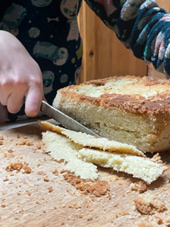
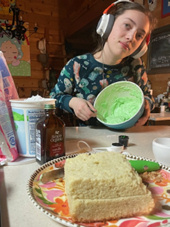


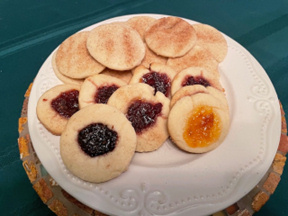

Chinese New Year Dumplings
Posted January 26, 2025

Chinese New Year is here, and this year it is from January 29th to February 12th. This year is the year of the snake. What is better to serve for Chinese New Year than dumplings, fried to perfection, with a slightly salty sauce! You could also have some miso soup with your dumplings or something like fish, or crab puffs. These are all good options, but my favorite for sure is the dumplings. This recipe, kind of like the miso soup, originally didn’t have any carrots in it, but I do like having carrots in it. Ok, I just really like carrots. I think they’re super tasty and added a different flavor to the mix.
For Chinese New Year’s (or Lunar New Year, as it’s known everywhere other than China!) people usually celebrate by decorating with red colors and paper cutting decorations and talismans. Those celebrating wear new red clothes, celebrate with family for a large reunion dinner and give red envelopes with money in it to younger generations.
Some people also set off fireworks while eating delicious and traditional foods. This is all aimed at welcoming good luck and prosperity for the New Year. It’s a time to honor ancestors and is marked by festivals, parades, and dances. Red is considered a lucky color, so homes are adorned with red lantern paper cutting, couplets (with auspicious wishes) on doors, and other red decorations. It’s also why people typically wear red, and their new clothes are to signify a fresh start for the New Year.
Another thing that is done for good luck is giving red envelopes containing money to little kids as a blessing of good luck and setting off fireworks is a blessing to ward off evil spirits and bring good fortune. I was born somewhere with a large population of Asian-American people, and was lucky to get more than a few red envelopes from neighbors! But one of my very favorite parts about Chinese New Year is getting to see the dances. They’re always so pretty with a giant dragon—or two! –dancing around.
I also love all the food. My favorite food is probably the dumplings. I like to fry them up until they are crispy on the bottom and then steam them until they are see through. Then everyone enjoys them when they’re still nice and fresh. For this year’s dumplings we used local Big River ground bison instead of the traditional ground pork.
I hope everyone has a good Lunar New Year and I hope this year is filled with prosperity and good luck. Enjoy!
Chinese Dumpling Ingredients
For the Dumplings
- 1/2 medium green cabbage, roughly chopped
- 1/2 cup carrots
- Salt to taste
- 1/2 teaspoon grated ginger
- 1 large clove garlic, finely chopped
- 1/2 cup finely chopped scallions
- 1/2 cup chopped garlic chives (optional)
- 1 pound ground pork
- 1/4 cup of soy sauce
- 1/2 teaspoon of toasted sesame oil
- Freshly ground black pepper
- 1 package dumpling wrappers
- 2 tablespoons vegetable oil
For the Dipping Sauce
- 1/4 cup of soy sauce
- 3 tablespoons rice vinegar
- 1 teaspoon thinly sliced scallion white
- 1 pinch of toasted sesame seeds
Directions
Transfer the dumplings to a plate and serve with the dipping sauce.
The Filling: Place the cabbage in a food processor, add 1/2 teaspoon salt, and pulse until finely chopped but not puréed. Wrap the chopped cabbage in a clean kitchen towel and squeeze to remove juices, then transfer to a large bowl. Add ginger, garlic, scallions, and, if desired, garlic chives. Add the pork and season with 1/4 cup of soy sauce, sesame oil, salt, and pepper. Mix together by hand. Taste the filling by poaching or frying a small amount and adjust seasonings to taste.
The Sauce: To prepare the dipping sauce, combine soy sauce, rice vinegar, scallions, and toasted sesame seeds in a small bowl.
To Wrap: Place 1 tablespoon of filling onto the center of a dumpling wrapper. Wet the wrapper’s edges, then fold in half to form a taco-like shape. Make a pleat on the side facing you about 20 degrees from the apex of the half-circle and seal with your fingers to the back of the skin. Repeat on the other quarter, in mirror fashion, and seal the dumpling completely, trying to eliminate any air pockets. Repeat until all filling is used.
To Pan Fry: Heat oil in a large, nonstick pan over high heat. Add the dumplings in one layer so that they do not overlap. Add water to come halfway up the dumplings and cover the pan. Reduce the heat to medium-high and cook until all the water is evaporated, and the bottoms are browned and crispy, about 10 minutes. Alternatively, the dumplings can be steamed until cooked through, about 5 minutes in a steam basket.



Miso Soup
Posted January 19, 2025
Miso soup holds a special place in my heart—it’s not just a soup; it’s warm memories when it’s cold outside! For me, the combination of the rich umami from the miso and the texture of the tofu is absolute perfection. But one of my favorite things to add to miso soup is carrots! I know, I know—many recipes don’t even call for them, but they add such a lovely pop of color and a little extra bite to the soft textures and otherwise sort of bland green and white colors. Plus, they just look so pretty floating in the soup, don’t they? Of course, if you’re not into carrots, feel free to leave them out!
Miso soup is so light and comforting, it makes it the perfect pairing for something heartier—the combo just feels cozy and satisfying, without being too heavy. If you’re a vegetarian, it’s also easy enough to swap out the dashi (or broth) base from bonito (tuna flakes) to dried mushrooms. It’s also an easy enough swap if you don’t have flakey dried tuna on hand—we are far from an ocean, but mushrooms grow pretty well in Raton, and they dry even better for long term use!
So, with Lunar New Year around the corner, what better way to celebrate than with a bowl of this awesome soup? This Lunar New Year is the Year of the Snake, and if you’re into astrology or just love the rich stories behind it, lunar or Chinese New Year is such a fun time to reflect on the personality traits of each zodiac animal. The zodiac has a fascinating backstory that involves the animals racing across a river to determine which animal would represent which years in the cycle. I’m a Rabbit (yay!), and the next Year of the Rabbit won’t roll around until 2035—meaning I’ll be 24, which sounds both exciting and a little surreal! But beyond the fun of predicting personalities based on your zodiac, it’s just nice to pause and think about the year ahead, especially with family and food as the center of celebration.
So, whether you’re making this for a cozy evening at home or a celebration, I hope you enjoy the recipe as much as I do! And don’t forget to eat it with something tasty like rice and seaweed, onigiri or dumplings—trust me, it’ll make the experience even more special!
Miso Soup Ingredients
For the Dashi
8 cups water
1 piece kombu (dried kelp/seaweed)
2 cups dried bonito (dry tuna flakes) or 1/2 cup mushrooms, ground into a powder
For the Miso Soup
1 cup carrots, sliced
14 oz soft/silken tofu
1/2 cup miso
2 tbsp dried seaweed
1 cup green onions/scallions, chopped
Instructions
- Making the Dashi (can be done in advance): Start by adding the water and seaweed to a medium saucepan. If you’ve got the time, soak the kombu for 30 minutes—it’s worth it for the extra depth of flavor! One rule I always follow: never wash kombu and don’t remove the white powdery substance—it’s packed with umami, or savory flavor! Bring the water to a gentle boil over medium-low heat (about 10 minutes). This is Kombu Dashi.
- If you’re not vegan/vegetarian, add the fish flakes and bring it back to a boil. Once boiling, reduce the heat and simmer for about 30 seconds. Now you’ve got Awase Dashi! You can store this in the fridge for about 3-5 days or freeze it for up to two weeks.
- If you are looking for a vegan option, put 1/2 cup of dried mushrooms into a blender—shiitake are good, but so are the oyster mushrooms my uncle grows! Blend well. Add the kombu dashi and bring back to a boil. Once boiling, reduce the heat and simmer for about 30 seconds. This traditionally is called shiitake dashi, or mushroom dashi.
Making the Miso Soup:
- Add your dashi to a saucepan and bring it to a gentle simmer. Toss in your carrots and cook for about five minutes until they’re tender but still have a bit of bite—unless you really want mushy carrots!
- Cut your tofu into 1/2-inch cubes—don’t worry if it’s a little messy, just be careful with your knife. If you’re feeling adventurous, you can cut the tofu right in your palm (a common practice in Japan!), but I recommend a cutting board if you’re new to this. Add the tofu to the soup.
- Then, throw in the dried seaweed and chopped green onions, and cook for another five minutes. Turn off the heat and add the miso right before serving—don’t boil the miso! It’ll lose all its lovely flavor and aroma if you do.
- Serve hot! Enjoy the soup, enjoy the season, and most of all—enjoy the year ahead!
The Chinese Zodiac Animals and Their Personalities:
The Chinese Zodiac is a 12-year cycle, and each year is associated with an animal, each with its own unique traits. Here’s a quick rundown of the order of the cycle and personalities of the animals:
Rat – Quick-witted, resourceful, versatile, and kind
Ox – Diligent, dependable, strong, and determinedTiger – Brave, confident, and competitiveRabbit – Quiet, elegant, kind, and responsible (that’s me!)
Dragon – Confident, intelligent, and enthusiastic
Snake – Enigmatic, intelligent, and wise
Horse – Animated, active, and energetic
Goat – Calm, gentle, and sympathetic
Monkey – Sharp, smart, and curious
Rooster – Observant, hardworking, and courageous
Dog – Lovely, honest, and prudent
Pig – Compassionate, generous, and diligent
These personalities are fun to think about, but just like astrology, they’re a little more playful than factual! For example, I’m a Rabbit, which feels pretty spot on for me, but my brother is a Goat—and a nine year old! Not quite as accurate! Still, it’s a fun tradition and something to look forward to each year!

Boba Drinks
Posted January 12, 2025
Boba is one of my favorite drinks! It is nice and refreshing to drink and can be made in a variety of flavors from tea to smoothies. The Boba pearls can also be purchased in a variety of sizes and flavors. There are small Boba pearls, big Boba pearls, popping Boba, jelly Boba, clear Boba, and many other varieties.
One can use any type of drink for the recipe, Boba tastes delicious with a wide variety of drinks. Try different flavors and figure out which one you like best!
Over the years, Boba has become extremely popular from its Instagram-worthy photos and delicious taste. It’s become a booming business. The flavors were previously made with cheap powders that could quickly be put together for a customer. The business is now more expensive with tons of different flavors and freshly grown tea leaves and flavor combinations one might see only in dreams. It has become a competitive business just trying to keep shops running. Even places like Starbucks sell Boba.
When we still lived in Arizona, there was a place that sold Boba close to our house. We sometimes went there to get some Boba or something to eat. The walls had beautiful paintings on them. People could even put up a painting or a sticker or something on them. It was always so pretty, and I loved going there. I have a lot of fun memories from there. The shop was called The Street, and it was just a cozy and nice spot to get a Boba or some Ramen before we went back home.
It’s still open to this day. It was also pretty close to the International Market, which has all sorts of amazing stuff, like mochi or sugarcane. I also loved going there and getting to see all the different kinds of fruits and vegetables. Some I’ve never seen before!
When it was close to the Lunar New Year, they’d have all of those decorations in the store, which was super cool, all the lanterns with the animal on them and every Lunar New Year theywould have a dragon dance with a big dragon, which was so cool to see.
I hope you enjoy this week’s recipe, and I hope I can keep doing this for a long time. Enjoy!
Boba Recipe
Ingredients:
- 2 cups Boba pearls
- ¼ cup brown sugar
- water
Instructions
- Fill a large pot (the Boba needs to be able to move around so they don’t stick together) about 1/2 to 2/3 full of water. Bring the water to a boil. Give it a stir and pour the Boba pearls in.
- They should float to the surface within the first 30-45 seconds. If they don’t float you may have a bad batch or you may not have allowed the water to boil all the way before adding the Boba pearls.
- Allow the Boba to cook for 10-12 minutes, stirring every so often.
- Remove the pot from the heat and place a lid on top. Allow the Boba to cook covered for an additional 2-3 minutes.
- Strain the Boba from the water and pour it into a bowl or other container. Add just enough cold water to cover the pearls. Stir in 1/4 cup brown sugar to sweeten the Boba. Allow it to cool before adding to drinks.

Latkes
Posted January 4, 2025
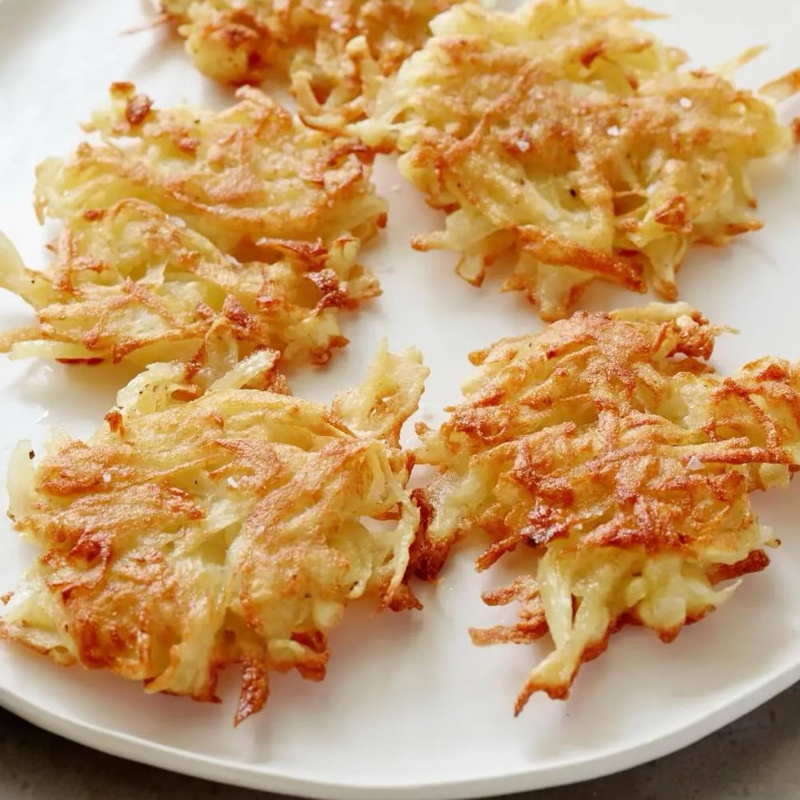
Hanukkah has passed and Latkes are a big part of it; however, Latkes are still delicious anytime of the year! They are commonly served with applesauce or sour cream.
I love making a mix of vegetables like carrots, potatoes, onions, and even sometimes sweet potatoes, basically whatever would taste good in it. Obviously, this is all up to you so feel free to tinker with the recipe. You can also call these potato pancakes.
In the story, The First Night of Hanukkah, the storyline goes like this…
It was the first night of Hanukkah and everyone was getting ready. Grandma was in the kitchen. Dad was helping make potato pancakes. Mom was setting the table and Molly was helping Uncle Dan polish the Menorah.
Uncle Dan said, when I was your age, “I helped my mother polish the Menorah .and now you’re helping me. It is a tradition that we are passing on. That is how it was and how it still is.” Molly wanted to know what else he remembered. “I always lit the candles,” Uncle Dan said. “But first my mother would tell me the story of Hanukkah.” Uncle Dan put Molly on his lap “Would you tell me the story?” asked Molly. “Sure” said Uncle Dan.
A long, long time ago there was a King his name was Antiochus, (you say it like this – An-TIE-uh-kuss). King Antiochus ruled over all the people of Israel. but the king had a hard heart. He made a law. Everyone in the land had to pray to all his Gods.
Now the Jews of Israel pray to only one God. They would not obey the King’s law. “We will keep praying to our God,” they said. “We will not pray too many gods” You can imagine. This made king Antiochus very mad. “If I catch you, praying to your one God, you will be killed.”
Then the King sent his army to the Jew’s Temple in Jerusalem. This was the most important place for the Jews to pray. The soldiers broke all the holy things in the Temple and put a statue of one of their gods inside, so the Jews could not worship there anymore.
This did not stop the Jews! There was a brave man named Mattathias, (you say it like this – MAT-uh-TY-yass). He lived in the village of Modin near Jerusalem. Mattathias and his five sons still prayed to one God. Other Jews heard about Mattathias’s family. From far and near they came to join them. They learned about the Jewish ways. The King also heard about Mattathias’s family. He heard about what Mattathias and the other Jews were doing. Breaking the law! Praying to one God! Following the Jewish ways! King Antiochus became even madder. He sent his army to Modin to kill the Jews.
The Jews of Modin were ready to fight! They were ready to protect their rights to be Jews. So, a long struggle began. On and on it went. For three years, the Jews fought the King’s army. Mattathias died, but his son Judah Maccabee became the leader.
Judah was a great fighter. Under him, the Jews fought long and hard. The King’s army was big. Even so, it could not win. Judah Macabee just would not give up. In the end, the King men gave up and left. What a great day! Judah led everyone to Jerusalem. Now they would take back their Temple! They would make it beautiful again. They would make it holy once more and the Jews would be able to pray there again.
Everyone went to work. They cleaned and polished, they got rid of the statue of the King’s God, they made a new altar and at last the temple was ready to open again. Special prayers were said then it was time to light the great menorah. But there was only a small jar of holy oil. It was all the Jews could find. The jar held enough oil for just one day. Still the light kept burning on for eight days! “It was a miracle” Uncle Dan said. “And since that time Jews had celebrated the holiday of Hanukkah. We used a special Hanukkah Menorah. It had a place for eight candles. There was also a place for the Shammash. That is the candle that lights the others. We light one candle on the first night of Hanukkah we light two on the second night, and so on.
On the last night, eight candles are lit. Eight nights to remind us of the miracle of the oil. And to remind us of the brave Judah Macabee and the Jews. And that’s the story of Hanukkah.” Uncle Dan said. Molly got down from his lap. “Just in time!” Grandma said. She put a plate of potato pancakes on the table. Dad put down the bowls of applesauce and sour cream.
Mom said, “now let’s light the Menorah”! Uncle Dan put one candle in the Menorah. He lit the Shammash. He handed it to Molly. Molly lit the first candle of the first night of Hanukkah. She said a prayer just like Uncle Dan had done when he was her age. A tradition being passed down, how it was, how it still is and how it will always be.
We also have another great book called Latkes with Grandma. Hope you enjoyed this recipe, and I hope you have a wonderful week. Enjoy!
Potato Latkes /Potato Pancakes
Ingredients:
- 3 medium russet potatoes, peeled
- 1 large egg, beaten, or more to taste
- 2 tablespoons all-purpose flour
- 1 tablespoon grated onion
- ½ teaspoon salt, or more to taste
- ¼ cup peanut oil for frying, or as needed
Directions
- Grate the potatoes and place shredded potatoes in a cheesecloth and wring, extracting as much moisture as possible.
- Measure 2 cups shredded, drained potatoes and place into a medium bowl; save any extra for another use. Add egg, flour, onion, and salt, and stir until well combined.
- Heat 1/4 inch of oil in a large, heavy-bottomed skillet over medium-high heat. Place a large spoonful of potato mixture into the hot oil, one at a time, pressing down on them to form ¼ to ½ inch-thick patties. Cook until golden brown, 4 to 5 minutes. Flip and repeat on the other side.
- Remove to a paper towel-lined plate to drain while you cook any remaining latkes. Serve hot.

Snowball Cookies
December 28, 2024
Happy 2025 everyone! Can you believe it’s almost been a whole year since I started this column. The first column was on February 4, 2024, pumpkin ravioli, and now it’s 2025! Time has flown by.
These are some of the fun things I did this year: having turkey lay her first eggs early in the year, starting this recipe column in February, going on a trip with Skateland to Denver, having my friends visit in June, getting to go to a convention, and doing sewing classes in September. So much has happened over the past year and I’m excited to see what next year brings. It’s also scary because you never know what’s in the future.
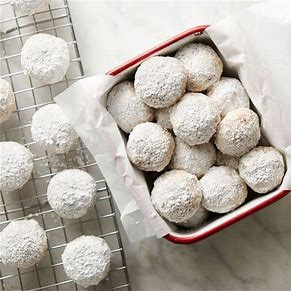
So, for now, let’s just celebrate the New Year with these mocktails and snowball cookies. Snowball cookies are super good, so I thought what better to pair it with then cocktails for the New Year!
We have the next couple of months planned out with fun and delicious recipes too for the New Year. I’m excited to do them all with you, and I hope you all enjoy them too!
I know some of them aren’t the most common to find here but they are really good recipes, and I really enjoy making them, eating them, and learning about the recipes and history of it from different videos while I’m working on the writing for the column.
I also enjoy sharing the food I make with people I like when I can. I bring some of it to Skateland and share it with my coworker and boss. It makes me happy to see that they enjoy it so much since I work so hard on it.
So happy New Year everyone and I hope you enjoyed this week’s recipe. Happy 2025 and I hope we have a good year!
Shirley Temple and Snowball Cookies
Ingredients
- 1 cup ginger ale or lemon-lime soda (8 ounces; 235ml)
- 2 tablespoons homemade or store-bought grenadine (1 ounce; 30ml)
- Maraschino cherries for serving
Fill a tall glass with ice. Pour soda over the ice. Using a spoon, gently stir grenadine into ginger ale until combined. Top with as many maraschino cherries as your little heart desires.
Snowball Cookies
Ingredients
- 1 cup (16 Tbsp; 226g) unsalted butter, softened to room temperature
- 3/4 cup (90g) confectioners’ sugar
- 2 teaspoons pure vanilla extract
- 2 and 1/4 cups (281g) all-purpose flour (spooned and leveled)
- 1/8 teaspoon salt (optional if salted butter is used instead)
- optional: 3/4 cup (100g) finely chopped and toasted pecans
Coating
- 1 and 1/4 cups (150g) confectioners’ sugar
Instructions
- In a large bowl using a handheld mixer or stand mixer fitted with a paddle attachment, beat the butter for 1 minute on medium speed until completely smooth and creamy. Add 3/4 cup confectioners’ sugar and beat on medium high speed until combined and creamy. Scrape down the sides and bottom of the bowl as needed. Next, beat in the vanilla extract on medium-high speed until combined. Switch to low speed and slowly add the flour and salt. The dough will look dry, and you may not think the flour will fully combine. Once all of the flour is added, turn the mixer up to high speed. The dough will come together. Finally, beat in the chopped pecans, if using.
- Cover the cookie dough tightly and chill in the refrigerator for at least 30 minutes and up to 3 days. If chilling for 3 plus hours, make sure you let the cookie dough sit at room temperature for at least 30 minutes before rolling into balls. The cookie dough will be very stiff after being in the refrigerator for that long.
- Preheat oven to 350°F (177°C). Line 2 large baking sheets with parchment paper or silicone baking mats. Set it aside. Pour the confectioners’ sugar needed for the coating into a shallow bowl.
- Scoop or roll 1 tablespoon (20g) of cookie dough per cookie. Roll into a ball and place on the baking sheets, at least 2 inches apart. Bake the cookies until golden brown on the bottom edges and just barely browned on top, about 15 minutes.
Coating: Allow the cookies to cool for 5 minutes on the baking sheet, then very gently roll them in the confectioners’ sugar to coat completely. Place the cookies on wire racks to cool completely. The confectioners’ sugar will melt a bit and get sticky; that’s ok. Once the cookies have completely cooled, roll in confectioners’ sugar again. This is when the sugar will really stick.

Gingerbread Recipe
December 25, 2024 by Madi Ryan
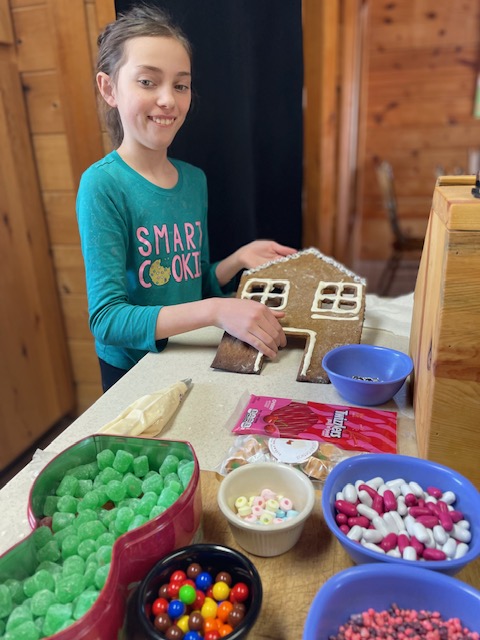
Every year for Christmas, my mom and I make a gingerbread house and cookies to give to our neighbors. We usually make gingerbread and chocolate chip cookies, plus one other type of cookie. This year we made gingerbread and chocolate chip cookies and lemon bars.
We give these to our neighbors and businesses in town like the library, post office, Heirloom Shop, Skateland and the firefighters. I Always love giving out delicious cookies we made with love and flour.
Do you know why Gingerbread cookies are shaped like people? It’s primarily because of Queen Elizabeth I of England, who helped with popularizing the practice of making gingerbread figures in the likeness of her court members and visiting dignitaries, thereby essentially creating “gingerbread men” as a form of culinary entertainment at royal feasts. This association with the human form stuck and became a tradition with gingerbread cookies.
Nowadays, we do even more fancy stuff than decorate our cookies, we make houses! We could make Christmas trees, castles, pyramids, or basically whatever we want out of the gingerbread. Making things as complicated or simple as desired.
For me we have specific cutouts that we use for the gingerbread house. We have a tree template and a template for each side of our house, including the roof. I love decorating gingerbread houses! It’s always so fun decorating with different candies and icing, like M&M’s, licorice, jelly beans, and Nerds.
You can buy gingerbread molds entirely made of metal or plastic. Old gingerbread molds were actually made of wood and carved by hand. I don’t know exactly how long these would take to make, but probably days and days depending on the size and how difficult the design is. A smaller one with a really complex design would probably be really difficult to make.
You can actually still find and buy some of these molds today. Depending upon what mold you get, the price obviously varies. I did find a listing on Amazon for a wooden one for seven dollars. This one may not be the best quality but if you really wanted to try one out you could probably also find them on Etsy or eBay.
Gingerbread is also prominent in fairytales like Hansel and Gretel and the Gingerbread Man book. And those are just fairytales! You can also find them in cozy mysteries like Gingerbread Cookie Murder by Joanne Fluke, Lesli Meier, and Laura Levine. This book has three different stories in it which is why it has three authors. The title story in the book Gingerbread Cookie Murder is a Hannah Swinson mystery and is one of my go to book series.
I won’t spoil the book for you, but I definitely think you should check it out! I hope you enjoy this week’s recipe, and I hope you check the book out. You can find it at our local library, on Overdrive or simply search for it online. Enjoy!
Gingerbread Cookies Ingredients
- 3 and 1/2 cups (440g) all-purpose flour
- 1 teaspoon baking soda
- 1/2 teaspoon salt
- 1 Tablespoon ground ginger (yes, 1 full Tablespoon!)
- 1 Tablespoon ground cinnamon
- 1/2 teaspoon ground allspice
- 1/2 teaspoon ground cloves
- 10 Tablespoons (142g) unsalted butter, softened to room temperature
- 3/4 cup (150g) packed light or dark brown sugar
- 2/3 cup (160ml; about 200g) unsulphured or dark molasses
- 1 large egg, at room temperature
- 1 teaspoon pure vanilla extract
Instructions:
- In a large bowl, whisk together the flour, baking soda, salt, ginger, cinnamon, allspice, and cloves. Set it aside.
- In another large bowl, using a handheld mixer or stand mixer fitted with a paddle attachment, beat the butter for 1 minute on medium speed until completely smooth and creamy. Add the brown sugar and molasses and beat on medium high speed until combined and creamy. Scrape down the sides and bottom of the bowl as needed. Next, beat in egg and vanilla on high speed for 2 full minutes. Scrape down the sides and bottom of the bowl as needed. The butter may separate but that’s ok.
- Add the flour mixture to the wet ingredients and beat on low speed until combined. The cookie dough will be quite thick and slightly sticky. Divide the dough in half and place each onto a large piece of plastic wrap. Wrap each up tightly and pat down to create a disc shape. Chill discs for at least 3 hours and up to 3 days. Chilling is mandatory for this cookie dough. I always chill mine overnight.
- Preheat the oven to 350°F (177°C). Line 2-3 large baking sheets with parchment paper or silicone baking mats. Set them aside.
- Remove 1 disc of chilled cookie dough from the refrigerator. Generously flour the work surface, as well as your hands and the rolling pin. Roll out disc until 1/4-inch thick. Tips for rolling—the dough may crack and be crumbly as you roll – what’s helpful is picking it up and rotating it as you go. Additionally, you can use your fingers to help meld the cracking edges back together. The first few rolls are always the hardest since the dough is so stiff, but re-rolling the scraps is much easier. Cut into shapes. Place shapes 1 inch apart on prepared baking sheets. Re-roll dough scraps until all the dough is shaped. Repeat with the remaining discs of dough.
- Bake cookies for about 9-10 minutes. If your cookie cutters are smaller than 4 inches, bake for about 8 minutes. If your cookie cutters are larger than 4 inches, bake for about 11 minutes. My oven has hot spots and yours may too, so be sure to rotate the pan once during baking time. Keep in mind that the longer the cookies bake, the harder and crunchier they’ll be. For soft gingerbread cookies, follow my suggested bake times.
- Allow cookies to cool for 5 minutes on the cookie sheet. Transfer to a cooling rack to cool completely. Once completely cool, decorate as desired.



Roasted Balsamic Winter Vegetables
Posted December 22, 2024
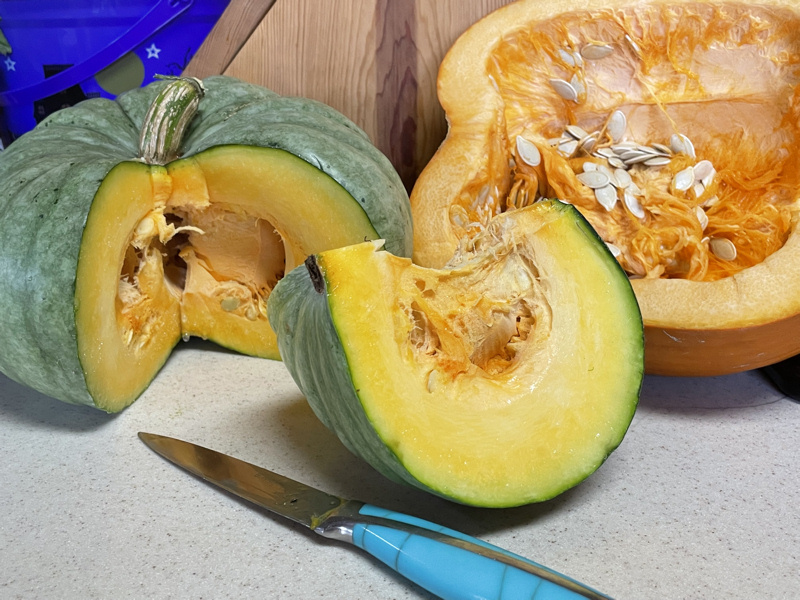
It’s really starting to get cold out and the last of our squash has been recently picked. Since our squash and pumpkins that we grow stay fresh for months, why not use it for roasted winter veggies with balsamic vinegar dressing, cooked to perfection and served with warm bread and butter.
I love having roasted veggies, no matter what type they are or what they’re in (unless it’s quinoa, you can’t pay me to touch it). Roasted winter squash is a quick and easy dish that you can prepare while watching a movie or between a round of sports games.
You can roast any kind of vegetables you want! Try adding some carrots, peppers, pumpkins, tomatoes, etc. You could even add some fruits like apples, pears, plums, and peaches, these are some that would be really good to roast up.
You could also change the vegetables depending on the season. In summer for example, you could do more fresh veggies and then make them into a soup after roasting them. Or try grilling them on a barbecue in the park.
Did you know that different colors of the same food can taste different and have different benefits just like food in many video games like in Animal Crossing!
Take a look at bell peppers, depending upon the color you can get different vitamins. Red bell peppers contain the most nutrients and vitamins, including more vitamin C and potassium than other colors. Red bell peppers are also high in lycopene, an antioxidant that may help fight cancer.
Green bell peppers contain lutein and zeaxanthin, which are important for eye health. Green bell peppers are harvested before they ripen, so they are less sweet and have less sugar and carbohydrates than red bell peppers. My favorite peppers are green peppers, and I like having them with cucumbers and cheese.
Yellow bell peppers contain violaxanthin and are high in vitamin C.
The nutrient and vitamin benefit doesn’t just count for peppers, it also counts for stuff like carrots, tomatoes, potatoes, and pumpkin, basically anything that has different natural colors. Just remember not to eat the leaves of the tomato plant (they are poisonous same with rhubarb). I hope you enjoy the recipe this week. I know I did, see you next week!
INGREDIENTS
Vegetables:
- 2 medium gold potatoes, peeled and cut into 1-inch cubes
- 2 medium red bell peppers, cut into 1-inch pieces
- 1 large, sweet potato, and cut into 1/2-inch pieces
- 1 medium red onion, cut into 1-inch chunks
- ½ medium butternut squash, peeled, seeds removed and cut into 1/2-inch pieces
Dressing:
- 3 tablespoons olive oil
- 2 tablespoons balsamic vinegar
- 2 tablespoons finely chopped fresh rosemary
- 1 teaspoon finely chopped fresh thyme
- 2 teaspoons coarse, kosher salt
- Pinch of black pepper
Instructions:
- Preheat the oven to 450 degrees F.
- Scatter the vegetables evenly on a half sheet pan. They should fill the pan in a single layer.
- In a small bowl, whisk together all the ingredients for the dressing. Drizzle the dressing over the vegetables and toss to coat evenly.
- Spread the vegetables into an even layer and bake for 35 to 40 minutes until tender and golden.
- Season to taste with additional salt and pepper, if needed.

Ambrosia Salad and Fruit Turkey

Two of my favorite things to make for Thanksgiving are a fruit turkey and ambrosia salad, both of which are delicious and full to the brim the with fruit! And not much is better than fresh fruit—other than fresh fruit, and whipped cream! You can make ambrosia salad with canned pineapples and mandarin oranges, but it’s way better with fresh, plus then the fruit isn’t slimy (I can’t stand slimy fruit!)
In Greek mythology, ambrosia was the name for the food of the gods, believed to grant immortality. While the ambrosia salad of today won’t make you immortal, it does feel a bit divine with its dreamy blend of fruit and cream. Called many things, including Waltenberg Salad, this dish first appeared in print in 1867 in the cookbook Dixie Cookery: The Practical Cookbook for Southern Housekeepers. The original recipe was simple, just three lines long, and had only a few ingredients: pulped oranges, grated coconut, and sugar.
Over time, it evolved, adding in ingredients considered exciting and new that came along with the newly built railroads connecting to Florida—the orange growing capital of the United States! The Iron Horses also brought coconuts all across the US, giant fruits that originally came from South America. While these ingredients aren’t as unique or adventurous nowadays—we can find them at Super Save–in post-Civil War America these were exotic foods. And in the 1880s, the introduction of pineapple to the dish made the dish even more exotic and interesting. This was around the same time that cream was added to the recipe, probably to balance out the tanginess of the pineapple! By the early 20th century, ambrosia had become a hit, boosted further by the invention of marshmallow whip in the 1920s. Not long after perfecting it, Philadelphia-based confectionery Stephen F. Whitman & Son paid food columnists to subtly advertise their new marshmallow whip! The company received rave reviews from trusted sources and soon, recipes that included this new marshmallow whip ingredient started appearing in the newspapers.
Home cooks enthusiastically added this fluffy sweetener to their recipes, and later innovations like Cool Whip in 1966 cemented ambrosia salad, almost 100 years after its origin, as the quintessential American sweet salad. Cool Whip, an alternative to homemade whipped cream, had a flavor all of its own and quickly became a foundation for the super sweet “salads” of the time. It was the perfect ingredient for ambrosia salad, and through the 1980s and 1990s could be found as a staple in many southern and midwestern households. Despite its heyday in the mid-20th century, ambrosia salad has since fallen out of favor—perhaps because its once-exotic ingredients now seem every-day ordinary, and its humble, creamy appearance doesn’t shine in the Instagram age.

Honestly, it’s not the best for photos; it’s a blobby little bowl of fruit and whip cream. Very yummy, but not an up-vote-worthy photograph. However, I truly believe ambrosia will get its own comeback story one day—considering, after all, that it is a VERY delicious bowl of fruit and cream. And for those of us who cherish traditional tastes over trends, this 150 year old living recipe for ambrosia salad is a delicious way to connect with culinary history.
If you like to buck trends, however—this recipe is also perfect! You can use it to fill the base of a “fruit turkey,” a vegetarian-friendly turkey-themed centerpiece complete with fruit skewer “tail feathers” that I make every year for Thanksgiving. It’s charming for kids and adults alike, and a good way to lighten up a table that can otherwise get sort of heavy!
Ambrosia Salad Recipe Ingredients
1 cup frozen whipped topping (thawed) or freshly made whipped cream
½ cup plain or vanilla yogurt
1 cup shredded sweetened coconut
1 1/3 cups (11 oz can) mandarin orange segments, drained
1 cup pineapple chunks, drained
1 cup maraschino cherries, drained
1 ½ cups mini marshmallows
½ cup chopped pecans (optional)
Instructions
- In a large bowl, mix the whipped topping and yogurt until smooth.
- Gently fold in the coconut, oranges, pineapple, cherries, marshmallows, and pecans, if using.
- Cover and chill for at least 1 hour before serving.
Fruit Turkey Recipe
This edible centerpiece is as fun to make as it is to eat! Use the suggested fruits or customize the recipe with your favorites.
Ingredients
•1 honeydew melon
•1 apple
•1 large strawberry
•2 blueberries
•Assorted fruits for skewers (e.g., strawberries, pineapple chunks, blackberries, blueberries, raspberries)
Instructions
- Prepare the Base: Slice a small piece off the bottom of the honeydew so it sits flat. Cut a circle at the top, as you would for a pumpkin, and set the “lid” aside. Scoop out the flesh with a melon baller, reserving the fruit for later.
- Make the Tail Feathers: Thread assorted fruits onto skewers, alternating colors for a festive look.
- Assemble the Head: Use a toothpick to attach the strawberry (as the turkey’s beak) and two blueberries (as eyes) to the apple. Secure the apple to the front of the honeydew with another toothpick.
- Fill and Decorate: Fill the hollow honeydew with the reserved fruit and any extra fruits—or the ambrosia salad recipe, above! Replace the lid and insert the fruit skewers into the back to form the turkey’s tail feathers.
- Serve: Scoop fruit salad from the center or grab a skewer for easy snacking.

Pumpkin Pie and Pie Crust
Thanksgiving is on the horizon, so it’s time to start planning your Thanksgiving feast! What is better for Thanksgiving than pie, specifically pumpkin pie, but any type of pie really; apple, coconut, cherry, or peach would be perfect for a Thanksgiving feast topped with whipped cream and dried fruit.
Thanksgiving is one of my absolute favorite holidays and you might see why considering I do food writing. I love Thanksgiving because I get to be creative with my food, how I make it and how I display it. Every year I make a fruit turkey! Yes, a whole turkey just made out of fruit not a turkey stuffed with fruit. It is one of my favorite things to make for Thanksgiving.
Another reason I love Thanksgiving is because last year at Skateland we got to do a Skateland Thanksgiving, and it was really fun. Everyone brought a dish last year. I brought hot chocolate and mashed potatoes. There were three ambrosia salads there which is another one of my favorite Thanksgiving dishes to make and eat! Thanksgiving is also reflecting about all we’ve done over the past year and being thankful for our accomplishments.
For me, this year was filled with many things like starting this food column, winning first place in a cosplay contest, working at Skateland and the Farmer’s Market. All of these things are fun and important and are good things to remember. I love that sometimes when I go out people tell me that they love my recipes and my food column. It makes me incredibly happy that they enjoy not only the food but my writing too. Recently, I even got an email from another writer. I emailed her about how I loved her book and said I was a food writer and put in a link to The Ratonian. She said that she enjoyed my message and said my recipes looked delicious and she couldn’t wait to try out one of my Pokémon recipes. This absolutely made my day, and it made me super happy to hear that she enjoyed it! I wasn’t expecting her to check out my recipes, so it was also a nice surprise.
Skateland is also a really good thing to remember for me. This year around June was my one-year anniversary at Skateland and I got to do so many things at Skateland over the past year. Like going on a trip to Denver and getting to see a Senate meeting. Helping out at bake sales for Skateland and getting to meet so many different people there. I also really loved taking one of my friends there when they were visiting. Skateland also has a lot of history itself; it’s the 13th oldest skating rink in the nation and oldest in Colorado! Which is really cool to work at a place with so much history and a really nice environment. Everyone there is nice and helpful. Of course, it can be extremely hard at times, especially at parties because of the noise and all the people, but it’s still a really fun place to work.
At the Farmer’s Market I got to meet all sorts of people growing and selling stuff like bread, vegetables, and crafts. One person sold really good bread (The Singing Milkmaid) and another sold bandannas for dogs. I bought two for my pet turkey (she’s adorable in them) and got to show her pictures of turkey in them. When I get a harness for turkey, I’m going to take a photo of her in it with her bandanna too! The potlucks at the Trinidad community garden were also really nice even though it was after work on a Sunday. Everyone there is really nice, and the food was delicious.
These are only some of the things that I really enjoyed and accomplished this year. It was a really fun year, and I hope next year will be just as fun! I hope you try making this pumpkin pie, maybe a fruit turkey too, and I hope your year was just as good if not better than mine. I hope next year will also be fun for you and me. In closing, I have a little surprise for our one-year anniversary in the planning stages right now. Enjoy!
Pumpkin Filling
- egg wash: 1 large egg beaten with 1 Tablespoon of milk
- one 15-ounce can (425g) pumpkin puree* (use up those Halloween pumpkins!)
- 3 large eggs
- 1 and 1/4 cups (250g) packed light or dark brown sugar
- 1 Tablespoon (8g) cornstarch
- 1/2 teaspoon salt
- 1 and 1/2 teaspoons ground cinnamon
- 1/2 teaspoon ground ginger*
- 1/4 teaspoon ground or freshly grated nutmeg*
- 1/8 teaspoon ground cloves*
- 1/8 teaspoon fresh ground black pepper
- 1 cup (240ml) heavy cream
- 1/4 cup milk
Pie Dough
- 2 and 1/2 cups (315g) all-purpose flour (spooned & leveled), plus more for shaping and rolling
- 1 teaspoon salt
- 6 Tablespoons (85g) unsalted butter, chilled and cubed
- 2/3 cup (130g) vegetable shortening, chilled
- 1/2 cup (120ml) ice cold water
- Whisk the flour and salt together in a large bowl.
- Add the butter and shortening. Using a pastry cutter or two forks, cut the butter and shortening into the mixture until it resembles coarse meal (pea-sized bits with a few larger bits of fat is OK). In this step, you’re only breaking up the cold fat into tiny little flour-coated pieces; you’re not completely incorporating it. Do not overwork the ingredients.
- Measure 1/2 cup (120ml) of water in a cup. Add ice. Stir it around. From that, measure 1/2 cup (120ml) of water since the ice has melted a bit. Drizzle the cold water in 1 tablespoon (15ml) at a time and stir with a rubber spatula or wooden spoon after every tablespoon has been added. Stop adding water when the dough begins to form large clumps. I always use about 1/2 cup of water and need a little more in dry winter months. Do not add any more water than you need.
- Transfer the pie dough to a floured work surface. Using floured hands, fold the dough into itself until the flour is fully incorporated into the fats. The dough should come together easily and should not feel overly sticky. Avoid overworking the dough.
If it feels a bit too dry or crumbly, dip your fingers in the ice water and then continue bringing dough together with your hands. If it feels too sticky, sprinkle on more flour and then continue bringing dough together with your hands. Form it into a ball. Use a sharp knife to cut it in half. If it’s helpful, you should have about 1 lb., 8 ounces dough total (about 680g). Gently flatten each half into 1-inch-thick discs using your hands. - Wrap each tightly in plastic wrap. Refrigerate for at least 2 hours and up to 5 days.
Roll-out the Chilled Pie Crust
- After the dough has chilled for at least 2 hours, you can roll it out. Remove 1 disc of pie dough from the refrigerator. Work with one crust at a time, keeping the other in the refrigerator until you’re ready to roll it out.
- Lightly flour the work surface, rolling pin, and your hands, and sprinkle a little flour on top of the dough. Use gentle-medium force with your rolling pin on the dough—don’t press down too hard on the dough; you’re not mad at it! When rolling dough out, start from the center and work your way out in all directions, turning the dough with your hands as you go. Between passes of the rolling pin, rotate the pie crust and even flip it, to make sure it’s not sticking to your work surface. Sprinkle on a little more flour if it’s sticking; don’t be afraid to use a little more flour. If you notice the dough becoming a lopsided circle as you’re rolling it out, put down the rolling pin and use your hands to help mold the dough back into an even circle. Roll the dough into a very thin 12-inch circle, which is the perfect size to fit a 9-inch pie dish. Your pie dough will be about 1/8 inch thick, which is quite thin. Visible specks of butter and fat in the dough are perfectly normal and expected.
- Carefully place the dough into a 9×2-inch-deep pie dish. Because your dough is so thin, use your rolling pin to help transfer the pie crust to the pie dish. Carefully roll one end of the circle of dough gently onto the rolling pin, rolling it back towards you, slowly peeling it off the work surface as you go. Pick it up, and carefully roll it back out over the top of the pie dish. Tuck it in with your fingers, making sure it’s tightly pressed into the pie dish. Fold any dough overhang back into the dish to form a thick rim around the edges. Crimp the edges with a fork or flute the edges with your fingers. Brush edges lightly with egg wash mixture
Proceed with the pie per your recipe’s instructions.
Pre-Bake the Crust
Preheat oven to 375°F (190°C).
- Line the pie crust with parchment paper. Crunching up the parchment paper is helpful so that you can easily shape it into the crust. Fill it with pie weights or dried beans. (Note that you will need at least 2 standard sets of pie weights to fit.) Make sure the weights/beans are evenly distributed around the pie dish. Pre-bake the crust for 10 minutes. Carefully remove the parchment paper/pie weights. Prick the bottom of the crust all over with a fork to create steam vents and return crust (without weights) to the oven for 7-8 more minutes or until the bottom is just starting to brown.
Make the Pumpkin Pie Filling
- Whisk the pumpkin, 3 eggs, and brown sugar together until combined. Add the cornstarch, salt, cinnamon, ginger, nutmeg, cloves, pepper, heavy cream, and milk. Vigorously whisk until everything is combined.
- Pour pumpkin pie filling into the warm crust. Only fill the crust about 3/4 of the way up. If using a deep-dish pie dish as instructed, you should only have a little filling leftover. Use the extra to make mini pies with leftover pie dough scraps if you’d like. Bake the pie until the center is almost set, about 55-60 minutes give or take. A small part of the center will be wobbly—that’s ok. After 25 minutes of baking, be sure to cover the edges of the crust with aluminum foil or use a pie crust shield to prevent the edges from getting too brown. Check for doneness at 50 minutes, and then 55, and then 60, etc., until done.
- Once done, transfer the pie to a wire rack and allow it to cool completely for at least 3 hours before garnishing and serving.
- Decorate with pie crust leaves. Serve pie with whipped cream if desired.

Patriotic Pound Cake
Posted November 3, 2024

Even though the Fourth of July has come and gone, it’s never too early to start planning desserts for next year’s celebrations—or even for Thanksgiving!
This pound cake recipe brings a bit of patriotic spirit to any occasion, including Veterans Day on November 11. Veterans Day is dedicated to honoring all who have served in the U.S. military. It began as Armistice Day to commemorate the end of World War I on November 11, 1918. On the 11th hour of the 11th day of the 11th month, a truce was signed between the Allied countries and Germany, marking the end of the war. A year later, President Woodrow Wilson asked Americans to observe Armistice Day with a moment of silence and gratitude. Over time, the holiday evolved, and in 1954, Congress renamed it Veterans Day to recognize all U.S. military veterans.
But now, let’s dive into the history of pound cake—a perfect dessert for gatherings, patriotic or otherwise! Pound cake dates to the early 1700s in Northern Europe and is named for its original recipe, which called for a pound each of flour, sugar, eggs and butter. This simple, memorable formula made it an ideal treat for bakers back then, especially since many people couldn’t read and needed recipes they could remember.
In the United States, Amelia Simmons published a recipe for pound cake in her American Cookery cookbook in 1795, though Hannah Glasse’s The Art of Cookery Made Plain and Simple had already introduced it in England in 1747. The dense, rich cake became a staple for celebrations like Twelfth Night, marking the end of Christmas festivities. For the occasion, party hosts would hide a pea and a bean inside the cake—men who found the bean would be crowned “king,” while women who found the pea would be the “queen.”
Pound cake has traveled far from its original recipe and today is enjoyed worldwide, with regional twists. In France, it’s known as quatre-quarts, or “four quarters” cake, referring to the equal parts of its ingredients. Julia Child once joked that the French created pound cake first, and the English borrowed it—though the recipe’s exact origins are still up for debate! Whether it’s part of a patriotic celebration or a cozy brunch, pound cake is beloved for its versatility and rich, buttery flavor—though this one has been adjusted somewhat in terms of sweetness and richness!
Here’s a simple recipe that you can top with whipped cream and berries for a classic red, white, and blue dessert. Enjoy a slice, and celebrate!
Ingredients
• 2 cups unsalted butter, softened
• 3 cups granulated sugar
• 6 large whole eggs
• 6 large egg yolks (in addition to the 6 whole eggs)
• 1 tablespoon vanilla extract
• 1 teaspoon salt
• 3 ½ cups all-purpose flour
Toppings
• Blueberries
• Strawberries
• 1 cup heavy cream
• 2 tablespoons sugar
• Optional: additional flavoring (e.g., a hint of vanilla)
Instructions
1. Preheat the oven to 350°F. Generously grease and flour a 10-inch tube pan or a 12-cup Bundt pan, shaking out excess flour.
2. In a large mixing bowl, beat the butter until creamy and smooth. Add the sugar and beat on medium-high speed until light and fluffy, about 1-2 minutes.
3. In a separate bowl, lightly beat the eggs, yolks, vanilla, and salt until well combined.
4. Gradually add the egg mixture to the butter and sugar mixture on low speed, pouring slowly to prevent curdling. (If needed, add the egg mixture in several parts.) Scrape down the bowl, then beat for another 1-2 minutes.
5. Reduce the mixer speed to low and add the flour gradually, about ¼ cup at a time, until fully incorporated. Scrape down the bowl again.
6. Pour the batter into the prepared pan, smoothing the top with a spatula. Bake on the center rack for 1 hour 10 minutes to 1 hour 15 minutes, or until a skewer inserted into the center comes out clean or with a few moist crumbs.
7. Allow the cake to cool in the pan for 20 minutes, then run a knife around the edges and center. Carefully invert onto a cooling rack and let it cool completely before topping—otherwise, the topping will melt! 8. Prepare the whipped cream: In a mixing bowl, beat the heavy cream and sugar (and flavoring, if desired) until soft peaks form. Spread over the cooled cake and top with blueberries and strawberries. Optional: try coconut milk whipped cream for a hint of extra vanilla

Two Layer Skull Cookies
Posted October 27, 2024
Even though these two-layered cookies were originally based on a recipe called “Maya’s Day of the Dead Cookies,” from “Chocolate Holidays,” these spooky cookies are just right for Halloween and other holidays, too! Black and white cookies, made of chocolate and vanilla dough, can’t be beaten by much and these cookies don’t even need icing or anything to be at their best. They’re delicious dunked in hot chocolate or on their own, which means these are perfect any time of year. In fact, you could cut them into other shapes to change with the holiday. For instance, you could style up a Christmas tree cookie: with the vanilla top layer colored green and cut out ornament circles to reveal the chocolate underneath, you’d have a cute Christmas themed cookie. Maybe for Halloween, you could do an orange-colored vanilla to look like a pumpkin, with face shapes cut to show the dark chocolate underneath. In fact, they’re an adaptable idea to create any shape and color combination you want!

The cookies I made this week are like the ones shown on the cover of a murder mystery I like, but if you really wanted to, you could even ice them to more resemble sugar skulls. That makes these cookies perfect for an ofrenda! Ofrenda are an important part of any Day of the Dead celebration, as these altars welcome the dead into the land of the living. Photographs of the people being remembered are placed on the ofrenda along with their favorite foods–or candies and sweets! With sugar skulls, marigolds and tiny little skeletons all common elements, as well as candles and other reminders of the loved ones, these ofrenda are important to the people that celebrate to help them remember their ancestors, their family, and even pets who have passed on.
Common foods that people eat during this time include pan de muerto (dead bread, last week’s recipe!) sugar skulls–which are usually decorated with beautiful icing work—flan, pozole (a delicious soup!), tamales and fruit. Some of these are a little more decorative than delicious—personally, sugar skulls aren’t my favorite to eat!—but they’re all important!
Since we have a lot of chickens and ducks, sometimes for Day of the Dead we make egg bread and egg drop noodles. I think those are both very delicious and fitting for the holiday, since the noodles are an old family recipe and generally go into a veggie-heavy soup, and if you’ve got soup, you must have some bread! In fact, egg bread challah goes well with the soup—or, if you’re feeling particularly fancy, you can make the pan de muerto to go with the chili and noodles!
No matter how you celebrate this holiday though, it’s a time filled with memories and lots of love–whether it’s making an ofrenda to honor all of your ancestors, a little shelf remembering a beloved pet or friend, or just a moment you take to remember the past and get ready for the year ahead!
INGREDIENTS:
Vanilla dough:
2 cups all purpose flour
1/2 teaspoon baking powder
1/4 teaspoon salt
7 tablespoons unsalted butter
3/4 cup sugar
1 egg
1 1/2 teaspoons vanilla extract
Chocolate dough :
1 cup all purpose flour
1/2 cup unsweetened cocoa powder
1/2 teaspoon baking soda
1/4 teaspoon baking soda
1/8 teaspoon salt
7 tablespoons unsalted butter
1/4 cup (packed) brown sugar, clump free
1/2 cup granulated sugar
1 egg
1 teaspoon vanilla extract
Instructions :
1. To make the vanilla dough mix the flour, baking powder, and salt together thoroughly with a whisk or a fork. Set aside.
2. In a large mixing bowl, blend butter and sugar with a mixer into a light and fluffy batter for 5 minutes on low speed; beat in the flour until just incorporated. Shape the dough into a log about 2 inches in diameter and set aside.
3. For the chocolate dough, take a bowl and mix the flour, cocoa powder, baking soda, baking powder, and salt. Thoroughly with whisk or fork and set aside.
4. In a large mixing bowl, beat the butter, brown sugar, and granulated sugar with a whisk, spoon or a mixer until smooth and creamy, but not fluffy. Beat in the egg and vanilla.
5. Slowly incorporate the flour mixture into the wet batter until just mixed. Shape the chocolate into a log the same length as the vanilla. *A tip: if the dough is too sticky to handle place in the freezer to firm up!
6. To shape the skulls, reshape each log of dough so that it is skull shaped rather than round—in other words, make one side of the skull narrow like a chin and jaw. Leave the other side wide like the top of your head. Then refrigerate the dough!
7. When it’s chilled, cut the vanilla dough into 1/8 inch wide slices. Make the features in the vanilla dough using a variety of tools: using a straw, poke holes for the eyes. With a toothpick, prick holes for the nostrils! And last, using a narrow knife, slice back-and-forth gently to create a slotted mouth. It’s ok if they look a little wonky, because the nature of the skulls is to twist and distort while cooking! The imperfection is part of the charm!
8. Refrigerate again at least two hours preferably overnight.
9. Preheat oven to 350F and cut the chocolate dough into 1/8 inch slices. Place the chocolate dough slices at least an inch apart first, and then top each chocolate slice with a vanilla skull slice (so that you can see the chocolate through the eyes, nose and mouth).
10. Bake the skulls until pale golden at the edges about 12 minutes, rotate the baking sheets from top to bottom and from front to back halfway through. Even with this method, sometimes these temperamental cookies will burn at the edges or “melt” some—but again, I think the imperfection is part of their charm!


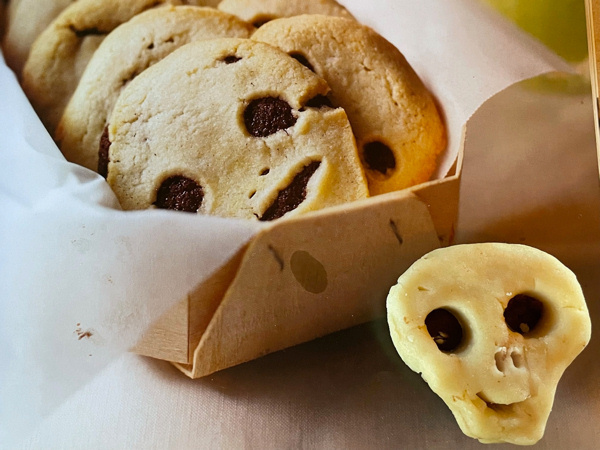
Trick or Treat Shakes
Posted October 18, 2024

I love fall. Leaves changing colors, pumpkins ripening…From the thrill of trick-or-treating to crafting the perfect costume, the best fall holiday, Halloween, is a whirlwind of fun! This year, I’ll be stepping into the role of a dazzling Pokémon performer from the Kalos region, and I can’t wait to try it out! But dressing up isn’t the only joy of Halloween—baking festive treats is just as delightful. I’m thinking spooky cookies …vibrant Day of the Dead bread…pumpkin pies (look out for future recipes!) But Halloween wasn’t always so demure. Back in 1903, Halloween mischief was at its peak. Kids didn’t just knock on doors; they played pranks—like tossing flour in unsuspecting faces when the door swung open! While there were sweet treats involved, they were often waiting at home rather than handed out by neighbors. Everything from cake to candy, and likely sweet bread and cookies, filled the holiday spirit.

Nowadays, Halloween is a bit tamer; the worst you might face is an egging. But back then? It was wild! The roots of Halloween mischief stretch back to Scottish traditions, where couples would pick cabbages to predict their futures. The first ceremony involved pulling up the first plant they encountered, with its shape and size supposedly reflecting their future partner. This playful practice, however, wasn’t always innocent—it often involved swiping cabbages from neighbors! When Scottish immigrants brought this tradition to America in the early 1800s, it quickly morphed into a more mischievous affair, with kids pelting their neighbors’ houses with the stolen vegetables. The blending of Scottish cabbage raiding with English Guy Fawkes Night added fuel to the fire so to speak! In some towns, children and teens built bonfires in the streets, dragging wood from every home to create towering pyres—chairs, sidings, outhouse roofs. To heighten the chaos, it was common to barricade adults in their homes so they couldn’t try to stop the madness—absolutely terrifying! In response to this Halloween frenzy, a cookbook from 1903 suggested a clever solution: throw a Halloween party! It noted that keeping the boys entertained with festivities might prevent them from causing mayhem. The refreshments suggested for these parties were quite different from what we enjoy today, but I can only imagine they were just as delicious!
So whether you’re gearing up for a Halloween party or heading out for some trick-or-treating (or trunk or treating!), embrace the spirit of the season with this week’s recipe—a left-over candy shake. It’s a simple way to kick off the season, but is there really such a thing as left-over Halloween candy? On the off chance there is, you now have a way to use it up before this year’s trick or treat extravaganza!
Ingredients :
4 large scoops of ice cream a little softened
6-8 fun size candies of your choosing , plus more for toppings Milk ( optional)
Instructions :
Combine the ice cream and candies in a blender and blend for about 45 seconds, or until you reach your preferred thickness Pour into a glass and serve with the remaining candies and enjoy!
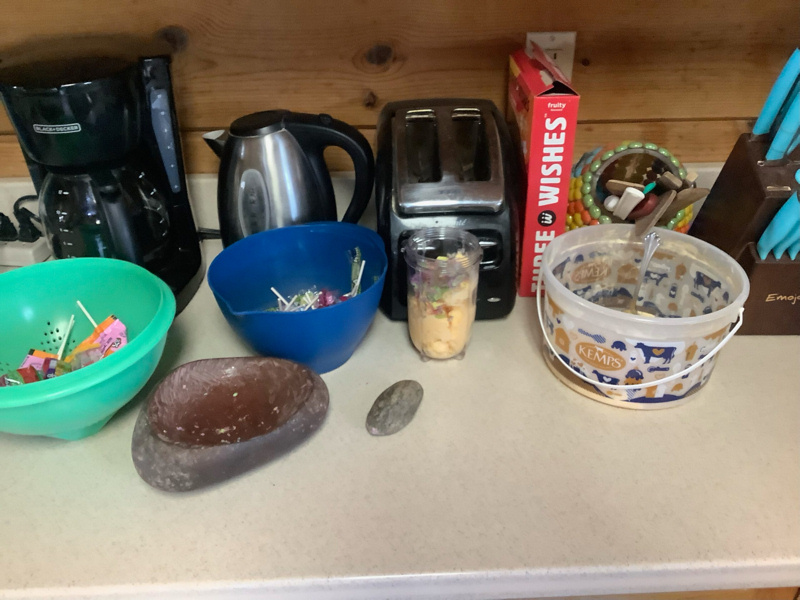


Chile Chicken Stew
Posted October 6, 2024
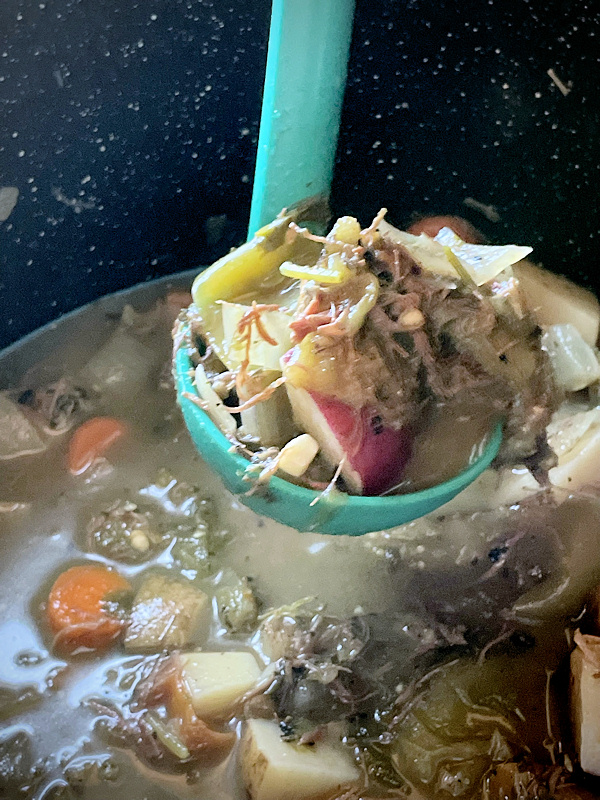
One of the best parts of fall is the variety of soups you can make! From chili and tomato to miso, potato, and carrot soup, there’s something about the colder weather that makes a warm bowl of soup even more satisfying. Personally, I love pairing a comforting tomato soup with fresh bread or my favorite rice. And though I can’t handle a lot of spice, I’ve found this chile stew recipe to be tasty. You can bring the heat down even more if you substitute out milder fresh green chiles for the roasted Pueblos or Hatch chiles.
Wait though! Chile, or chili!? In New Mexico, we always say “chile” when we’re talking about the actual peppers, like the green ones you get roasted at the farmers market. But when you say “chili,” it’s talking about the dish, a stew. Around here, chiles are a big deal—it’s part of our food and our culture. So when someone asks for “chili,” I know they probably mean the stew, but if they ask for “chile,” I’m thinking about those delicious peppers we use in everything!
The origins of chile stews are a bit hazy, but as a concept, “chili” is generally believed to have started in San Antonio, Texas, possibly created by Spanish nuns. Cowboys and gold seekers made it popular as a hearty, filling meal. Will Rogers himself once called chiles con carne a “bowl of blessedness,” and I couldn’t agree more—chili is simply amazing. There are so many variations, and while Texans today usually skip the beans, back in the 19th and early 20th centuries, recipes show it wasn’t uncommon to find them in the mix.
One of the more curious stories about chili involves a Spanish “teleporting” nun in the 17th century. Sister Mary of Ágreda, also known as “The Lady in Blue,” was said to fall into trances that transported her soul to far-off lands, where she not only shared her faith but, according to legend, spread recipes. One of these recipes was a stew made with antelope or venison, tomatoes, and chile peppers—a precursor to what we might recognize as chili today.
A more likely story ties chili to the 56 Spanish immigrants from the Canary Islands who settled in what is now San Antonio in 1731. They brought with them a stew, possibly of Moroccan origin, seasoned with cumin, which could have evolved into chiles con carne. However, cumin didn’t appear in chili recipes until the 20th century, and people have been stewing meat with chili peppers for far long before that. Around the same time as the Spanish were settling in Texas, a Swiss missionary, Philipp Segesser, wrote about seeing the native peoples of southern Arizona drying and grinding chile peppers to use in stews—a method that’s strikingly similar to how we prepare chili today.
Whatever its true origin, chili remains a delicious staple, especially as the weather turns cool and the leaves begin to change. This farmhouse recipe calls for chicken, though family recipes dating back to my great grandma show all kinds of meats stewed with chile—from green chiles and pork to ground beef and beans, to my version of chile stew, with chicken and local roasted peppers. However you make it, I hope you enjoy this recipe as much as I do!
Green Chiles Feast Stew
- Ingredients:
1 whole chicken - 1 to 2 tablespoons olive oil
- 6 cups onions
- 4 cups carrots cut into rounds
- 6 garlic cloves, minced
- 4 cups tomatillos husked, rinsed, and quartered
- 4 cups quartered tomatoes
- 1 tablespoon salt
- 1 tablespoon ground black pepper
- 1 gallon chicken broth (or water)
- 6 cups small red potatoes cut into 1-inch pieces
- 2 cups chopped roasted green chiles
- 1/2 cup fresh chopped cilantro
- 1 cup diced green onion
- Flour tortillas (for serving)
Instructions:
1. Cook the chicken, cut into pieces, in a heavy-bottomed pot over medium heat in olive oil, about 15 minutes, until nicely browned.
2. Drain all but 1 tablespoon of the drippings/oil. Add the onions, carrots, and garlic and sauté until the onions begin to brown, about 10 minutes.
3. Add the chiles, tomatillos, tomatoes, salt, and pepper and cook for another 5 to 10 minutes. Add the chicken broth or water and red potatoes. Bring to a boil, turn the heat down to a simmer, and cook for about 30 minutes or until the vegetables are tender. 4. Add the cooked chicken, cilantro, and green onions. Simmer for another 5 minutes.
5. Serve hot with fresh flour tortillas.



The Sweet World of Caramel Apples- September 28, 2024
Halloween is right around the corner, and I love making costumes and handing out candy–but I particularly love that it’s the perfect time to whip up some caramel apples! These treats are a classic fall favorite, combining the crispness of fresh apples with the sticky sweetness of caramel. Plus, you can deck them out with all sorts of toppings—think crushed nuts, sprinkles, or even chocolate drizzle! I tested out three ways to make the caramel to see what works best, so you don’t have to do the leg work on it.
First my Nana and I tried a caramel apple kit from the grocery store. I also tried melting down some candy caramels, and I made my own caramel from scratch. All turned out ok, but the one I think turned out the best was the melted caramel. The store bought boxed caramel kit tended to be a little too hard and crisp. Making it was also kind of a pain! The dry ingredients got clumpy and cooked unevenly, with some spots burning before others cooked. The homemade one turned out a bit runny when dipping but it eventually cools well and is so delicious, it’s a solid, if messy option. However, if you’re just looking for a quick project, pre-made store-bought caramels, melted down over low heat, is a clasic choice! The caramel coating is sufficiently thick and dippable without needing a bunch of stirring and fussing.
Caramel has a rich history that’s super interesting. It started way back in 95 AD when Arab chefs began crystallizing sugar. It would take centuries for the key ingredient in caramel to really hit Europe large quantities–sugar! But by the 16th century, sugar was all the rage in Europe, and the word “caramel” popped up in English around 1725, coming from French and Spanish roots. Still sufficiently a novelty, those aristocrats would have servants shape sugar into cool designs that looked like everyday foods–candy eggs and bacon, or tiny fruits.
American settlers took it a step further by boiling sugar in copper kettles, which got super hot (sugar melts at about 270°F). The caramelization process starts at around 300°F, where sugar breaks down to create different textures and flavors. You can end up with chewy, runny, or hard caramel depending on how you cook it–what temperature and for how long, with how much stirring. At any stage, caramel quickly became a candy staple because it was easy to make at home and had a long shelf life. Between 1650 and 1800, some candy makers began experimenting with added fat and milk, leading to the chewy caramels we know today. By the mid-1800s, nearly 400 American manufacturers were making caramel candies!
One of the biggest names in the caramel world is Milton Hershey. Born in 1857 in Pennsylvania, he initially trained as a printer but discovered his love for candy-making at 14. After learning from a master candy maker, he started his own business, which didn’t go well at first. But after learning to make caramels in Denver, Colorado, he returned home to launch the Lancaster Caramel Company, which quickly gained popularity. Hershey’s company eventually became known for chocolate, with the iconic Hershey bar and various caramel-filled treats!
And here’s a fun tidbit: April 5 is National Caramel Day! Thankfully we dont have to wait til spring to celebrate this sweet treat! So, while you’re rocking your Halloween costume and testing out treats, don’t forget to whip up some delicious caramel apples this fall. Whether you grab a store-bought caramel kit, melt down some caramels, or go all out and make your own from scratch, it’s bound to be a fun time experimenting with toppings! Whether you like it classic or want to get creative, there’s no wrong way to enjoy caramel apples. So go ahead, make a batch, and savor every sweet bite of fall!
INGREDIENTS:
• 8–9 cold apples
• 1 and 3/4 cups heavy cream
• 1 cup light corn syrup
• 2 cups packed brown sugar
• 1/4 cup unsalted butter, at room temperature
• 1/2 teaspoon salt
• 1/2 teaspoon vanilla extract
INSTRUCTIONS:
1. Rinse the apples under cold water and wipe them dry to remove any waxy coating. Remove the stems and insert a caramel apple stick about 3/4 down into each apple.
2. Line a large baking sheet with a silicone baking mat. If unavailable, grease the pan with butter to prevent sticking.
3. In a 3-quart heavy-duty saucepan, combine the heavy cream, corn syrup, brown sugar, butter, and salt over medium heat. Stir constantly until the butter melts. If burning is a problem, you can brush down the sides of the pan with a wet pastry brush to prevent sugar crystals from forming. Attach a candy thermometer to the pan so it doesn’t touch the bottom, or it will read too hot.
4. Allow the mixture to cook without stirring until it reaches 235°F (113°C). This will take about 15-20 minutes. Monitor the temperature closely, as it will heat slowly at first and then rapidly.
5. Once it’s at the desired temperature–about 245F to 250F at our elevation, or right as the caramel bubbles up vigorously and begins to darken–you remove the caramel from heat and stir in the vanilla. Let the caramel cool for 10-15 minutes until it thickens slightly. If it’s too thin, let it cool longer–I had some issues with it warm, but found it a lot more workable after 15 minutes.
6. Holding the stick, dip each apple into the warm caramel, tilting the pot if needed to coat all sides. Allow excess caramel to drip off and place the coated apple on the prepared baking sheet. Repeat for remaining apples.
(Optional) Before the caramel sets, roll the apples in chopped nuts, toffee pieces, or drizzle with melted chocolate.
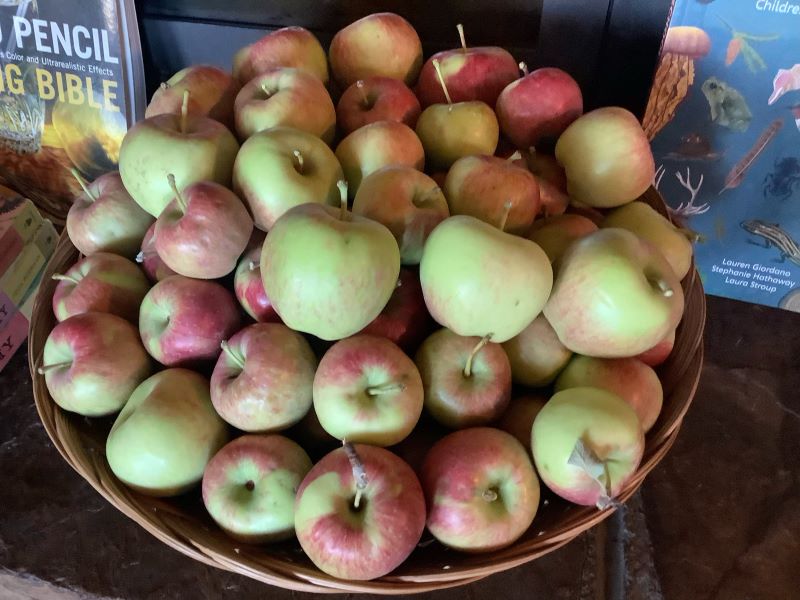
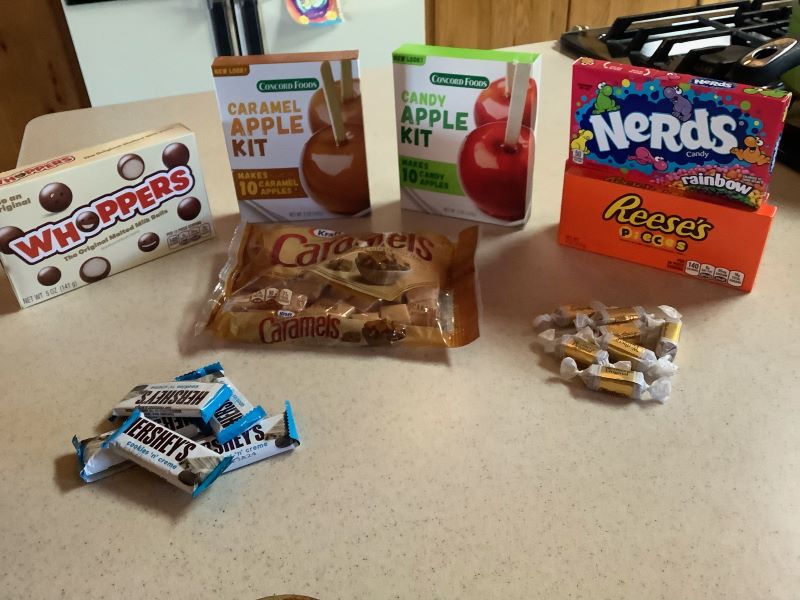
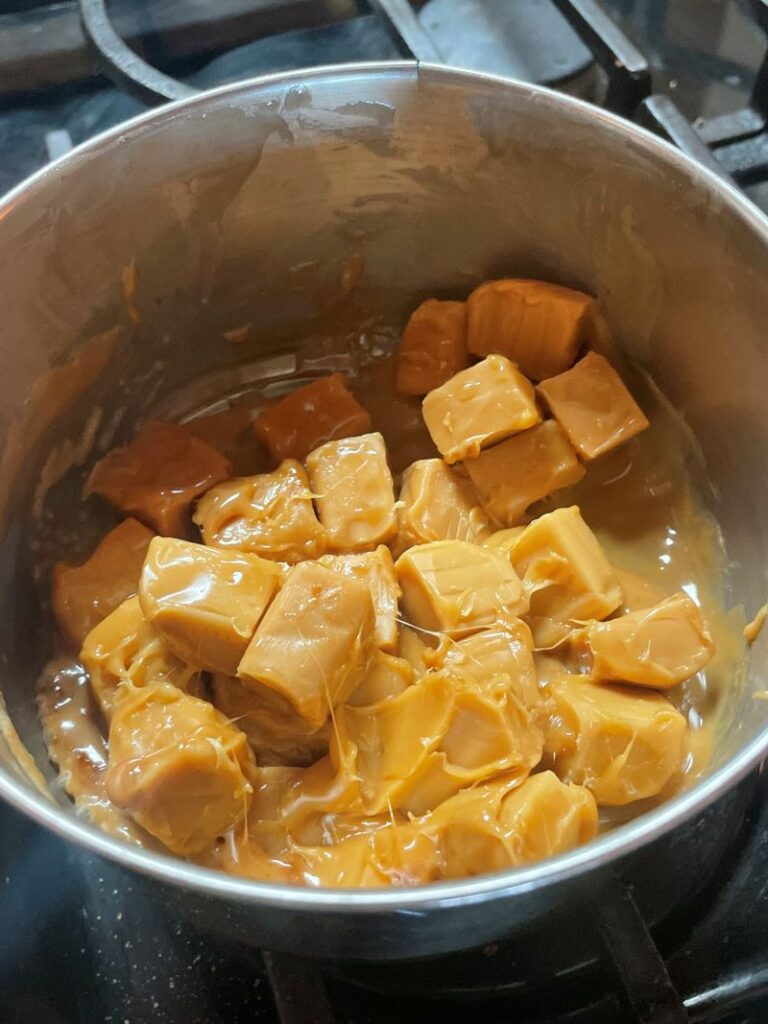

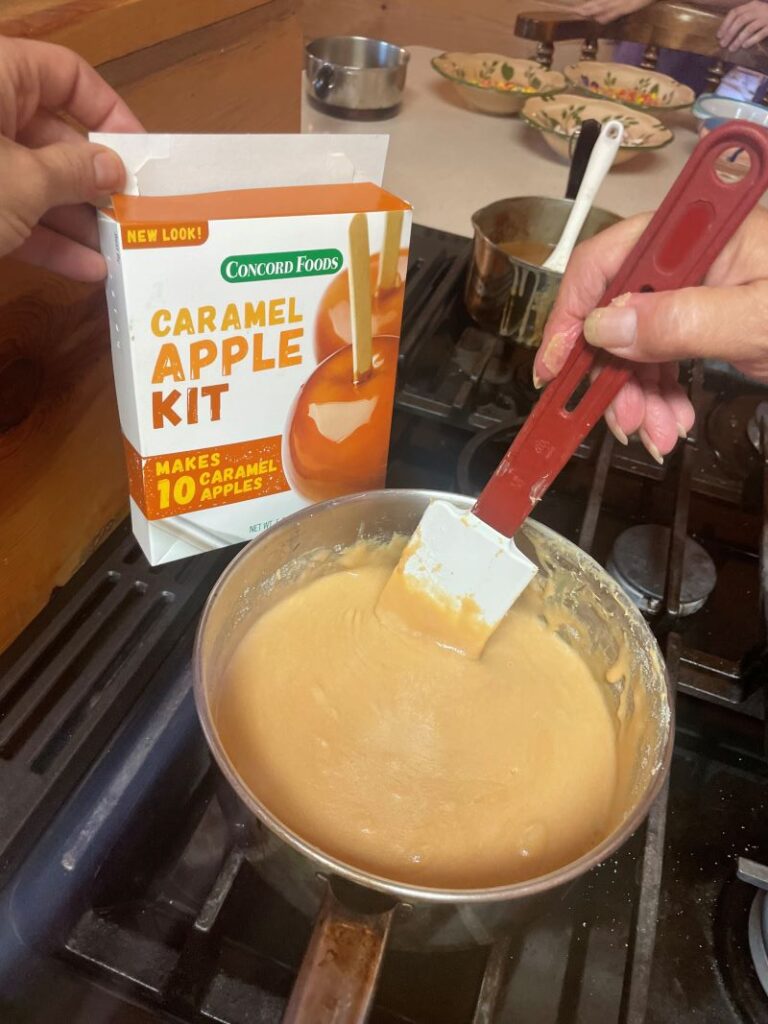
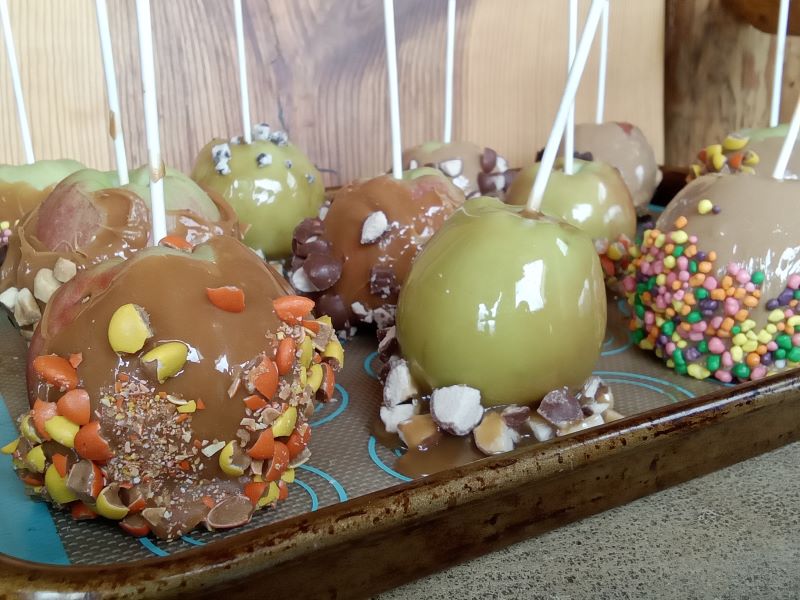

Nostalgic Tomato Soup – September 21, 2024
As autumn’s chill begins to creep into the nights here in Raton, there’s no better comfort than a steaming bowl of tomato soup (maybe with a grilled cheese?). This classic dish with its rich, warming flavors, is perfect for crisp fall days and will surely become a staple in your kitchen as the weather cools. While it might be a tad early to fully embrace autumn in all its glory, with summer ending and Halloween just around the corner, now is the perfect time to indulge in this nostalgic late summer treat.
In the past, tomato soup was a common feature of school lunches, first found during the Great Depression paired with a simple butter sandwich, a glass of milk, and perhaps a crisp apple or a hermit cookie. Their tomato soup snuck in a protein packed kick in the form of a scoop of peanutbutter for the base. While we might not see peanut butter in our tomato soup today, that combination is certainly an intriguing culinary curiosity!
I think it was also a smart move by the people making the school lunches to add extra nutrition, too! Did you know, school lunches have evolved significantly over the years? The origins of organized school meals can be traced back to late 18th-century Munich, where Count Rumford established meal programs for the pesant children who spent half the day at lessons in school and the other half in factories, making uniforms. In France, author Victor Hugo’s philanthropy in sponsoring school meals, and school administrator Victor Duruy’s push for a public initiative in the 19th century laid the foundation for widespread school lunch programs in that country, ensuring that all students, regardless of their financial status, had access to nutritious meals.
The challenges of feeding hungry children were highlighted in the United States in Robert Hunter’s 1904 book, “Poverty,” which spurred efforts to address this critical issue. He pointed out that laws required students to be at school, but didnt require them to be fed enough to concentrate while there. He estimated that tens of thousands of students in every large city were hindered by hunger. In less than a decade, many cities had established lunch programs, with teachers and parents coming together to provide meals and teach proper table manners. Like a potluck, parents would all bring what ingredients they could, and the group would prepare meals and eat together at one table. Lunch was a unifying and equalizing event. During the Great Depression, these programs became even more crucial, with out of work parents stepping in as lunch staff to help alleviate the burden on teachers. Post WWII and into the 70s and 80s, lunches became standardized nationwide and lunch quality began to slide. By the 1990s and 2000s, lunches were often devoid of nutrients, or otherwise rendered inedible. Recent years have shown a renewed interest in childhood nutrtion though.
Today, as we navigate the complexities of modern school lunch programs, there’s a renewed focus on ensuring that meals are both nutritious and appealing. A well-balanced lunch not only nourishes the body but also enhances your ability to focus and learn. Fresh local food–and a variety of it!–is key to growing strong bodies and strong minds, and Raton is stepping up to make sure kids have access to good food in the schools! Places like Ramel Farms and the Heirloom Shop, or the farmers market, have varieties of tomatoes that not only look pretty, but are packed with nutrients and flavors you don’t expect from a tomato.
So, as we get back to school, consider picking up a few tomatoes and curling up with a bowl of this heartwarming soup to be a history lesson in good eating. It’s a comforting nod to simpler times and a delicious way to embrace the bounty of the season!
INGREDIENTS:
- 2 tablespoons unsalted butter
- 1/2 large onion, cut into wedges
- 1 (28-ounce) can whole peeled or crushed tomatoes, or 3 cups freshly diced tomatoes
- 1 ½ cups water or chicken stock
- 1/2 teaspoon fine sea salt, or more to taste
- 1/4 cup dried parsley or celery (optional)
INSTRUCTIONS:
- Melt the butter over medium heat in a Dutch oven/cast iron or large saucepan.
- Add onion wedges and tomatoes and cook until softened. Add the tomato can juices if applicable and the water or chicken stock with 1/2 teaspoon of salt.
- Bring to a simmer. Cook uncovered for about 40 minutes, stirring occasionally. Adjust salt and spices as needed. I like to add dried celery and parsley, but pepper, cumin, and chiles all give your soup different vibes.
- Blend the soup to your desired consistency. If using a stand blender, blend in small batches and cover the lid with a kitchen towel to avoid splatters, otherwise it can burn!

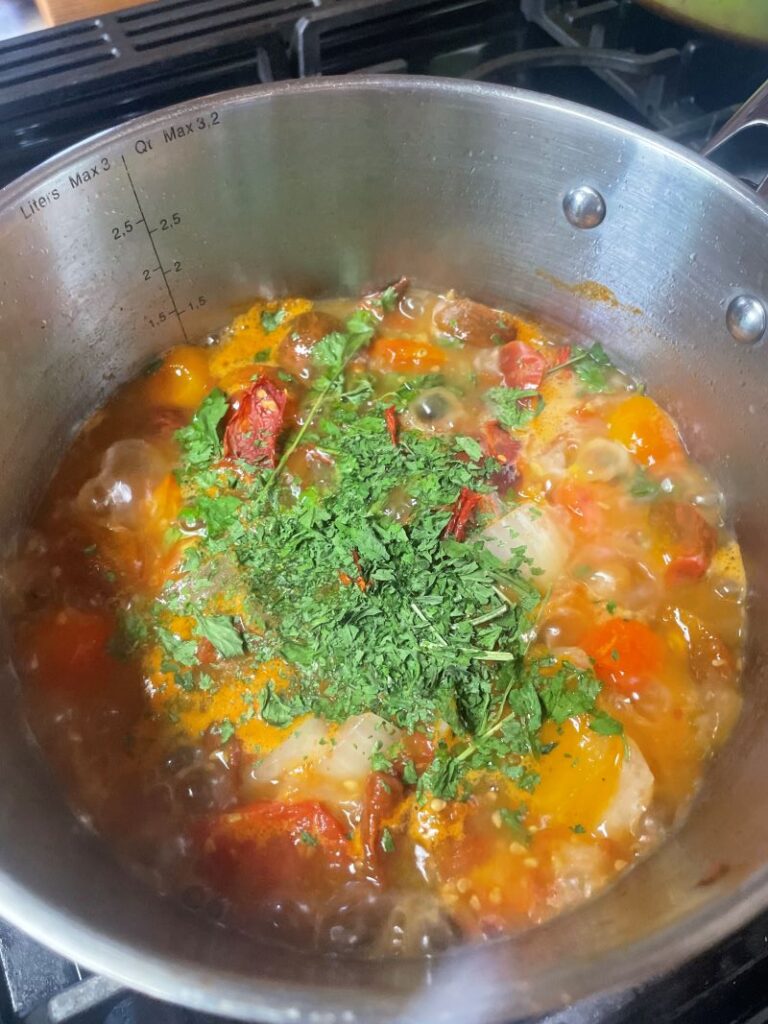
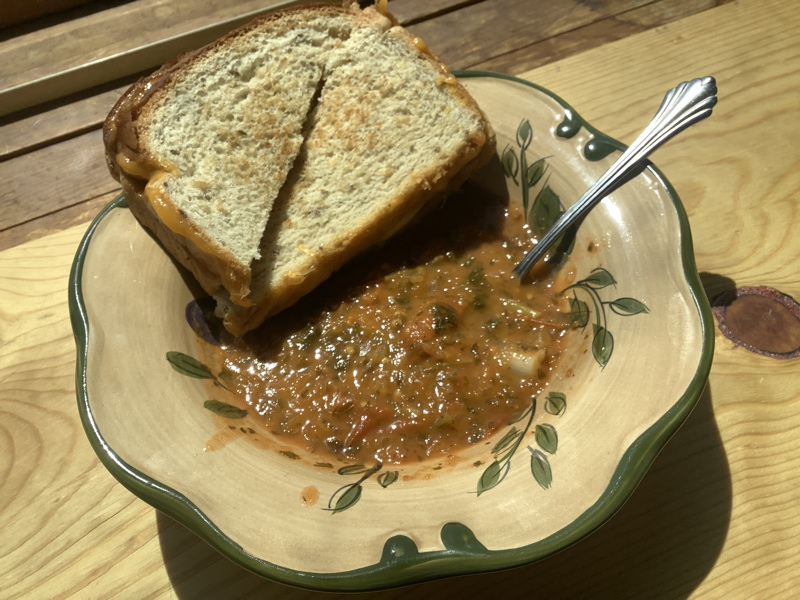

Fluffy’s Fluffy Biscuit Sandwich
Posted September 15, 2024
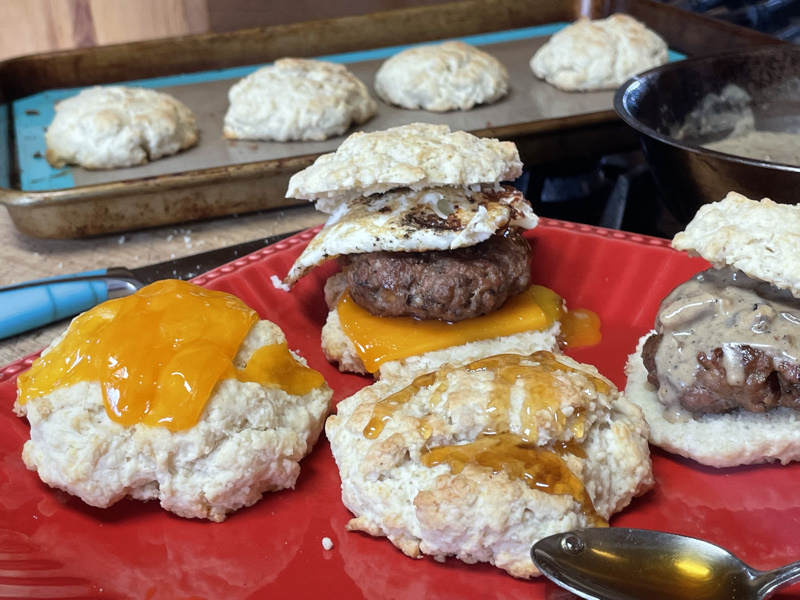
Crisp fall breezes and changing leaves make me want to reach for the bread box! And while they might not be my absolute favorite, there’s no denying that a warm, flaky biscuit to welcome in fall is something special. And American-style biscuits are in a league of their own—distinct from their English counterparts, which share the same name but are quite different.
The English biscuit is hard, while the American biscuit is fluffy and light. The key to a good American biscuit is the high butter (or oil) content and the lamination process that creates those delicious, flaky layers. The word “biscuit” itself actually comes from old French, meaning “twice cooked,” which reflects how they were originally baked and then dried out for preservation. These early versions were hard and long-lasting, often served alongside something to dip it in—alongside a soup or with tea. English scones, another British biscuit-like comparison, have a denser texture and are more substantial than a biscuit would be also.
When the European settlers brought their tastebuds and recipes to the United States, biscuits slowly evolved into a variety of regional styles. In the American South, biscuits were initially a delicacy but grew in popularity leading up the Civil War. As the war disrupted trade and made ingredients like butter even more scarce, biscuits became a Sunday treat, made with whatever was available—even sweet potato flour! However, by the late 19th century, improvements in baking techniques and the discovery of chemical leavening agents like baking soda and baking powder crucially helped those southern biscuits take on their modern form and spread—or rise?—across the United States!
This recipe using leavening is similar to the biscuits my Nana’s mom—otherwise known as Grandma Fluffy—made for her growing up! With a sausage patty and a side of gravy, sometimes topped with an egg, they make a good breakfast sandwich. They’re also perfect with tea if you’re feeling semi sort of Brit-ish, or on their own with a pat of honey! Whether you’re a long-time fan or just trying them for the first time (if so, how!?), biscuits are a simple but always welcome addition to any table. So why not give them a try? Tell me how you like them!
INGREDIENTS:
- 2 cups all-purpose flour
- 1 tablespoon baking powder
- 1 tablespoon granulated sugar
- 1 teaspoon salt
- 3 tablespoons coconut oil, very cold
- 3 tablespoons unsalted butter, very cold
- ¾ cup milk
- Optional: Add cheese for an extra savory kick!
INSTRUCTIONS:
*Chill the butter and coconut oil: for the flakiest biscuits, pop your butter in the freezer for 10-20 minutes before you start.
*Preheat your oven to 425°F.
- First mix the dry ingredients in a large bowl, combining the flour, baking powder, sugar, and salt. Give it a good stir and set it aside.
- Grab your butter from the fridge and either cut it into the flour mixture using a pastry cutter or (my favorite method) grate it using a box grater. Stir the butter into the flour until it resembles coarse crumbs.
- Pour in the milk and gently stir with a wooden spoon or spatula until the dough just barely comes together.
- Using a large spoon or clean hands, place a 3/4 cup scoop of dough, rounded and flattened.
- Place them an inch apart on your prepared baking sheet for soft sides; too far apart and the sides will bake hard.
- Place biscuits into the oven and bake at 425°F for about 12-15 minutes, or until the tops are just turning a light golden brown.
* To turn biscuits into a biscuit-n-gravy sandwich, cook sausage patties in a cast iron pan. When it’s cooked, remove the sausages, and sprinkle in a handful of flour. Cook until brown. Pour in milk until it’s a gravy consistency. Now you have the complete breakfast!
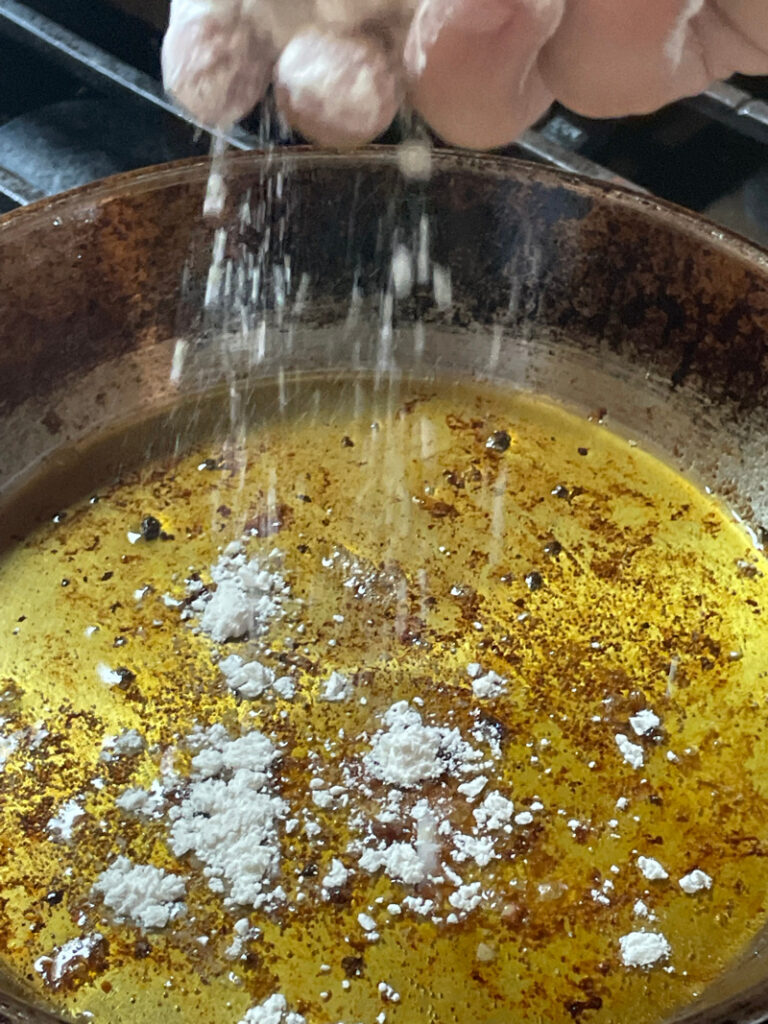
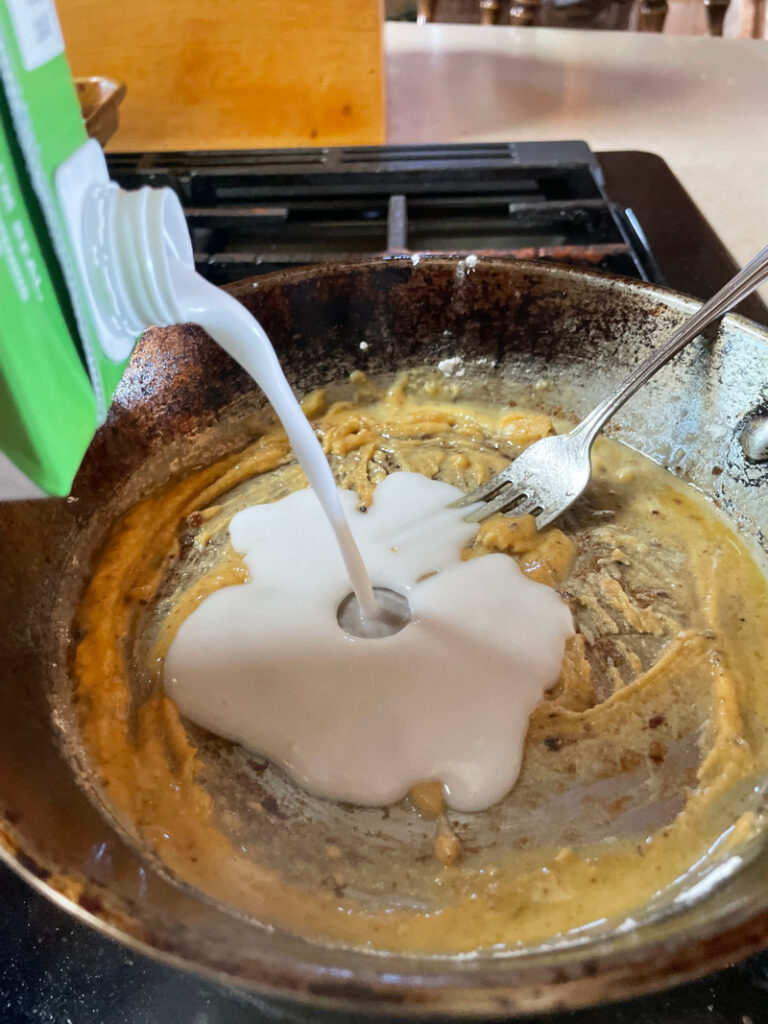
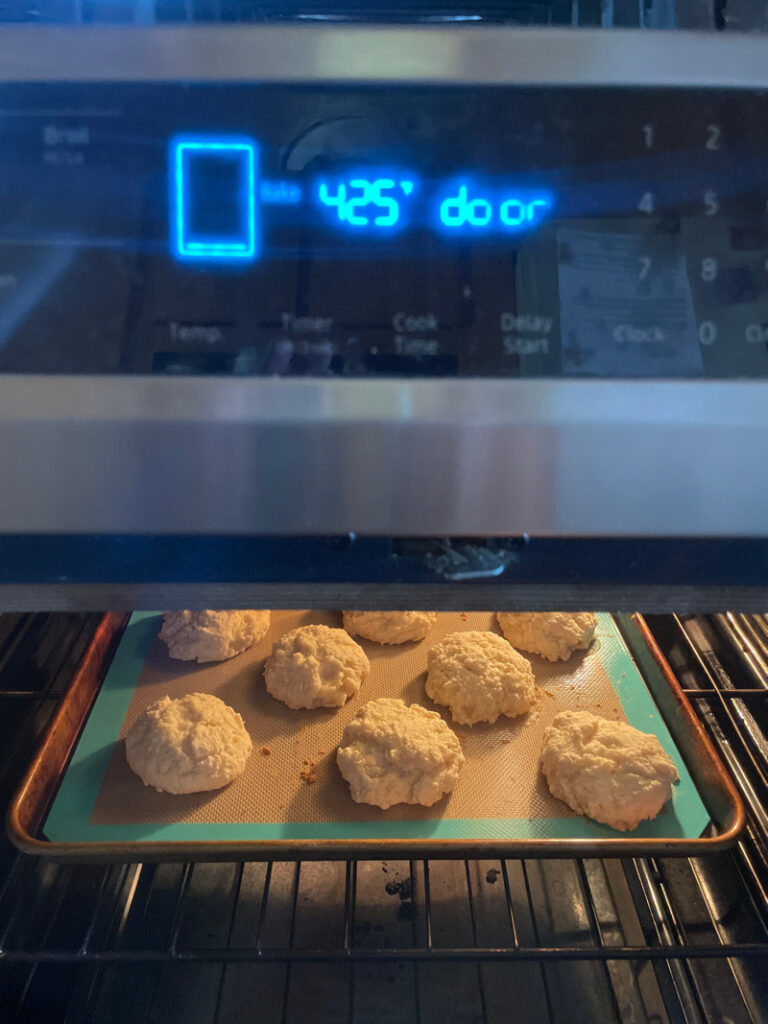

Lavash bread
Posted September 7, 2024
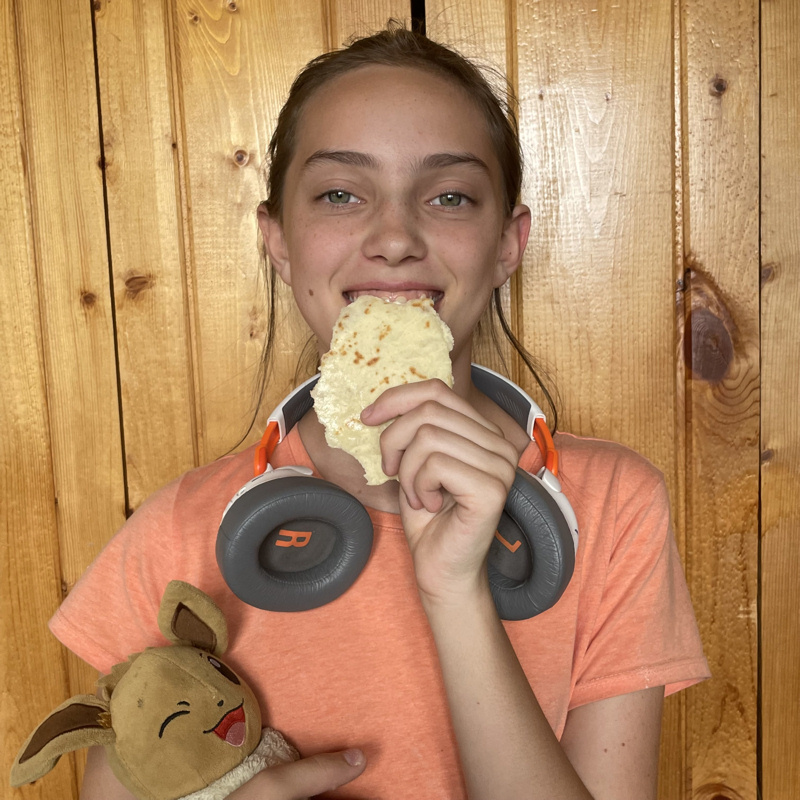
Lavash might just be one of my favorite things to make! It’s light, fluffy, and rich with flavor—a versatile bread that’s surprisingly easy to whip up. You can pair lavash with just about anything: wrap it around a salad, layer it with burger toppings, or, my personal favorite, enjoy it fresh off the stove all on its own. While I usually cook lavash on a cast-iron pan, it’s adaptable; you can cook it on different surfaces or even shape it differently. Feeling adventurous? Fry it up, and you’ve got something akin to fry bread!
Flatbreads like lavash are a staple all over the world, each culture putting its own spin on this simple delight. Not all flatbreads are lavash or tortillas; you might find crêpes in France or naan in India. Bread is universal, a global comfort food that brings people together. From flatbreads to loaves, braided buns to freeform shapes, bread comes in countless varieties. Though I’ve dabbled in making different types of bread in the past, lavash is my go-to fave. There’s something special about its simplicity and the way it complements almost anything you pair it with. Just last night, we had it with falafel and hummus—a classic combo that never disappoints. Throw in some tzatziki for dipping, and it’s one of my favorite meals! And if you have leftover dough, don’t let it go to waste; bake it up for an extra treat with some cinnamon sugar!
However you choose to cook it or whatever you decide to serve it with, lavash is a winner. So, as you try out this week’s recipe, I hope you enjoy making—and eating—lavash as much as I do. Happy cooking!
INGREDIENTS:
- ¾ cup warm water
- ¾ cup warm milk
- 2 eggs
- 2 tablespoons olive oil
- 1 tablespoon granulated sugar
- 2 teaspoons salt
- 2 tablespoons dry yeast
- 5 cups all-purpose flour
INSTRUCTIONS:
1. In a large bowl, mix together the warm water and warm milk. Sprinkle in the dry yeast and let it sit for about 2 minutes to activate.
2. Add the eggs, olive oil, sugar, and salt to the bowl. Mix well until everything is combined. Gradually add the flour, stirring continuously until a dough forms.
3. Knead the dough on a lightly floured surface for about 10 minutes until it is smooth and elastic. Place the dough back into the bowl, cover it with a clean cloth, and let it rest in a warm spot for 40 minutes or until it has doubled in size.
4. Once the dough has risen, punch it down and divide it into 12 equal pieces (or more if you prefer smaller lavash). Roll each piece out into a thin circle.
5. Heat a cast-iron skillet or nonstick pan over medium heat. Cook each piece of lavash for about 1-2 minutes on each side, or until light brown spots appear. Remove from the pan and enjoy warm or at room temperature.
Tzatziki Sauce
INGREDIENTS:
- 1 cup yogurt
- 1 lemon, juiced
- 1 cucumber, finely chopped
- Salt and pepper, to taste (optional)
INSTRUCTIONS:
1. Cut the cucumber into small pieces. You can peel it or leave the skin on for extra texture and color.
2. In a bowl, combine the yogurt, lemon juice, and chopped cucumber. Season with salt and pepper if desired. Mix well until all ingredients are evenly distributed.
3. Serve immediately or refrigerate for at least 30 minutes to allow the flavors to meld together. This refreshing sauce pairs perfectly with lavash, falafel, or as a dip for fresh veggies.
Enjoy these delightful recipes! Lavash and tzatziki are simple yet incredibly versatile, making them a great addition to any meal.



Modern Cheesecake
Posted Augusts 31, 2024

Cheesecake is a special treat in our household, and when we make it, we savor every bite. The rich, creamy cake topped with delicious fruit is a classic dessert loved by many! While there are countless variations of cheesecake, I want to share a little overview of its fascinating history.
The origins of cheesecake can be traced back to ancient Greece, where it was enjoyed by the original Olympian athletes. This early version of cheesecake was sweetened with honey and often soaked in it. I once tried making this ancient Greek cheesecake, and though it wasn’t as sweet as the modern version, it had a unique and delightful flavor. The recipe I used included ricotta or farmer’s cheese, honey, whole wheat flour, egg, and poppy seeds sprinkled on top. Unlike today’s cheesecakes, the Roman version didn’t have a crust.
Over the centuries, people began experimenting with different types of cheeses and adding crusts. The cheesecake we know today, however, owes its distinctiveness to the invention of American-style cream cheese in the late 19th century. Originally intended as a substitute for a French cheese, American cream cheese was made even richer with the addition of more cream.
In the 1920s, a legendary New York restaurant called Reuben’s, owned by Arnold Reuben, developed a cheesecake using this new American cream cheese. This gave birth to the creamy version of cheesecake that’s become synonymous with the Big Apple: New York-style cheesecake. Cheesecake has also found its way around the world. In China, you can find a super fluffy version whipped high, while in the Philippines, there’s a cheesecake made with a starchy root related to a sweet potato: called ube, this cheesecake is a beautiful purple color.
Whether you prefer your cheesecake with a rich, creamy texture or a lighter, fluffier one, it’s a dessert with a long history and a global presence. I hope you enjoy your cheesecake as much as we do and savor the last days of summer. Try topping it with some fresh fruit—peaches, raspberries and blackberries are all in season and result in a fantastic Ratonian style treat!
INGREDIENTS:
Graham Cracker Crust—
- 1 ½ cups graham cracker crumbs
- 1 Tbsp white sugar
- 1 Tbsp brown sugar
- 7 Tbsp butter, melted
Cheesecake—
- 32 oz cream cheese, softened (that’s equivalent to four 8oz packs)
- 1 cup sugar
- ⅔ cup yogurt
- 1 ½ tsp vanilla extract
- ⅛ tsp salt
- 4 large eggs, room temperature, lightly beaten
INSTRUCTIONS:
- Preheat oven to 325°F (160°C).
- Combine graham cracker crumbs, sugars, and melted butter. Press the mixture firmly into the bottom and up the sides of a 9″ round springform pan—ideally! A pie pan is just fine. Set it aside.
- In a large bowl, beat the cream cheese until smooth. Add sugar and mix until creamy. Add sour cream, vanilla, and salt, mixing until well-combined. Gradually add the lightly beaten eggs on low speed, mixing until just incorporated. Scrape down the sides and bottom of the bowl as needed.
- Pour the batter into the prepared crust. Place the springform pan on a foil-lined cookie sheet and bake for 50-60 minutes. The edges should be slightly puffy and light golden brown, and the center should still be jiggly like jello.
- Let the cheesecake cool on the oven for an hour. Transfer to the fridge and chill for at least 6 hours or overnight.
- Remove the springform ring before serving. Top with fruit, chocolate, jam, nuts or candies!

Sweet Pickled Watermelon Rinds
Posted August 24, 2024
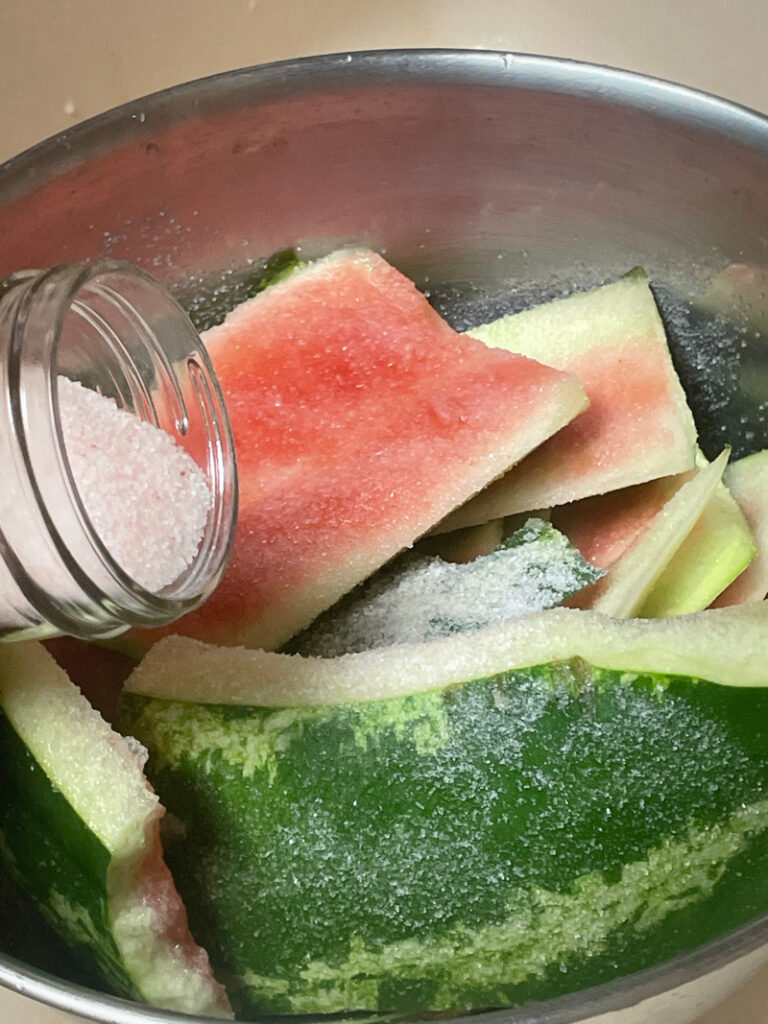
With it already halfway through August, it’s the perfect time to spice things up with a pickled watermelon rind recipe! Late summer is usually when the watermelons are at their peak and are ready in the garden, and it’s a shame to let any of it go to waste.
My grandpa’s grandma was from Germany, and in Eastern Europe, it’s more common to pickle the sweet inside flesh of the watermelon. Further north in Europe, Scandinavian countries have recipes for the green rinds. The ones that I made are what I’d call American style—splitting the difference with the hard green cut off, and just a little bit of the pink left. Pickles like this have been around in the south eastern USA since the Civil War; they’re mentioned in old dinner-party menus. One of the oldest surviving recipes for watermelon rind pickles appeared in “What Mrs. Fisher Knows about Old Southern Cooking,” which is the second oldest African-American recipe book, published in 1881! After the Civil War, the book’s author, Abby Fisher, had made her way westward to California where she was listed in the local directory as a pickle manufacturer—so her recipes for pickles must have been pretty good!
Those old-style southern recipes called for soaking the rinds in a salt brine, then boiling them with sugar, vinegar and a mix of spices until they’d turned clear and soft. This results in something resembling a sweet relish, or hors d’oeuvres-sized dill pickles, which isn’t too far off from what we did today with our recipe! This one is my mom’s, that she’s made since she was a teenager. I think pickled watermelon rinds are good cut up really thin as a slaw, or as part of a salad, or used with bacon and cheese as a bruschetta topping, or even just on a snack plate! My brothers and I eat them standing at the counter, right out of the jar! (To be clear, I don’t think you SHOULD do that, I’m just saying you’ll want to, too!)
INGREDIENTS:
For soaking—
4 cups water
1 tablespoon coarse salt
For brine—
- 2 cups peeled watermelon rind (leave a thin layer of pink but take off all the hard dark green) cut into 1 x 1/2 x 2 inch pieces and drained
- enough fresh water to barely cover the rinds
- ½ cups granulated sugar
- ½ cup cider vinegar
- 3 allspice berries
- 1 whole star anise
- 4 peppercorns
4 whole cloves - 1 small cinnamon stick
- ½ teaspoon pickling spice
- 1 inch long piece of fresh ginger root sliced thinly
INSTRUCTIONS:
- Soak the watermelon rinds in salt water over night.
Drain rinds. - In saucepan, combine the rinds and the brine ingredients. Bring to a boil over medium high heat, stirring until sugar dissolves.
- Simmer for 15 minutes, until slightly reduced.
- Pour into a jar and refrigerate for 24 hours for best taste. You can keep them jarred and in the refrigerator for up to 3 weeks.
My favorite serving suggestion: go old school and enjoy them with your favorite meats and cheese and other pickled veggies for a tasting party. For a southwest flair, add a few juniper berries to the picking mix and serve with roasted green chiles!
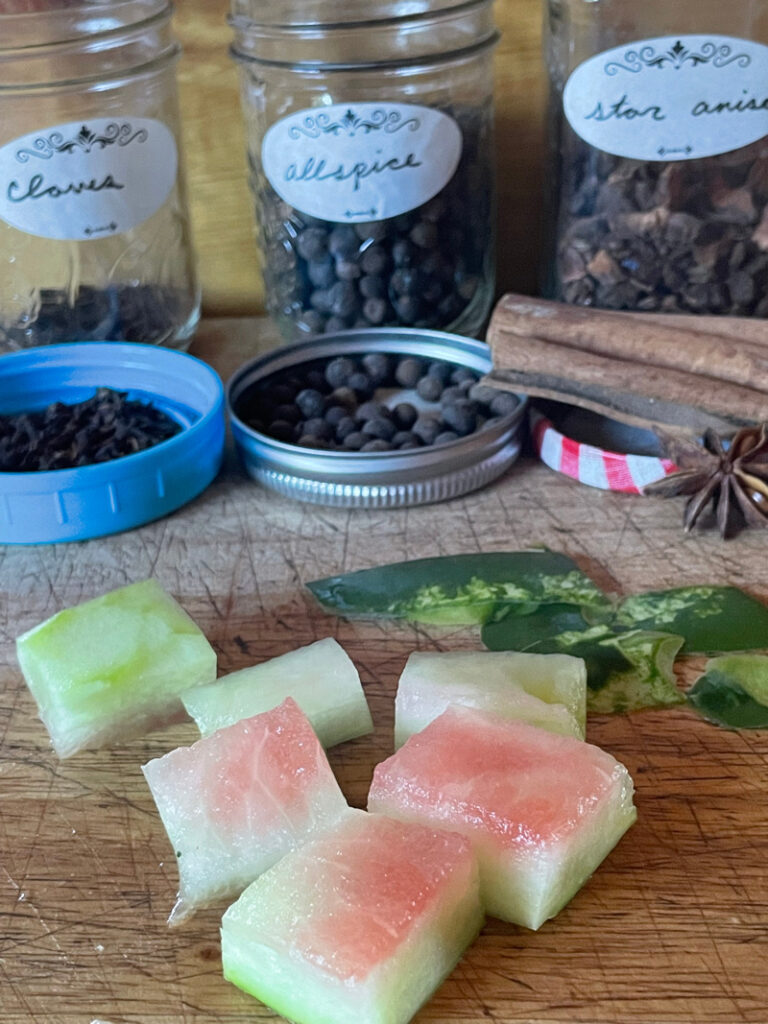
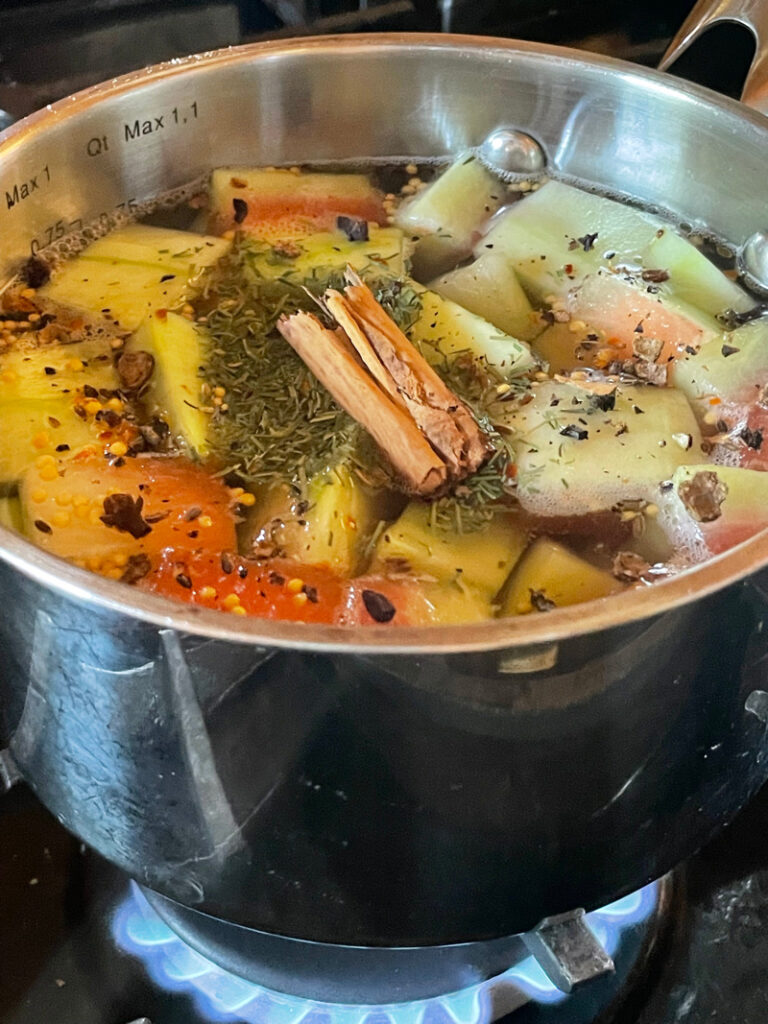
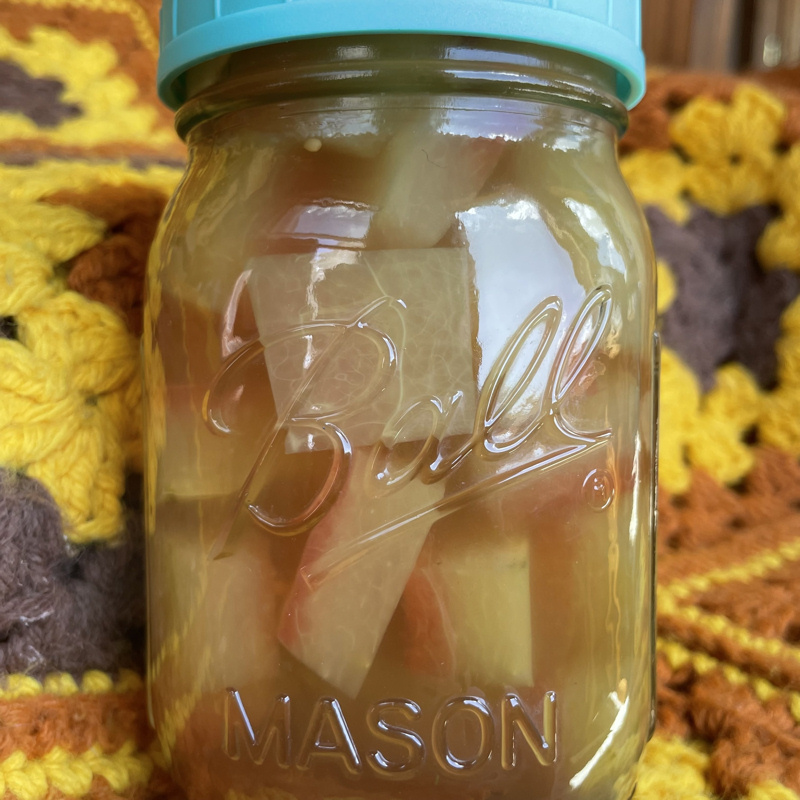

Pokémon Toast Curry
Posted August 16, 2024
Curry is a big part of Galarian culture in the Pokémon world! An activity that I really enjoy in the games is that you go camping with your Pokémon, and while you’re out fireside, you can cook them up a nice bowl of curry! Just like in real life, game curry restores their energy and wins their undying affection. The game version of curry is a sauce of blended berries, served with rice and some other toppings to make various sauces. Curry in the real world is basically a spicy gravy, and can have a tomato or dairy based sauce, and is served with rice and veggies and meat.
Curry nowadays has spread all over the world from its homeland in India, and every area has their own idea of what it should taste like! Personally, I like a nice creamy tomato sauce with a little mix of spices (not too hot!) and paneer, or cheese, with some peas. In the definitive game Pokémon sword and shield, there are 151 different types of curry—ranging from a simple “instant noodle curry” all the way to the “Mega Giganta-Max curry.” No matter what curry you enjoy, however, the best way to serve it is saffron rice! This particular curry is mildly spicy, super umami, and has a bit of crunch when you add the toast, so it’s pretty darn good too! I really hope you enjoy this recipe as much as I do, and that you enjoy a big bowl of it—with a slice of toast!—while watching the new season of Pokémon.
INGREDIENTS:
Saffron Rice
- 1 pinch saffron threads (you can use safflower as well if you prefer!)
- ¼ cup boiling water
- 2 tbsp butter
- ½ onion minced
- 1 ½ cups basmati rice
- 1 ½ tbsp salt
- 3 ¾ cups vegetable broth (bouillon cubes are just fine, too)
Curry
- 8 potatoes, cut into 2-inch pieces
- 3 carrots cut into 2-inch
- 3 tbsp olive oil
- ¼ cup butter
- ½ red onion
- 2 tbsp ginger paste or 1 tbsp ginger powder
- 2 tbsp garlic paste
- 1 1/2 tbsp cardamom ground
- 2 tsp turmeric ground
- 2 tsp paprika
- 3 tsp coriander ground
- 1 1/2 tsp cumin ground
- 1 tsp chili powder
- 1 1/2 tsp cinnamon ground
- 28 oz crushed tomatoes (approx 3 cups)
- ½ cup vegetable broth
- 2 tbsp honey
- ⅓ cup plain yogurt
- 1 teaspoon nutmeg
- 1 teaspoons cloves
- salt (to taste)
- pepper (to taste)
INSTRUCTIONS:
Saffron Rice
Place the saffron and boiling water in a cup and allow to steep for 5 minutes. Heat a saucepan with butter over medium heat.
Melt the butter and add the onions and cook until translucent.
Add the rice and cook until slightly toasted, about 3 minutes.
Add the saffron water, salt, and vegetable broth. Bring to a boil and then reduce the heat to low. Cover and cook until the rice has cooked, about 20 minutes.
Curry
Place oiled vegetables in a frying pan, and sprinkle with salt and pepper. Cook for 40 minutes,
While the vegetables are roasting, combine the cardamom, turmeric, paprika, coriander, cumin, chili powder, and cinnamon in a small bowl. Heat a large pan with butter over medium-high heat. Add the red onion and cook until translucent, about 5 minutes. Add the garlic and ginger paste and cook until fragrant, about 2 minutes. Add the spice mixture and mix until well combined.
Add the crushed tomatoes and vegetable broth. Mix well, making sure there are no clumps of spices left. Simmer for 5 minutes.
Add the yogurt and honey. Taste and season with salt and pepper if needed. Add the roasted vegetables. Cook another 5 minutes.
Serve with saffron rice and a slice of toast!


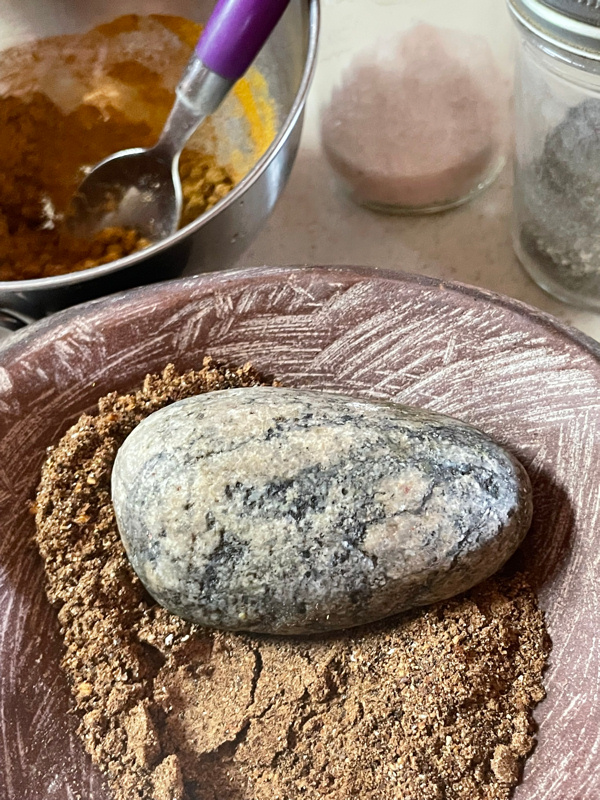


Pokémon Sandwich Extravaganza
Posted August 4, 2024
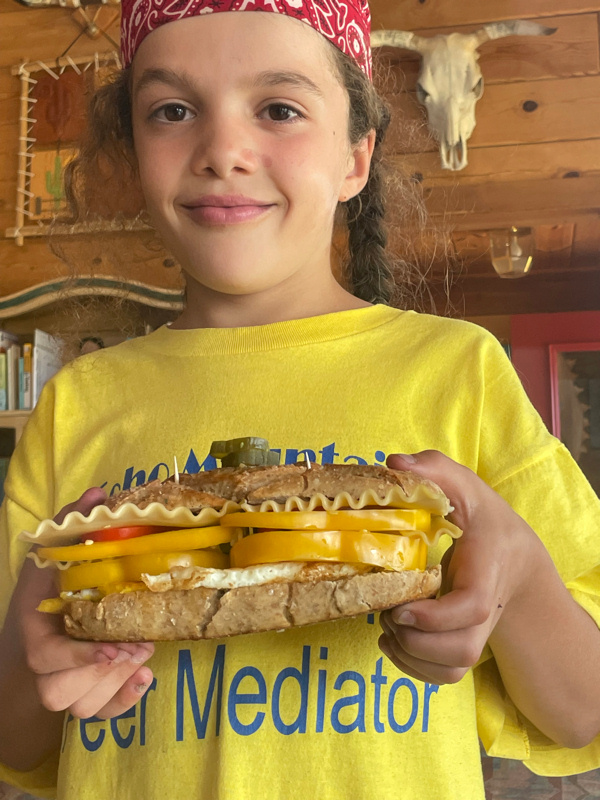
I love, love, LOVE Pokémon—and next week, a new season of the show Pokémon Horizons is coming out! In celebration, I am making some Pokémon themed sandwiches. You see, what makes the sandwiches you can create in Pokémon games really special, is that they give you different powers! These are called a Meal Power, and you have to be careful to use the right ingredients to activate your desired power. If you change the ingredients you’ll get a totally different sandwich, and a totally different power!
In the Pokemon games, there are 20 condiments and 38 ingredients for sandwiches—for a total number of combinations 79 digits long (assuming it’s all on the same bread!). With that many possible combinations, everyone can create the exact sandwich they want! In the show, sandwiches first appear in the episode “Unexpected Picnic,” where the main characters are trying to take a cruise trip. The boat gets delayed and they get stuck, and they all decide to have a picnic instead. When two of the people bring back ingredients for sandwiches, and they start cooking, you really get to see people’s personalities coming out through their sandwiches. One of the girls is polite and shy, and she made her sandwich small to avoid taking too much. Another boisterous loud guy makes a super tall sandwich just like the ones from a picture books—it’s giant and 100 percent meat! It’s a little bit obnoxious! But a fun way to show characterization.
So with that in mind for today’s sandwiches, I made each person chose the sandwich they thought would best describe them! The following six recipes suggestions are IRL (in real life!) versions of Pokémon recipes you can find in the in-game cookbooks. As for how to make a sandwich, it’s bread, with condiments spread on it, stacked in whatever order you want with whatever ingredients you want! I’m confident you know the drill!
INGREDIENTS:
- (Uncle’s) Ultra peanut butter sandwich:
- Banana slices
- Butter
- Peanut Butter
- Jam
(Grandpa’s) Ultra egg sandwich:
- Egg, fried
- Cucumber slices
- Red onion slices
- Cheese slices
- Salt
- Mayo
(Mom’s) Ultra avocado sandwich:
- Avocado slices
- Smoked Salmon (canned)
- Tomato slices
- Lettuce leaves
- Salt
(Brother’s) Master curry and noodle sandwich:
- Cooked lasagna noodles
- Red bell pepper slices
- Yellow bell pepper slices
- Cooked bacon slices
- Chill pepper flakes
- Fried Egg
- Olive Oil
- Salt
- Pepper
- Sweet Herba Mystica (an imaginary item and magical ingredient from the game—I used dried and powdered strawberries for a sweet-acidic kick!)
(My) Master Dessert sandwich:
- Apple slices
- Kiwi slices
- Strawberry slices
- Yogurt spread (thick Greek yogurt is good!)
- Whipped cream
- Sweet Herba Mystica (more powered dried strawberry)
(Baby’s) Ultra fruit sandwich:
- Banana slices
- Apple slices
- Crushed Pineapple bits
- Kiwi slices
- Whipped cream
- Yogurt spread
- Orange marmalade
INSTRUCTIONS:
Using the suggested ingredients, stack the sandwich to your liking and enjoy! I recommend trying different types of bread, like soft fluffy egg bread for the sweet sandwiches, or a rustic herbed sourdough for something like the salmon and avocado one!

Salsa Fresca
Posted July 27, 2024
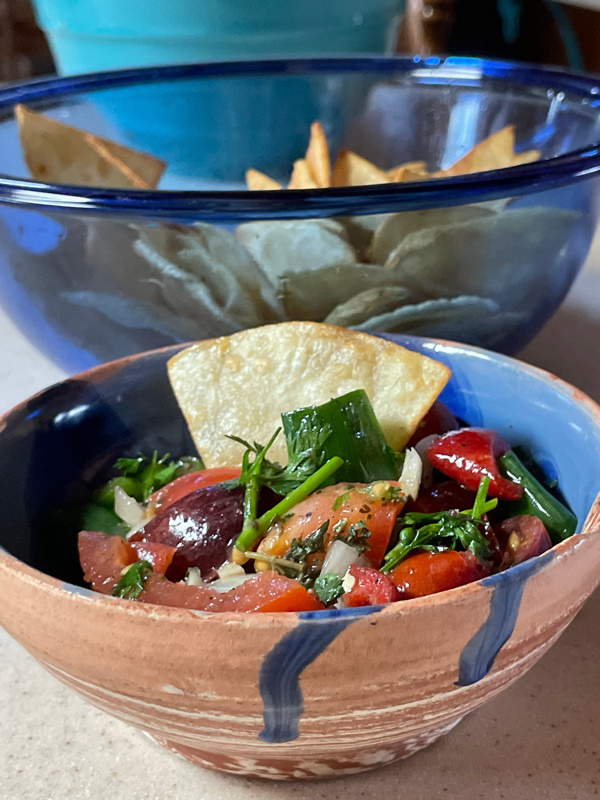
Did you know that one out of every three American households buy salsa regularly? You don’t have to be one of them with this spin on a classic New Mexican salsa!
In the 1980s, La Fonda Hotel and Restaurant in Santa Fe participated in a southwest region chile cook-off and hosted a Tucson chef. The salsa fresca (fresh sauce) the Arizona man made during the event was later adapted into La Fonda’s classic swordfish borracho con salsa fresca and printed in the 1989 “Santa Fe Recipe” cookbook—it was one of my Mom’s favorite books in college and this is my salsa garden spin on a recipe older than my mom! You can adapt it so endlessly because salsa comes in so many flavors and textures! I personally am a fan of the sweeter, chunky type salsas and really like this one as a mango based salsa as well!

Salsa can be traced back to the times of the Aztecs, Incas, and Mayans. It simply means, “sauce” and the native people of what is today Mexico created their own versions of salsa using tomatoes, chilies, and squash seeds. The rest of the world had to wait almost 2,000 more years before the “official discovery” of salsa outside its homeland. Not until after the Spaniards arrived and conquered Mexico in the 1500s did people outside the Americas first taste the range of condiments known as salsa! The term salsa encompasses a variety of sauces used as condiments for tacos and other Central American, Mexican, Mexican-American, and Southwestern foods. If you’ve eaten in a Mexican restaurant in the USA you’ve probably got a bowl of salsa and a a basket of chips before your meal and know what I mean!

There are many types of salsa, however; with Pico de gallo arguably the most popular type. It translates literally as “Rooster beak sauce,” since traditionally you were supposed to pick up the chunks with your pinched fingers, like a chicken picking at the ground. There’s also Salsa roja (red salsa, the classic recipe), and Salsa taquera (taco sauce, a smoother, spicier recipe). Another of my favorite types of salsa is salsa verde, made with roasted tomatillos instead of tomatoes, or it’s cousin Salsa de aguacate, a salsa that’s green and creamy thanks to both avocado and tomatillos!
Fruit salsa is also great if you like sweet salsa—you can feature mango, pineapple, strawberry, peaches, or whatever you want for the base! The best part is, did you know that you can grow your own salsa in your backyard, or even on a porch or apartment balcony!? You can, without too much difficulty, with a salsa garden.
Salsa gardens have all ingredients for salsa on hand any time, so you can just pick them from your yard and mix up some salsa for dinner, or lunch or even breakfast if you really want! Try some scrambled in your eggs and thank me later! The plants can tuck into a corner of a yard or even a patio or windowsill, and traditionally feature a mix of tomatoes (paste or Roma tomatoes, cherry tomatoes), peppers (hot and sweet), onions (bulb or green onions), garlic, and cilantro and/or other herbs—sometimes all in one planter! However, you can create your salsa with whatever ingredients you want. For instance, if you like a spicy salsa, you should consider putting habaneros or something even further up the Scoville Heat Scale, like a Scotch Bonnet! If you like a sweet salsa (like me) you could consider planting fruits, such as strawberries, raspberries, or even mango in place of the tomatoes. Well, maybe not mango—they probably won’t grow the best here…but let me know what fruits you have used for salsa and how it went! I always love trying new things and adapting my kitchen garden to match!
Salsa Fresca, INGREDIENTS :
- 6 medium tomatoes, diced
- 1/2 red onion, finely diced
- 1 bunch green onions, chopped
- 1 tablespoon garlic, chopped
- 1 jalapeño pepper, seeded and finely diced
- 1 tablespoon wine vinegar
- 1 tablespoon olive oil
- 1/2 bunch cilantro, chopped
- 1 teaspoon fresh oregano
- 1 teaspoon salt
- 1/2 teaspoon pepper
- 1/2 teaspoon coriander
INSTRUCTIONS :
- In a medium mixing bowl place all of the ingredients and mix them together.
- Cover , and refrigerate them for at least 2 hours then eat with fresh tortilla chips.
For tortilla chips, INGREDIENTS:
- 5 corn tortillas
- Oil for frying
- Salt (optional)
INSTRUCTIONS :
- Cut the tortillas to the desired size.
- Heat the oil and when you think the oil is hot enough, it’s time to test! Put in a little bit of tortilla and if it bubbles, you are ready to fry.
- Cook 3-5 chips at a time; when one side is light golden brown, it’s time to turn the tortilla chips and cook the other side.
- Both sides are done! Take the chips out and put them in that glass bowl (or ceramic; you just don’t want to melt plastic!) and salt as desired. Repeat until all of the chips are done. CAUTION: Be careful, since the oil is hot and might splatter some. If the chips are cooking too fast, turn down the heat. I usually use a metal set of tongs to flip the chips, but a wire basket would work well too!

Donuts
Posted July 20, 2024

Donuts: you could pick up a pack at the grocery store, but for a lower price and just a bit more time, you could take an ordinary treat to an extraordinary level! My nana says when her mom made doughnuts, all the kids on the block could smell it and wanted some. I believe it! They are exceptional homemade, and I think you should definitely make them yourself to see what I mean.
Did you know that the hole in the center of a doughnut helps it cook all the way through—and that it wasn’t always there? Two thousand years ago the Greeks and Romans were making fried dough balls we would call fritters. The Chinese, English, and Dutch among other nations all had fritters, or dough balls, or “oil cakes”. But it wasn’t until an American named Hanson Gregory punched a hole in the middle in order to create an even ring of dough that the modern doughnut was born! Another American invention is National Donut Day, celebrated annually on the first Friday of June. It was created by Salvation Army volunteers to raise funds for those in need during the Great Depression, but the nonprofit’s connection to donuts dates back to World War I. “Donut Dollies”, young women who served in the trenches frying batches of dough, were a fixture since 1917. I’m guessing now, though, Donut Day is more just an excuse to eat donuts!
If you’re looking for a good doughnut, you should be aware, there are three different basic types: cake donuts, biscuit donuts, and yeast donuts. Yeast donuts are the donuts in our recipe today, and are the kind that my nana’s mom and grandma made, really! Like their name implies they use yeast for their rising agent. They’re light and fluffy and delicious! Cake donuts use baking powder for the rise, just like a cake. They are good for dunking! Biscuit donuts are just what they sound like. They’re made from a biscuit like-dough and then fried and rolled in cinnamon sugar.
Picking your doughnut base is really just the start, too. Different flavors of donuts include filled donuts—which might have jam, jelly, or custard inside—glazed donuts, and sugarcoated donuts! The filled center doughnuts are fried and cooled before they are filled. Similarly, the glazed type doughnuts (chocolate, or vanilla, or iced with sprinkles) need to cool before they are dipped or the topping will melt off! On the other hand, sugarcoated donuts need to be coated in the sugar immediately after they are taken out of the fry oil! If they cool off too much, the sugar won’t stick well. There’s also donuts that are decorated with fondant, but those are meant to be decorative, not tasty…so that’s a story for another day!
INGREDIENTS:
- 1/2 cup milk
- 4 teaspoons yeast
- 1 teaspoon sugar (for yeast mixture)
- 2 cups flour (bread flour, or AP flour is fine)
- 1/4 cup sugar
- 1/2 teaspoons salt
- 1 egg
- 3 tablespoons butter
INSTRUCTIONS:
1. Mix together the yeast and 1 teaspoon of sugar and milk. Mix well, then set to the side to activate the yeast (wake them up).
2. Mix together the rest of the ingredients, and then add the yeast mixture once all are combined. Knead for about 5 to 10 minutes, then set aside in a warm spot for one hour until doubled in size.
3. Flatten the dough. Roll it out to desired thickness. Use round cookie cutters or a donut cutter to cut out the donut to your desired shape.
4. Place donut on a piece of parchment paper. Proof until double in size.
5. Heat up oil on medium. You’ll know it’s ready when it a small pea sized piece of dough bubbles when you drop it in!
6. Carefully slide a donut in the oil, parchment paper and all! You can pull the paper out with a pair of tongs when it unsticks, which is quite fast.
7. Deep fry both sides approx. 1 minute or until golden brown.
8. Either dip immediately into sugar/cinnamon sugar, or, if preferred, cool down on a cooling rack and fill or coat with glaze.
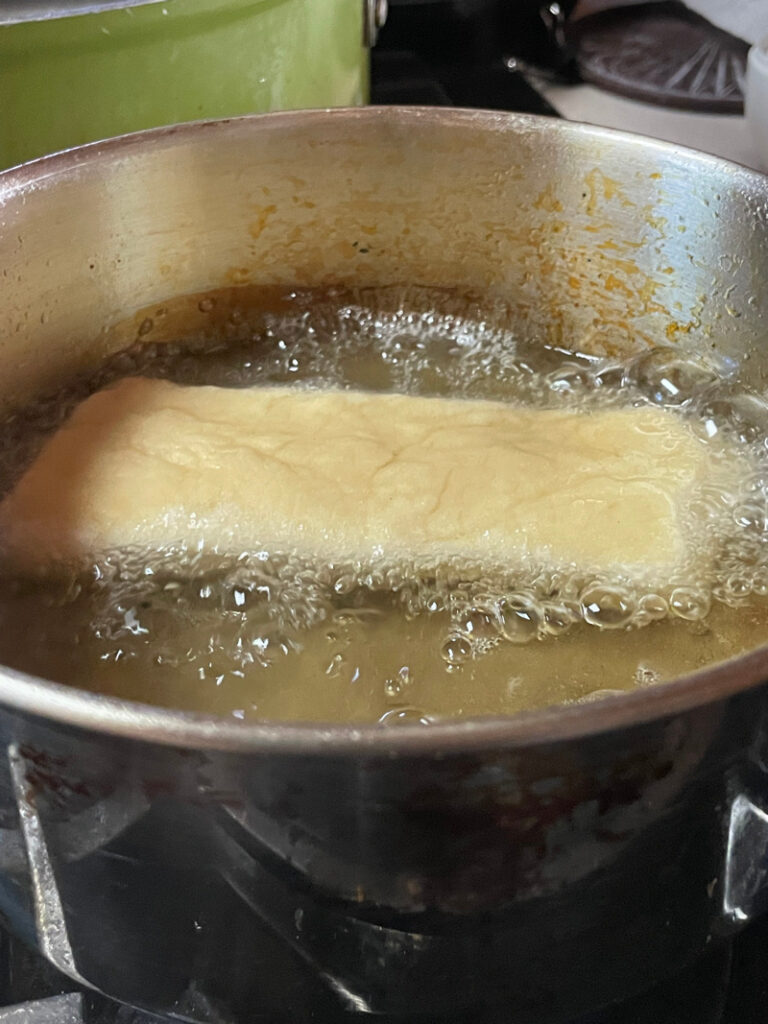
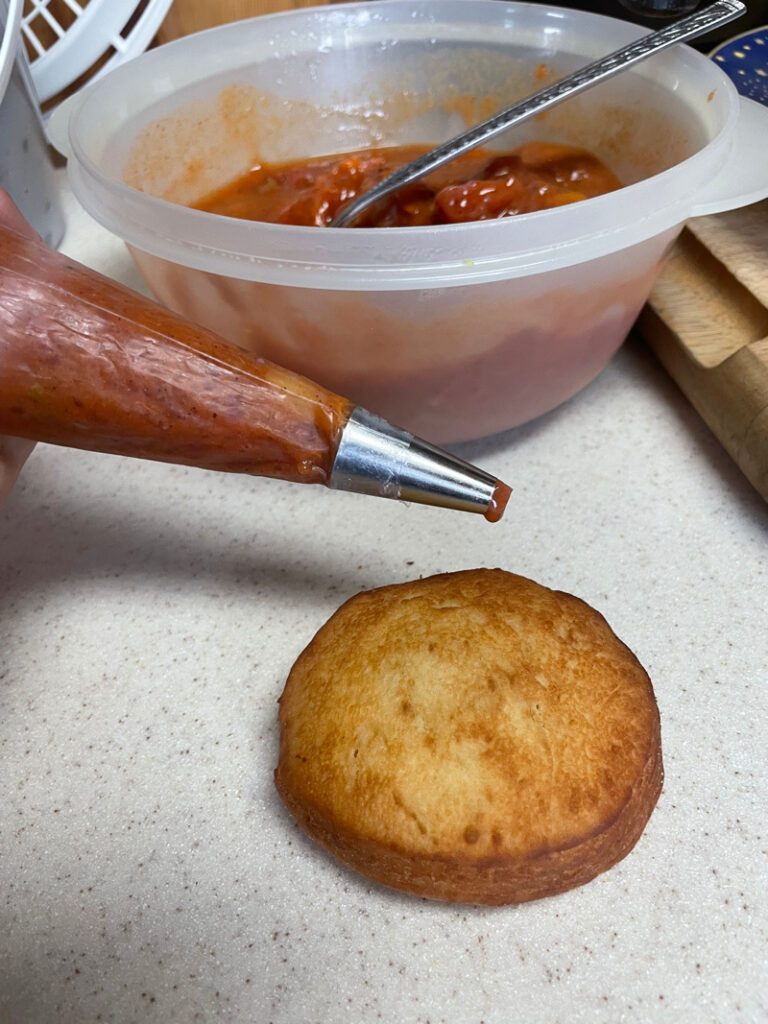

Super Easy Two Ingredient Gummies
Posted July 13, 2024

I love to make homemade gummies: they’re absolutely delicious for something you can make with as little as two ingredients! While sour gummies may be one of the most popular types of gummy candy, I’ve never made them personally. But in the lead up to National Gummi Worm Day on July 15, I’ve made at least 20 different flavors! Our recipe here can be made with whatever fruit juice you like best. I’ve made everything from lemonade gummies to mixed berry Kool-Aid gummies, and even immune boosting elderberry cinnamon gummies. Kool-Aid works particularly well, in my opinion!
But how was the gummy candy invented? Well, in Germany in the year 1920, times were hard and the country was going through economic recovery and cultural renovation after World War I. A young man named Hans Riegel in Bonn, Germany founded Haribo—a combination of his name “HAns RIegel” (HA-RI) and the the “BO” from Bonn, the name of the city. Originally operating out of his small kitchen with not much more than a copper pot, a rolling pin and stove, his mission was to make affordable high-quality sweets for the people of Germany. His early candy offerings included licorice heart candies and fruit gum. He was serious about quality, but creativity set the foundation for one of the world’s most beloved candy brands!
Riegel started small, but would end up hiring his first employee—his wife Gertrude—in 1921, just a year after he began making candy. She handled deliveries in the early days. While she was out delivering orders, Riegel would use the time to experiment with different candies. One of this experimental sessions resulted in Riegel stumbling on an altogether unique sweet treat: the gummy bear. He debuted his new treat dubbed dancing bear in 1922! It was longer than a modern gummy bear, and much slimmer—the mold was reportedly a model of a real dancing bear! Real dancing bears entertained children at festivals in Europe at the time, and Riegel’s big idea was that instead of shapeless blobs, candies should have personality!
It was a hit! The Dancing Bear candy sold well, and in 1925, Haribo expanded their offerings again, offering treats including ropes, wheels, and of course, bears. By the 1930s, the company had experienced substantial growth and had a workforce of 400 employees—when only nine years earlier they only had two, that’s pretty impressive! During this period, the company made a new slogan which translated to English reads “Haribo makes children happy!” The company continued to experiment through the years, but never returned to the “gummy ropes” of their early years—it wasn’t until 1981 that Trolli, another candy company, debuted their “Gummy Squiggles,” first sold on July 15. Gummy squiggles quickly morphed into gummy worms, and July 15 became Gummi Worm Day in honor of Trolli’s gummy improvement!
I think gummy worms are lots of fun, and totally worth a look at their long and complex history! Good thing making them doesn’t take nearly as long! Hopefully you find your own favorite flavor of gummy bear with a little trial and error, and you enjoy this sweet recipe!
Super Simple Gummies
Ingredients
- 1/3 cup fruit juice
- 1 tablespoon unflavored gelatin
- 1 tablespoon water
- Optional:
- 2 Tbsp honey
- OR
- 2 tsp granulated sugar + 1 tablespoon water
Instructions
1. Place silicone molds on a baking tray. This makes it easier to transport them into the fridge! (Also, make sure you have a flat area in your fridge to place the gummy once they’re poured in the molds!)
2. Bring 1/3 cup fruit juice (and if you want, 2 Tbsp of honey, or 2 tsp granulated sugar + water) to a boil over medium-high heat in a small saucepan or pot.
3. Set aside to cool for 3 minutes.
You want to get the juice to a spot where it is warm enough to melt the gelatin, but not hot enough to weaken the setting power of the gelatin—at least 120 degrees F but no more than 180 F is about right.
4. In a small container or bowl, “bloom” the unflavored gelatin. To do this, mix together gelatin with one TBS water until the gelatin is fully dissolved. The mixture should become quite thick as you stir it.
5. As soon as the gelatin and water are mixed together and thickened, add it to the slightly cooled juice mixture.
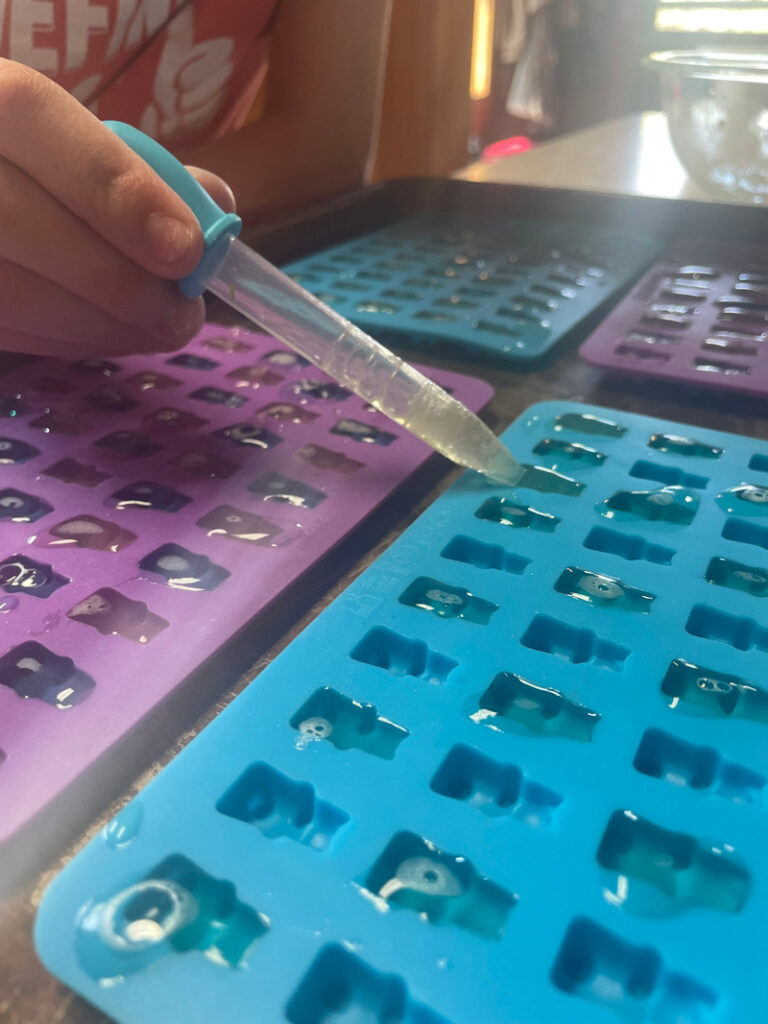
6. As the gelatin sits it can firm up and become difficult to mix in! Don’t worry. It should still be able to dissolve into the juice mixture, but it will take longer to melt/dissolve fully—just keep stirring or whisking! Make sure the gelatin is fully dissolved before filling the molds, or else tiny bits of gelatin can clog up the eye dropper and make gritty gummies!
7. Use an eye-dropper (they come with most small silicone molds, or you can order them separately) to carefully fill the silicone molds. Be sure to do this as soon as the gelatin is fully mixed into the juice mixture. If you let it sit and continue to cool, the mixture will start to set.
8. Carefully place the molds in the fridge for 30 minutes, then pop your worms out of the molds and enjoy!

Bagels
Posted July 7, 2024
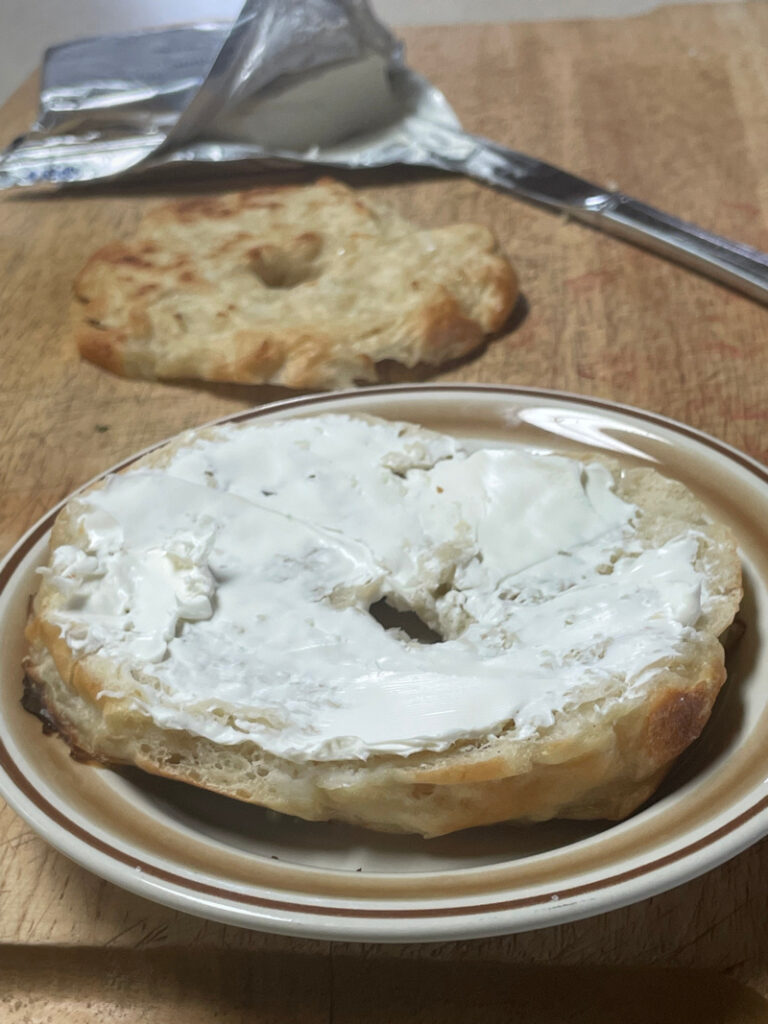
More than a roll with a hole in the middle, a good bagel is shiny on the outside, chewy on the inside, and packed with flavor for such a mild bread! Bagels are delicious to eat as a breakfast, piled high with toppings, or as a grab and go snack.
What takes them over the top is the wide variety of toppings and fillings available to customize your bagel—anything from a plain bagel (made extra special by coloring the dough inside to make a surprise rainbow!), to a sweet dried blueberry and cream cheese bagel, to a hatch green chile cheddar bagel with scallions! Really the only limit is your imagination. Since these are homemade, you can go as wild as you want with them! Maybe you really like garlic bread—try a toasty garlic bread bagel with garlic salt sprinkled on top! You could try a bagel with your favorite cookie chunks in it, if you have a sweet tooth. And salt bagels are my mom’s favorite, but you could really amp it to 11 by adding rosemary to your large chunk sea salt!
Bagels are for everyone, but a lot of people think big city New York when they think bagel! How did they get there? Well, bagels have been widely associated with Ashkenazi Jews since the 17th century. They were first mentioned in Jewish community ordinances in Kraków, Poland in 1610. A popular street food, bagels were stacked on poles or hung by strings—necessitating the iconic middle hole! Some records even suggest that though a common street food, the bagel is truly fit for a king—created in honor of Polish King Jan Sobieski. But weather meant for kings or commoners, the bagel quickly spread across Eastern Europe and eventually came to US shores with immigrants in the late 19th century. Jewish immigrants in the early 1900s often settled in Toronto and New York, and they brought their love of the bagel with them! Tight knit communities grew, and a unique style of boiled, broiled bagels developed. At that time in New York, there were so many bagel makers that local 338, The Bagel Maker’s Trade Union, was even fought for and established in 1915!
No matter what bagel you prefer for your base, or which toppings you put on it, it’s unarguable: nothing beats a bagel. If you’ve never tried making one from home, I’d really like to encourage you. Even if they don’t turn out as fluffy as you’d normally see in stores, the taste of a homemade boiled and broiled bagel is unbeatable!
Ingredients
- 1 and 1/2 cups warm water
- 2 and TSP instant yeast
- 4 cups bread flour (spooned & leveled)
- *Note: you’ll want a bit extra for dusting your work surface and hands. If you don’t have bread flour, all purpose flour is ok!
- 1 TBS sugar
- 2 teaspoons salt
- For coating the bowl: 2 TSP olive oil
- For egg wash: 1 egg white beaten with 1 TBS water
- For Boiling: 2 quarts water with 1/4 cup honey (or sugar, or molasses)
Instructions
Whisk the warm water and yeast together and allow to sit for 5 minutes in a large bowl.
Add the flour, sugar, and salt. Beat on low speed for 2 minutes if you have a stand mixer, or mix with a wooden spoon for five minutes. The dough is very stiff and will look somewhat dry, but that’s normal!.
Knead the dough: in the bowl, beat for an additional 6-7 full minutes with a stand mixer, or knead by hand on a lightly floured surface for 6-7 minutes. If the dough becomes too sticky during the kneading process, sprinkle 1 teaspoon of flour at a time on the dough or on the work surface/in the bowl to make a soft, slightly tacky dough. Do not add more flour than you absolutely need because you do not want a dry dough!!
After kneading, the dough should still feel pillowy, so that if you poke it with your finger it slowly bounces back. Now dough is ready to rise! You can also do a “windowpane test” to double check if your dough has been kneaded long enough: tear off a small (roughly golfball-size) piece of dough and gently stretch it out until it’s thin enough for light to pass through when you hold it up to a window or light source—like the bread itself is a windowpane! If it doesn’t stretch and instead snaps, keep kneading until it passes the windowpane test.
Lightly grease a large bowl with oil and put the dough in the bowl, turning it to coat all sides in the oil—it’ll rise fast and you don’t want any sticking! Cover the bowl with aluminum foil, plastic wrap, or a clean kitchen towel but be aware the towel is likely to stick, even to oiled dough!
Let the dough to rise at room temperature for 60-90 minutes or until it has doubled in size.
Shape the bagels!
When the dough is ready, punch it down to release any air bubbles. Divide the dough into 8 equal pieces. (Just eyeball it—doesn’t need to be perfect!) Shape each piece into a smooth ball. Press your index finger through the center of each ball to make a hole about 1.5 – 2 inches in diameter. Let rest for a second rise while you get the oven and water ready, or about 20-30 minutes.
Preheat oven to 450F.
For the water bath, fill a wide pot with 2 quarts of water. Whisk in the honey/sugar/molasses—this will help your bagel brown in the oven when it caramelizes! Bring the water to a boil, then reduce heat to medium-high.
Drop bagels in, 2 at a time, making sure they have enough room to float around. Cook the bagels for 1 minute on each side.
Using a pastry brush brush the egg wash on top and around the sides of each bagel. No worries if you don’t have a pastry brush, because you can gently dip the top of the bagel into the egg wash. Now, place 4 bagels onto each baking sheet.
Bake for 20-25 minutes, rotating the pan halfway through (top rack and bottom rack switching places, and rotating the pan 180 degrees around front/back). You want the bagels to be evenly golden brown!
Remove from the oven and allow bagels to cool on the baking sheets for 20 minutes, then transfer to a wire rack to cool completely.
What to do with leftover bagels? I’ve never run into the problem myself, but I hear you can cover leftover bagels tightly and store at room temperature for up to 1 week in a bread box or on the counter. Alternatively, you can cut them and dry them as bagel bites/croutons!

Mango Highlight
Lassi and Sticky Rice
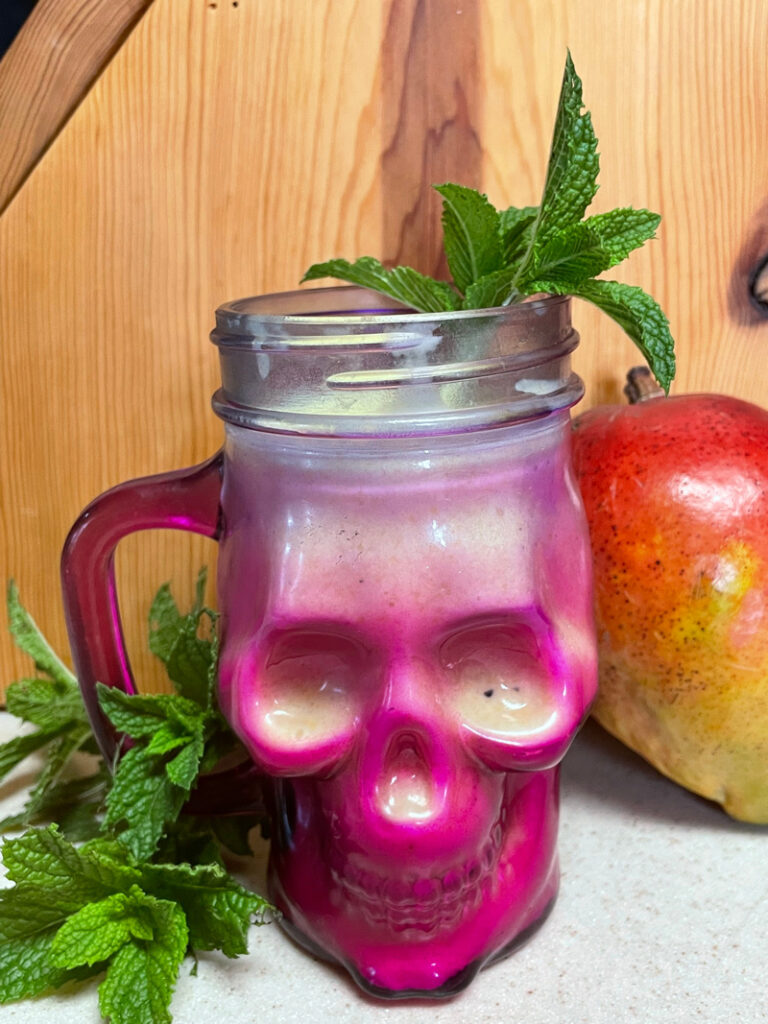
It’s starting to get hot out, so cool treats are the perfect thing to beat the heat! Everyone loves ice cream and popsicles, but one of my personal favorite summer treats is a lassi. The word Lassi comes from the Punjabi word “lass,” or “to mix,” and Indian lassi are a cool mix of yogurt and milk. In India, the drink is enjoyed by people young and old casually, but also used in a ceremonial role—usually weddings, but also religious celebrations and festivals. It was what I had instead of cake for my first and second birthdays, too!
While mango lassi are my favorite flavor and are are particularly refreshing and delicious, there are many different types of lassi, all with their own strengths. Lassi flavors vary by region—in the north part of India, sweet rose, saffron, and cardamom are common. In the south, savory salt lassi is most popular. But people all across India—and the world!—enjoy flavors as varied as cumin, mint, pistachio, and even grape, apparently. And just when talking about the mango, there are so many more flavors than you’d ever imagine!
While the exact number of mango varieties is uncertain, there are at least 500 types, and maybe as many as 2,000. I believe that, because they’re easy to grow from seed and every tree is unique! In our area there are an only few that are available commercially, so what I usually use to make these dishes are reddish colored mangoes called Tommy Atkin’s because that’s what they have at the store most often. I’m sure you could make a delicious lassi with whatever you have around, from peaches to apricots to rose petals or strawberries! Same with the sticky rice—the toppings are limited only by your imagination!
No matter what spins you put on this week’s recipes, I really do hope you enjoy! Let me know what you have tried and how it goes!
Mango Lassi
Ingredients:
- 1 cup chopped mango (about 1 1/2 mangos)
- 1 cup yogurt
- 1/2 cup milk (coconut milk or whatever milk you prefer)
- 4 tablespoons sugar or honey
- 1/4 teaspoon cardamom powder
- Ice cubes (optional)
- Mint for garnish (optional)
Instructions:
Put the mango, yogurt, milk, sugar, and cardamom powder in a blender. If you’d like a slushier consistency rather than a creamy consistency, you can add a handful of ice cubes. Blend it all together.
Pour into glasses. Garnish with mint if desired and serve.
This is a delicious yet simple recipe. It’s best served with sticky rice, which is my favorite way to use up the mango you might have left over!
Mango Sticky Rice
The Sticky Rice:
- 1 cup dry glutinous rice (or white rice, not instant), soaked overnight
- 1 cup milk (coconut milk is best, but any full fat milk works!)
- 3 tbsp granulated sugar
- 1/2 tsp sea salt
- Part Two—the Coconut Sauce:
- 1/2 cup full fat coconut milk
- 2 tbsp granulated sugar
- 1 tsp corn starch (optional, to thicken)
- 2 tsp room temperature water (for cornstarch)
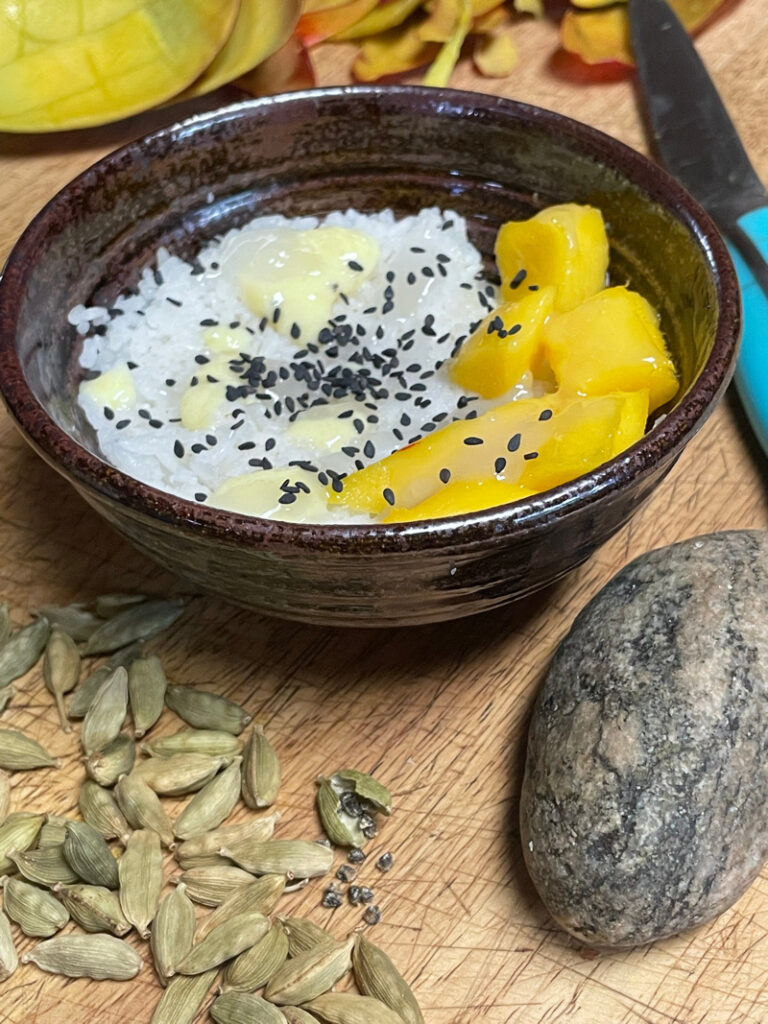
Ideas for Toppings :
- 2 large ripe mangoes
- Toasted coconut
- Roasted sesame seeds
Instructions:
Start this recipe the night before you want to cook! First, wash the rice 3-4 times to remove the starch or until the water is almost clear instead of milky white. Then leave it to soak overnight—at least 8-24 hours.
Afterwards, drain the water from the rice. Place the rice on a bamboo steamer lined with parchment paper—if you don’t have a steamer, it’s ok! A metal sieve works perfectly fine too; find one that fits neatly inside a large pot. Put your sieve or steamer into the pot so that it rests on the rim and sits a few inches above the bottom of the pot. Fill the pot with water until it just touches the bottom of the rice.
Steam for 20-25 minutes on medium heat. or until the rice is cooked, slightly translucent, and still very chewy.
**Note: If you only soaked your rice for a few hours, you will need to steam the rice much longer to cook the rice fully.
While the water boils and rice steams, heat another a large pan to medium high and warm the milk. Add in the sugar and salt. Leave the milk to simmer over medium high heat until it boils.
Once it boils, lower heat to medium and continue stirring until the sugar has all dissolved.
Add the steamed rice to the milk and cook down the rice until it has absorbed the milk and has thickened, around 4 minutes. Turn off the heat and leave to cool for 5 minutes.
Coconut sauce
In the same pan you used for the milk the first time, still over medium high heat, add the coconut milk and sugar for the coconut sauce.
Stir in the same direction and cook over medium heat until it boils. Once it boils, lower the heat to medium.
Dilute the cornstarch with the water. While stirring the coconut milk, pour in the cornstarch slurry.
Turn off heat and keep stirring until it thickens. Transfer to a small container until ready to use.
Assembling the sticky rice:
Peel the mangoes and slice the side, creating 4 mango halves. Then slice each mango half into 1⁄4-inch thick strips, or cube.
Portion the rice into 4 bowls, then top with mango and sprinkle on toasted sesame seeds or coconut flakes—or both! Finish off by drizzling on some of the coconut sauce.
These are best enjoyed fresh!
Storage tips:
You can refrigerate these overnight if you have leftovers—I never do because they’re so good! They should be consumed within a day or 2 days at most because coconut cream can easily go bad.

Grandpa’s Pizza
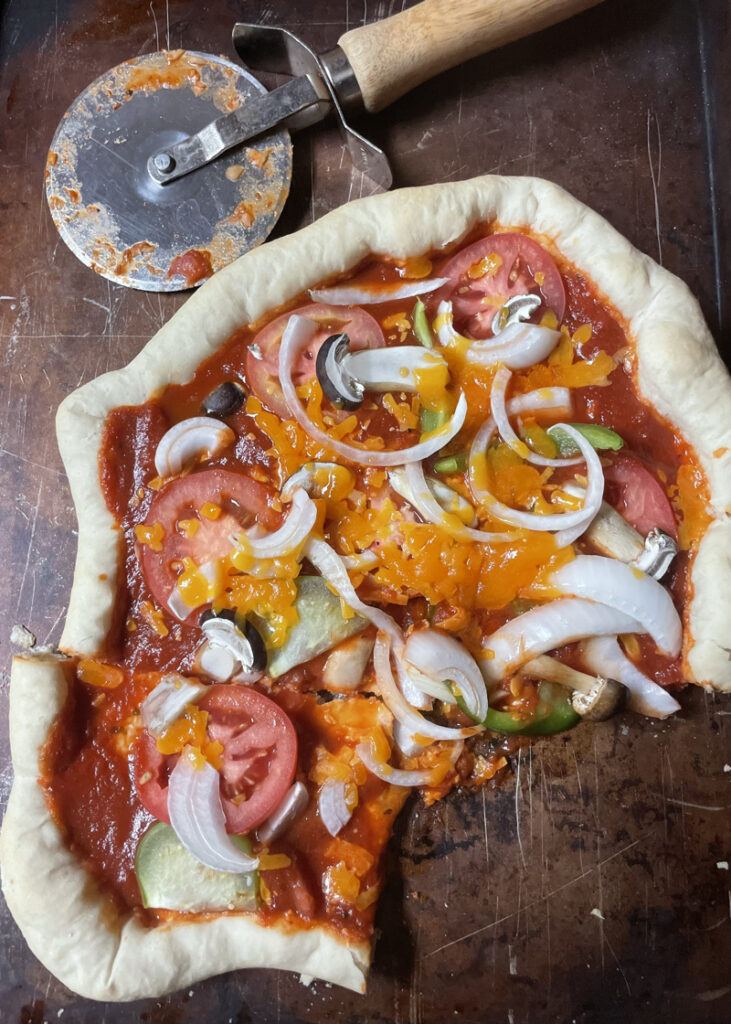
I love making homemade pizza! It’s definitely one of my family’s favorite summertime meals. It’s delicious, can be as simple or as complicated as you want to make it, and it takes just a moderate amount of prep to make something that is quite impressive! The wait time may be the hardest thing about this recipe, but it’s no worse than waiting on delivery—tipping the chef is optional!
While pizza may have been born in Naples, Italy, Americans have perfected the art of pizza. In fact, Americans eat 46 pounds of pizza per year—90% of it with their hands rather than a knife and fork! So we know people can shovel it down, but how did pizza really come about?
Well, the most famous story of the origin of pizza is that it was made in June of 1889 to honor Queen Margarita, of Italy. So the story goes, a Neapolitan pizzaiolo, or professional pizza chef, was tasked with creating a pizza in honor of the visiting Queen, who had never tried pizza before. After being presented with multiple options, Queen Margarita indicated she strongly preferred the pizza he created in the colors of unified Italy: red tomatoes, white mozzarella and green basil! Unfortunately, that’s probably just a modern myth: the pizza we now know as margarita was being made around Naples at least 100 years before the Queen’s visit. So we will probably never know who invented the margarita pie.
However, I don’t think it matters very much, since it’s undeniably delicious. The great thing about these personal pizzas is you can change up the pizzas to reflect whatever you want, and you know what—you can name the pizza too. This one is from my grandpa’s pizza dough recipe, so it could be called Grandpa Pizza I guess!
For the Pizza
- Dough Ingredients:
2-2 ⅓ cups all-purpose flour - 1 packet instant yeast (2 ¼ teaspoon)
- 1 ½ teaspoons sugar
- ¾ teaspoon salt
- ⅛-¼ teaspoon garlic powder and/or dried basil leaves (optional)
- 2 Tablespoons olive oil + additional
- ¾ cup warm water
Topping ideas:
- Sauce (from a can, a jar, or freshly made!)
- Cheeses (mozzarella, Parmesan, goat)
- Tomatoes (fresh or canned)
- Onion (Yellow or red, or green scallion)
- Peppers (Bell or hot)
- Plus whatever else you can think of—sausage or bacon, mushrooms, artichoke hearts, olives, pineapple (controversial, I know!), even slices of potato (with olive oil and rosemary)
Instructions:
- Combine 1 cup of flour, instant yeast, sugar, and salt in a large bowl. If you want, add the garlic powder and dried basil as well.
- Add olive oil and warm water stir well.
- Gradually add another 1 cup of flour. Add any additional flour as needed, stirring until the dough is forming into a cohesive, elastic ball and is beginning to pull away from the sides of the bowl . The dough will still be slightly sticky but still should be manageable with your bare hands.
- Drizzle a separate, large, clean bowl with olive oil and brush the oil around the bowl.
- Lightly dust your hands with flour or oil and form your pizza dough into a round ball and transfer to your olive oil-brushed bowl. Use your hands to roll the pizza dough along the inside of the bowl until it is coated in olive oil too, then cover the bowl tightly with plastic wrap and place it in a warm place.
- Allow dough to rise for 30 minutes or until doubled in size.
- *If you intend to bake this dough into a pizza right away, I also recommend preheating your oven to 425F at this point so that it will have reached temperature once your pizza is ready to bake.
Once the dough has risen, use your hands to gently deflate it and transfer to a lightly floured surface and knead briefly until smooth.
- Form your dough using either your hands or a rolling pin to work the dough into a circle (or a bunch of circles; you can turn this into three personal pizzas or one large pizza!) Transfer dough to a pizza pan and either pinch the edges up or fold them over and pinch to form a raised crust.
- Drizzle additional olive oil (about a Tablespoon) over the top of the pizza and use your pastry brush to brush the entire surface of the pizza (including the crust) with olive oil. Use a fork to poke holes all over the center of the pizza to keep the dough from bubbling up in the oven.
- Blind bake—in other words, bake in the oven for about 5 to 10 minutes until a light brown crust appears. Then take it out, add the desired toppings and put back in the oven for about five more minutes until the crust is golden brown and cheese is all melted.

Pumpkin Spice Puppy Treat

Ingredients
- 2 cups flour plus extra for dusting
- 1/2 cup canned pumpkin or pumpkin purée
- 1/4 cup water
- 1 egg
- 1/4 teaspoon ground cinnamon
Instructions
Preheat the oven to 325°F and coat the baking sheet with baking spray or a silicone mat .
In a large bowl, combine the flour, pumpkin, broth, egg, and cinnamon and mix well, until you’re able to knead the dough into a ball.
Dust a clean, dry section of your countertop with a little flour. Place the dough on the counter and use a flour-dusted rolling pin to roll it out until it is ½ inch thick (use a ruler!).
Prick the dough all over with a fork. Cut it into bones (or other dog-friendly shapes) with the cookie cutter!
Transfer the biscuits to the prepared baking sheet and bake at 325°F for 25 minutes, or until they are dried out completely. (Larger biscuits may require an additional 5 to 10 minutes of baking.) Remove the biscuits from the oven with oven mitts and let the biscuits completely cool on the baking sheet.
The biscuits will last for a month or so if kept in a zip-top bag on the counter.
PREP!
Preheat the oven to 325°F and coat the baking sheet with baking spray.
MIX!
In a large bowl, combine the flour, pumpkin, broth, egg, and cinnamon and mix well, until you’re able to knead the dough into a ball.
ROLL AND CUT!
Dust a clean, dry section of your countertop with a little flour. Place the dough on the counter and use a flour-dusted rolling pin to roll it out until it is ½ inch thick (use a ruler!).
Prick the dough all over with a fork. Cut it into bones (or other dog-friendly shapes) with the cookie cutter.
BAKE!
Transfer the biscuits to the prepared baking sheet and bake at 325°F for 25 minutes, or until they are dried out completely. (Larger biscuits may require an additional 5 to 10 minutes of baking.) Remove the biscuits from the oven with oven mitts and let the biscuits completely cool on the baking sheet.
It summer, and it’s getting hot—everyone deserves a treat now and then, not just us humans! Our furry friends, our dogs and even cats, also deserve good treats! These pumpkin treats are not only good for your pet, high in antioxidants and fiber and low in sugar, but are also good enough to snack on yourself!
I love dogs. People have loved dogs, it seems, for a very long time! In fact, in 2018 in Siberia. a patch of Permafrost melted enough for people to find the body of a two month old puppy—though this puppy wasn’t any ordinary puppy. After its almost perfectly preserved remains were found it was found out to be around 18,000 years old and is evidence one of the very first domesticated doggos! The frozen animal was nicknamed “Dog-or.” Not only is it the name for friend in the local language, but also it mashup the words “dog” and “or”, reflecting the scientists uncertainty. When you say it, it could be a dog OR it could be something else (like a wild ancestor)!
Despite its age, the puppy still had most of its fur teeth and cute little nose preserved. Scientists were unable to confirm what species it was from. They didn’t know if it was a dog a wolf something in between, because Dog-or comes from a time when wolves were becoming domesticated. Being able to place whether Dog-or genetically is more a wolf or dog would help us figure out the specific time that we started keeping dogs as companions. Dogs today belong to the sub species, “canis,” as the wolf. We can trace their origins back to an extinct species of wolf, as well. The ancestor they share with the modern gray wolf isn’t exactly known, but we can guess that wolves and dogs began to separate from each other about 40,000 to 20,000 years ago.
At the start of domestication, the dogs probably still looked very wolf-like, which also complicates things! But wolves and dogs are very special to people, because for thousands of years we’ve picked the best dogs for us! Dogs have been chosen to be friendlier, based on their hyper social ability and their ability to form tight packs. Being pack hunters and good scavengers that help care for their weak and sick members are both traits that became useful when human settlements were become more widespread, since human camps meant resources the canines definitely would’ve wanted! Ie food and snuggles!
Eventually, humans figured out that wolves once domesticated could be useful; they could be guards, and help with hunts. They would also help with domestication of other animals! Wherever is humans went, their canine companions followed in a domesticating process that may have happened many times over across many continents! But no matter how dog domestication happened—whether once or over and over!—your canis familiaris will still love these treats!
We even took a batch to the dogs of Pugz Not Drugz—and the pugs definitely approve! I hope your hard-working canine companions like these treats as much as our family and our family pets did!
This recipe was adapted from Christina Tosi’s Milk Bar Book.



Very Berry Birthday Crepe “Cake” (Crepes Revisited)
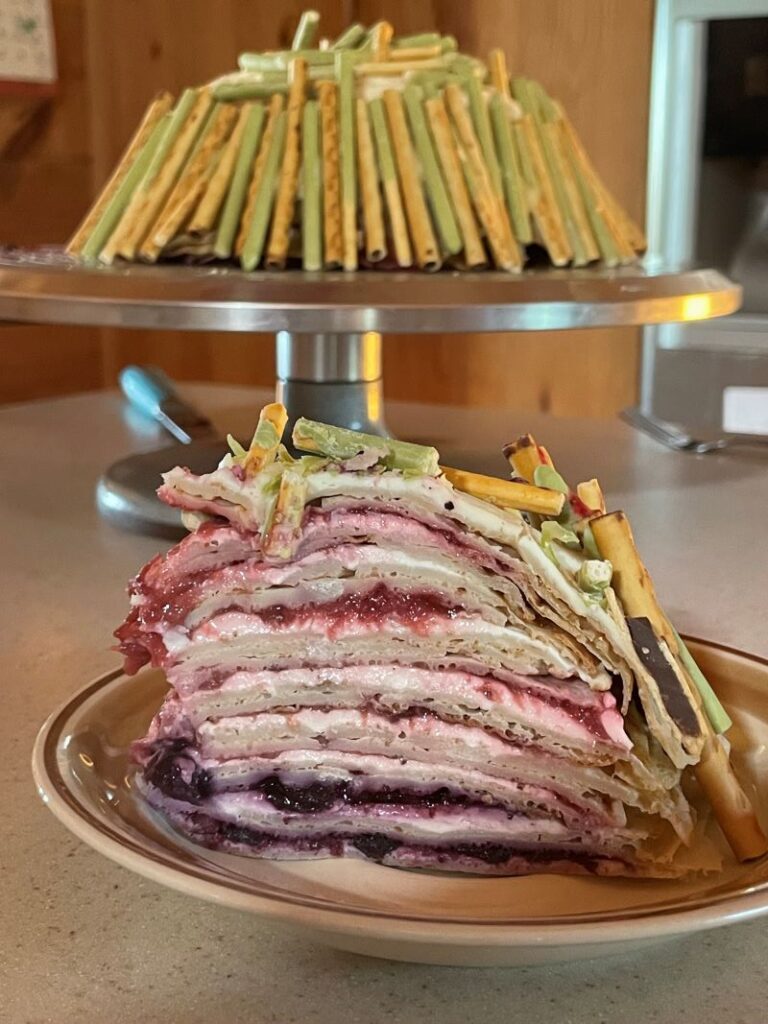
Crepes:
- 9 Tablespoons unsalted butter, plus 3–4 more Tablespoons for greasing the pan
- 3 cups all purpose flour
- 3 Tablespoons granulated sugar
- 1 teaspoon salt
- 3/4 cup whole milk times three at room temperature
- 3/4 cup water times three at room temperature
- 6 large eggs
- 1 1/2 teaspoons pure vanilla extract
Cream cheese filling
- 1 1/2 cups farmers cheese
- 1/2 cup cream cheese (4oz)
- 1/4 cup sugar
- 1 teaspoon vanilla extract
Strawberry filling
- 1 cup Strawberries
- 1/2 cup chopped rhubarb
- 3/4 cup sugar
- 1 teaspoon lemon juice plus more if needed
Blueberry filling
- 1 1/2 cup Blueberries
- 3/4 cup sugar
- 1 teaspoon lemon juice plus more if needed
Instructions
For the crepes:
- Melt 3 Tablespoons of butter in the microwave or on the stove. Cool for about 5 minutes before using in the next step. The remaining butter is for the skillet.
- Combine the cooled melted butter, flour, sugar, salt, milk, water, eggs, and vanilla in,a large mixing bowl and whisk by hand. Mix until everything is combined. The mixture will be silky-smooth and the consistency of cream.
- Cover the bowl tightly cover tightly, and chill in the refrigerator for 30–60 minutes and up to 1 day. (After refrigerating, if the batter looks separated, give it a quick stir before cooking in the next step—it’s ok!)
- Cook the crepes using the remaining butter for greasing between each crepe. Place a skillet over medium heat and generously grease it with the butter. Make sure you keep the crepes thin.
- Once the skillet is hot, pour 3–4 Tablespoons (closer to 3 is best) of batter into the center of the pan. Tilt/twirl the pan so the batter stretches as far as it will go. The thinner the crepe, the better the texture.
- Cook for 1–2 minutes, then flip as soon as the bottom is set. Don’t wait too long to flip crepes or else they will taste rubbery!! Cook the other side for 30 seconds until set. Transfer the cooked crepe to a large plate and repeat with the remaining batter, making sure to butter the pan between each crepe.
- If you want, separate each crepe with parchment paper so they do not stick together. If you’re using enough butter in your pan, though, the crepes shouldn’t stick!
For cream cheese filling:
- Put the farmer’s cheese and cream cheese together in a bowl, and mix until smooth. Add the sugar, vanilla, and mix until everything is combined.
- For strawberry rhubarb filling:
- Put the strawberries and rhubarb, covered with the sugar l, in a sauce pan and cook on low heat, giving a stir every once in a while
- When berries are slushy, pour into the blender and blend into smooth, the. return the pan and add lemon juice. Put back on low heat and stir just once in a while—the lemon juice will help it thicken cooked until desired thickness.
- Repeat process with the blueberry filling.
To fill the crepes:
After the crêpes are cooled, place a few spoonfuls of your cream cheese filling, then put your fruit filling on top. Repeat until all the layers are done, and then go around the outside of the crepe stack with cream cheese and delicious decorations (I used chocolate and matcha Pocky!) and enjoy!
It’s almost my birthday! That is why decided to test run a very special crepe birthday cake—really this is just an adaptation of my crepe recipe from April, but it’s still delicious! The fact that you can serve crepes multiple ways—including as a layer cake!—is to me what makes them so fun. While a savory recipe may be in the future, this week we had friends with kids in town visiting, so it seemed like a good time to take on a more time consuming method of crepe presentation that’s still super sweet. The “cooking crepes and stacking them” process takes some time, but if you have a friend and a good show to watch—I suggest the Pokémon North American championships, and anyone you can gossip with for forty minutes—it goes faster than you’d think!
Did you know, there’s a superstitious belief that if you hold a ring in your left hand and flip a crêpe successfully with your right, you will have immense wealth for the next year. My friend and I tried, but so far no birthday windfall! Give it a try if you want—if nothing else, you’ll end up with a super yummy stack of crepes, feeling like a million bucks!

Flan
June 2, 2024

It’s almost summer time, and this delicious dessert is perfect to eat topped with whipped cream and fruit, fresh or frozen. Flan is basically a type of custard, because it is made of eggs and milk. However, unlike most custards, you bake this one in the oven, though you still have to let it set afterwards. While the technique is unusual for a custard dessert, the idea of flan is pretty ancient, thought to be around 2000 years old. Back then it wasn’t uncommon for the recipes to contain fruit, wine and spices. And fish sauce—Yuck!
The Roman Empire in fact made flan with olive oil, grape wine, and fish sauce. Since the Romans were the first empire to domesticate chickens, and raise them for eggs, they in turn were the first to perfect custards! Personally, I don’t think the Roman custard sounds all that good, but I do have to applaud them for raising their own chickens! However, their custard wad probably closer to quiche than a modern flan, but they are similar ideas. Both recipes are essentially egg whipped with milk, but filled with different fillings. The Roman custard were known as “flado,” which translates to flat-cake. From flado it became the French “flaeon,” or custard tart, and eventually the word was modified to flan. Similar evolutions took place with the recipe undergoing little shifts: at some point during the Roman Empire, people started to make their flado with honey instead of fish sauce and olive oil. When the Roman Empire fell, these little cakes moved out across Europe, where the French and Spanish shifted the recipe even sweeter, with caramel and spices, to become the flan we know today.
I recommend this deliciously decadent custard with some whip cream and fruit (maybe sugared blueberries?)—though I guess if you want, you can have it with the fish sauce!
Ingredients
- • 3/4 cup Sweetened Condensed Milk
- • 1 cup Evaporated Milk
- • 3/4 cup Heavy Cream
- • 3 large Eggs
- • 1 tsp Vanilla Extract
- • 1/2 cup Sugar (for caramel)
Instructions
- Preheat oven to 350F.
- Take sugar in a pan, melt it gently on medium heat. Don’t stir. Keep cooking on medium heat till caramel color is reached. Once the sugar has reached caramel color, pour it into the pan and swirl the pan to coat the entire pan and the sides of the pan.
- Now take the rest of the ingredients in a blender and blend till creamy. Pour this into the pan over the caramel.
- Now place the first pan into a bigger pan filled with hot water half way up. Now pop this into a 350 degree oven and bake for 1 hour to 1 hour and 10 mins until firm but not cracked.
- Remove the flan from oven, gently remove the mould from the tray and place it into the fridge for a minimum of 2 hours or overnight (which is better!).
- To gently remove, slice the sides using a knife. Invert the mould on to a serving plate. Slice and serve.

Posted May 26, 2024
Better than Cheez-Its
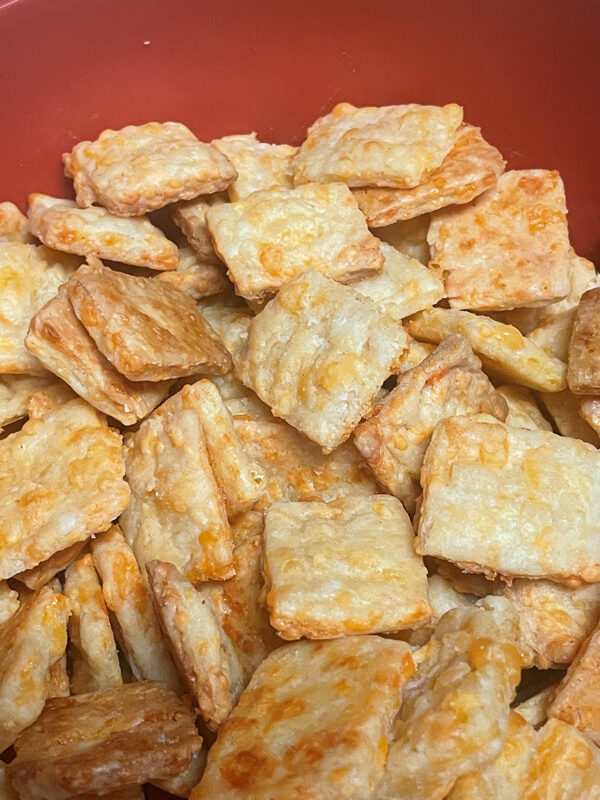
Ingredients
- 8-ounce block extra sharp cheddar cheese, coarsely shredded
- 4 tablespoons (2 ounces) cubed unsalted butter, at room temperature (can substitute cold coconut oil)
- 1 teaspoon kosher salt
- 1 cup (4 1/4 ounces by weight) all purpose flour
- 2 tablespoons ice water
Coarse salt to top
Instructions
- In the bowl of a stand mixer fitted with the paddle attachment, mix the cheddar, butter, and salt until soft and homogenous, like a cheesy play dough.
- Add the flour and mix on low speed, or even mix by hand; the dough will be dry and pebbly and pea sized.
- Slowly add the cold water and continue to mix as the dough clumps into a single mass again, but don’t over mix!
- Pat the dough into a rough rectangle, wrap tightly with plastic wrap, and refrigerate for at least 1 hour.
- Preheat the oven to 375 degrees F, and line two baking sheets with parchment paper or silicone mats.
- Divide the dough into two pieces and roll each into a very thin (1/8 inch or less) 10×12-inch rectangle.
- Using a fluted pastry cutter or a knife, cut the rectangles into 1-inch squares, then transfer to the baking sheets. If you want, you can use small cookie cutters to make your own unique shaped cheese snacks! I like to use letter cutters to make scrabble pieces out of my crackers! This is also the step where you can sprinkle the coarse sea salt for extra salty crackers.
- Use the tip of a chopstick to punch a hole into the center of each square, so that the air escapes and you end up with fluffy crispy evenly baked crackers.
- Bake for about 15 minutes or until the crackers are puffed and browning at the edges. Watch carefully, as the high fat content of the crackers makes it a fine line between golden brown and delicious and too brown and burnt!
- When they look ready, immediately move the crackers to cool.
When going on road trips, do you want to make sure that you have good snacks and good books? I do. I went on a long drive with my family last week, and can attest: these homemade “better than Cheez-Its” are perfect to eat on a trip! Bring a stash along to munch on with a good book or to snack on while playing game. Or, if you add letters to them, you could play scrabble with the snack itself! That’s one of my favorite ways to enjoy them, but there’s so many good ways to enjoy these crackers—they really do taste like everyone’s favorite red box cheese cracker snacks!
Do you know how the Cheez-Its originally started though? The very first cheez-it cracker was made in 1921 and was marketed as a “baked rarebit,” a reference to a dish of melted cheese over toast. It was originally patented by a company called Green&Green Co., which was run by Weston Green, his father John, and his brother Joseph. In 1930, Green&Green Co., was bought by Smiles Biscuit Co, later Sunshine biscuit company a.k.a. the sunshine label we all know and love. The red box and sunshine logo stayed on the Cheez-It box even after Keebler bought sunshine in 1996, though it is less prominent on modern packaging.
One note about the crackers: the cheese in Cheez-Its crackers is real cheese! This fact has been touted since their humble rare-bit beginnings! Until the 1980s, the original cheddar was the only choice—but since the 1980s, more than 50 flavors have been introduced, from sour-cream-and-onion to jalapeño-cheddar-Jack to hickory-smoked-Provolone to sizzlin’-bacon. When making these at home, I strongly recommend trying out new flavors by changing up the types of cheese and/or adding spices and herbs. Dried green chile is one of my favorites, but bacon bits is a close second!
The companies that have sold Cheez-Its over the years have had a lot of interesting ideas for marketing, including in 2019 when Cheez-It SNAPS came out. Kellogg’s hid a years worth of those snaps crackers in a bunker in New York City, and slowly leaked the information about it on Twitter, one clue at a time. Whoever “discovered” the bunker would receive the rights to a year supply of crackers—and a pretty cool hide out. The winner did in fact get one year supply of Cheez-Its, as well as a streaming subscription and a brand new big screen tv to watch on while munching on crackers. Maybe someday I can make my own secret Cheez-It lair—a kid can dream—but till then, it’s fun to make these!

May 18, 2024 -Greek salad
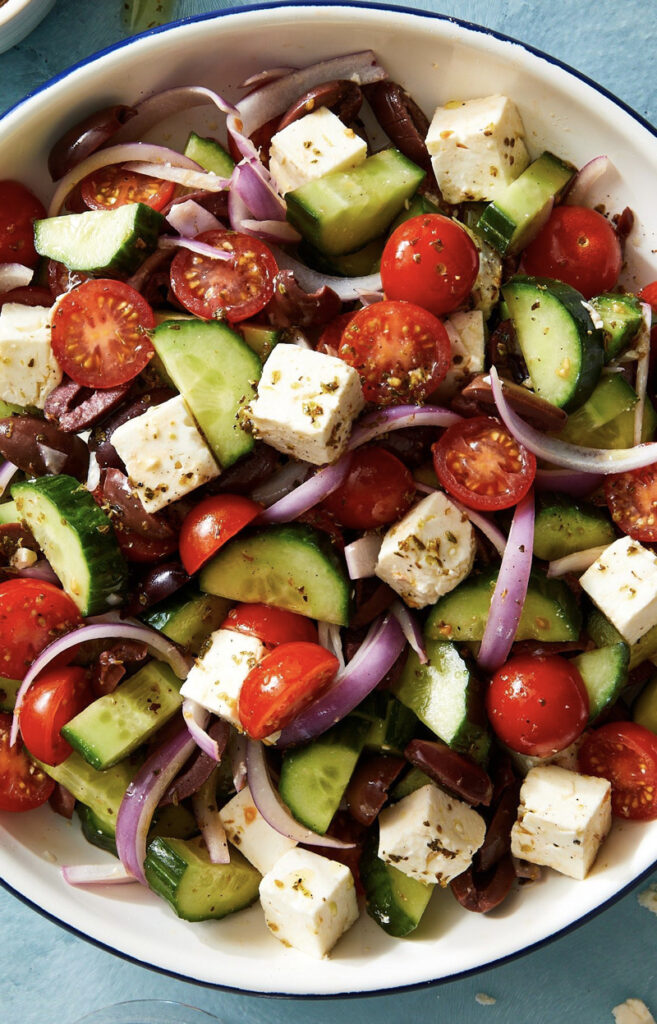
Dressing:
- 1/2 cup extra-virgin olive oil
- 2 tablespoons lemon juice
- Two tablespoons red wine vinegar
- 1/4 teaspoon Dijon mustard
- One clove of garlic finally minced
- 1 teaspoon dried oregano
To taste:
- Salt
- Pepper
Salad
- 4 medium sized tomatoes, diced
- One medium sized cucumber, sliced
- One small red onion, diced
- One green bell pepper, sliced
- Half cup, Kalamata, olives, pitted and chopped
- 6 ounces feta cheese, crumbled
Instructions
- In a glass jar with a lid, mix the dressing ingredients well. Set aside.
- For the salad, mix the cut up tomatoes, cucumber, red onion, and bell pepper mix together, and crumble the feta cheese on top. Add the olives.
- Top with mixed dressing, toss well.
This is a quick, traditional Greek salad recipe for “high summer,” when the fruits of the field start to ripen. It might seem familiar to you, if you’ve ever had what the Greek’s call an “American Greek Salad!” Basically, that’s this same set of ingredients, served atop lettuce! Basic Horiatiki, or “village snack,” can be served up in a lot of different ways—from bulgar wheat being added on the island of Crete, to the lettuce Greek-Americans added in the 1960s in Chicago! For late spring/early summer in Raton, I do think kale, Swiss chard, and lettuces or other greens are all good options and are other good variations of this simple recipe!
The salad has great textures and simple, bold flavors, and is a fast recipe you can whip up for dinner, lunch—or even breakfast (I guess!) Pair it with chicken soup for a deliciously light soup and salad combo!

May 12, 2024-Chicken and Dumpling Soup

- 1 chicken, without offal
- 1 onion peeled and chopped
- 5 cloves garlic minced
- 3 sticks celery, diced OR 1/2 cup dried celery
- 3 medium carrots roughly chopped
- 2 medium potatoes chopped into bite-size chunks
- 1 small squash, chopped OR 1/2 cup dried squash slices
- 1 can beans of your choice, or 2 cup soaked beans of your choice
- 1 bay leaf
To taste:
- Salt
- Pepper
- Oregano
- Marjoram
- Thyme
- Water to cover
Egg drop noodles:
- 1 egg
- 1 teaspoon salt
- 1 teaspoon paprika or red Chile
- 3/4 cup flour
- As much water as needed
Instructions
- Add your whole chicken, minus its guts unless you like them, to a crock pot and add your herbs and salt to taste. Cover with water. Cook low and slow until the meat is falling off the bones. This may take up to 8 hours, but can be done ahead of time!
- Remove the chicken from the bones; discard the bones. (Save the wishbone for a wish!)
- Add the chicken, onion, garlic, celery, carrots, potatoes, squash, beans and bay leaf, salt, pepper plus the reserved chicken stock to a stove pot.
- Give it all a good mix then place the lid on and cook for approximately an hour on high, until all the veggies are tender.
- For dumplings, in a separate bowl mix the dry ingredients: flour, salt, chili power/paprika.
- Add egg and water until the mixture is waffle batter consistency.
- Drop this mixture into the boiling soup pot one spoonful at a time.
- Cook another 5-10 minutes until the dumplings are puffy and firm.
- Serve in a bowl with a slice of nice warm sourdough and a salad!
Chicken noodle soup is one of my favorite food to eat in winter, but you don’t have to wait till it’s snowing outside to have this recipe! My mom hasn’t been feeling well and chicken noodle soup is definitely a good way to tell her happy Mother’s Day, too! And is there a better way to eat the soup than a salad to go with it? As a bonus, there’s a recipe for Greek Salad also!
As for the chicken! People have been eating chicken according to the historical record for at least 6000 to 7000 years—which is a long time to come up with recipes! One of the most popular cookbooks of the 18th century, Hannah Glass’s, “The art of cookery made plain and easy,” had many chicken recipes. She began writing it to make some cash, since she and her husband were poor, but it was a complicated endeavor because there were no standard measures yet. She went out of the way to write her book for common people, with common words so everyone could understand it. That might’ve been why it was so popular! While her book isn’t nearly as popular today, another big name classic in the world of chicken, Campbell’s—Joseph Campbell and his famous soup!—certainly is, even after 150 years.
Joseph Campbell went into business with Abraham Anderson, forming Anderson and Campbell. They started out with tinned vegetables and mincemeat. I’m not an expert, but I think that’s pretty far away from soup! Campbell brought up Anderson’s portion of the company in 1876, and his new partner Arthur Dorrance was a business man who saw the value of products with long shelf life. Soon they were more known for their canned beef steak and tomato ketchup. Another shift came in 1889, when they changed their name again to the Joseph Campbell Preservative Company—a really long name. Soon after, Campbell stepped down as president. Now Dorrance took over, and finally in 1895 they released their first can of soup!
Campbell’s started getting closer to the company we all know today, with a very popular beef steak tomato soup. It was so popular with restaurants in fact that they had to send enormous 36 ounce cans of soup—more than two pounds at a time! It was heavy and expensive to ship. John Dorrance solved this problem and changed the future of soup. He had his chemistry department working to condense tomato soup, just like condensed milk. And in 1898 he succeeded. Figuring out how to remove the water from the company’s tomato soup, he created the first marketable condensed soup. The company soon capitalized on the idea, since it took less aluminum to make smaller cans that people then added their own water to. The first lineup of condensed soups included steak tomato soup, vegetable soup, chicken and oxtail soups. The soups were an instant success! The design of the soup cans was changed to the iconic red and white.
In 1930, Campbell’s released the first radio ads, including their now famous “Mmmm, mmm good!” Jingle. In 1934, their advertising department recorded an ad for their “noodles with chicken soup”. Noodles with Chicken soup?? Does that sound familiar? Well, the voice actor for the ad accidentally scrambled his lines and said “Chicken Noodle Soup,” and orders began to pour in from across the country for Campbell’s chicken noodle soup! They ultimately just altered the name of their product, since that’s what everyone wanted!
By the Second World War, Campbell’s was a household institution with over 1 million cookbooks in print. But their fame was still growing! In 1962, pop artist Andy Warhol premiered his “32 Campbell’s soup cans” paintings in Los Angeles as a tribute to his mother. His family, Czech immigrants who mined coal in Pennsylvania, only had Campbell’s soup as a luxury during the Great Depression when Warhol was a child, and the decadence of the sixties—with soup on every shelf!—influenced his art greatly. The premiere itself was not very big, and only six of the paintings were bought at that time—one of them by Dennis Hopper! But still, it shook the foundations of the art world, bringing about arguments about what constituted art, and whether the soup can counted! The humble soup can was forever etched into pop history from that moment forward.
By the turn of the 20th century, people began to watch how much salt they were eating, and more and more turned away from Campbell’s high sodium soups entirely. Campbell’s signed onto the sodium reduction policy, cutting the amount of salt from their projects by as much as 45%. However, after funding some scientific studies looking at the relation between sodium and hypertension, the company reversed again and put all the salt back in the soup! They were on unsteady ground still, and by 2019 Campbell’s had huge amounts of debt and was on the brink of collapse. All that changed in 2020 however, when people began to stock up on the iconic cans as a quick and easy staple—but salt discussion aside, I really do like this soup better than the canned! It makes over a gallon of soup at a time, which is plenty to freeze for later or share with a neighbor. You can customize it with whatever veggies you have on hand. Plus it is extra hearty because of the homemade dumplings, which my nana learned how to make from her nana!
So this Mother’s Day, from my nana’s nana to her to me, and from me to you, I hope you enjoy some hearty chicken and dumpling noodle soup!


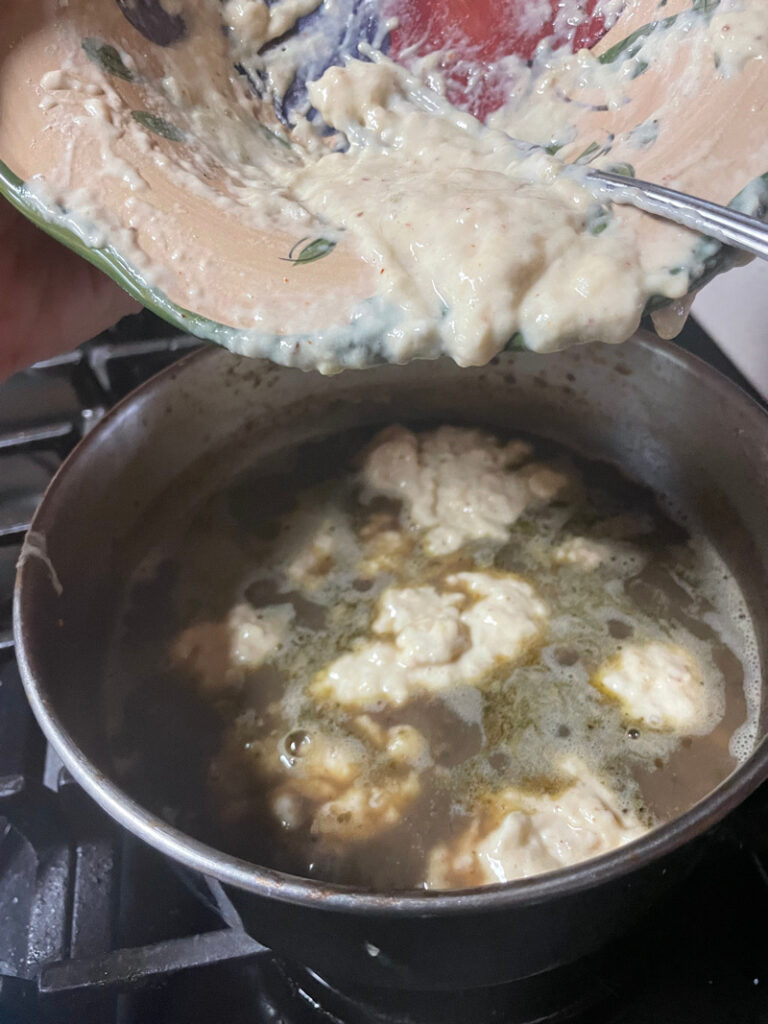

April 28, 2024 – Chinese Fried Rice
- 2 cups cooked rice, cooled/refrigerated
- 1 egg, beaten
- 2 oz fresh shrimp, peeled
- 1/2 onion, diced
- 1/2 cup sausage
- 1/4 cup frozen peas
- salt to taste
- sugar to taste
- shaoxing wine or white wine vinegar
- oyster sauce
- 1 green onion
- pinch pepper
Step one: In a pan, cook the meat and onions, and any other veggies, except peas.
Set aside in a bowl.
Step two: In the same pan, pour olive oil in and turn to medium heat, add rice and cook for about minute while stirring, crack the egg in, and add the cooked veggies, meat and peas.
Step three: When all that is cooked through nice together, turn off heat and add your seasonings.
Enjoy this best really hot (in temperature) I think.
There is an online cooking program known as Cultured Kids Cusine, a nonprofit who’s mission is to teach kids about cultures all over the world by exploring their food. I love their free classes! One of my favorite recipes that I have learned from them is fried rice.
Not only is it absolutely delicious, it’s simple too. And fried rice is perfect anytime of year, but it’s best with fresh veggies, like green onions, scallions, peas etc. The veggies may be best fresh, but I have a trick question for you!
What type of rice do you think is best for fried rice?
- A. Freshly made rice
- B. Rice that’s been sitting in the fridge overnight
- C. Raw rice
Believe it or not, leftover rice is the best rice for the job! Leftover rice that has sat overnight has dried out some and has less moisture. That means it soaks up the seasonings without getting soggy! Fresh rice just doesn’t work the same; it works, but it’s not as good. And raw rice? That was just a joke–I really wouldn’t suggest it.
Fried rice is a good food for beginner cooks because one, it’s easy and two. It’s very flexible. You can add basically any veggie and meats you want into it. Feel free to mix up the vegetables and proteins–spring garlic instead of green onion, tofu instead of sausage or shrimp, or throw in some bell pepper or carrots!
No matter how good you are–or are not!–at cooking, you can probably make fried rice. It’s simple and delicious.

Posted April 23, 2024 – Pecan Shortbread
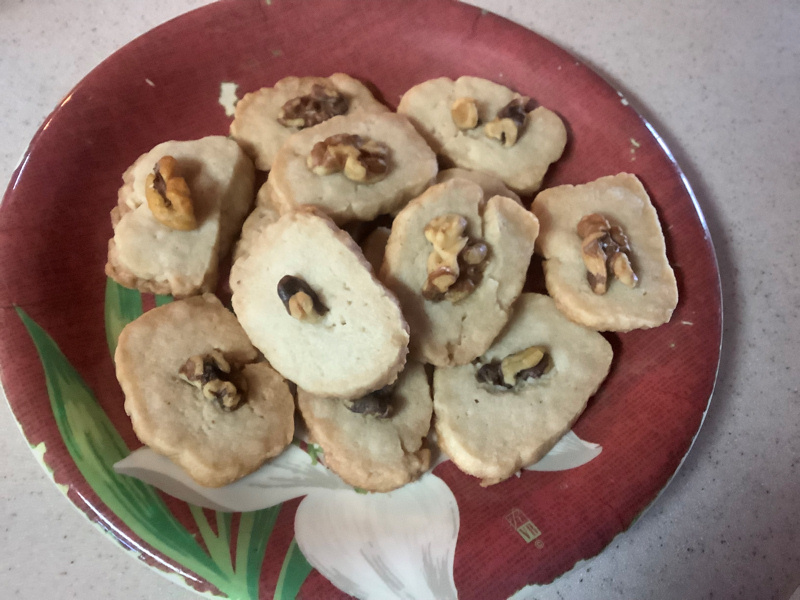
I love rainy afternoons; that’s the perfect time to read a good book and cuddle under a blanket. On a not-quite-warm-yet spring afternoon, a sweet treat hits just right. The toasty New Mexican pecans make this shortbread a solid choice for hot chocolate dunking, but it also goes well with a warm mug of tea!
Did you know, pecans are one of the few native grown nuts we can buy commercially today in the United States, and the only native nut we can grow here in New Mexico? While Georgia is the top producer of pecans in the US–which is kind of funny since pecans aren’t native to Georgia–New Mexico is a very respectable second place when it comes to pecan producing states. Most pecans in New Mexico are grown in the southeast part of the state, and every single pecan produced has the potential to grow into a tree over 100 feet tall that can live for centuries! That’s because each one is also a seed. As a seed, every nut also has different genetics, so there are tons of different varieties of pecans. Some have thicker shells, and some have thinner shells. Some need less water or grow faster in the heat. They all taste different too!
So, when you try to make this shortbread, maybe try a few different varieties of pecans out–you never know which one you will like best! Shortbread is a great basic biscuit; since it doesn’t have many strong flavors, its buttery texture is the star taste! This makes it great for adding toppings, like pecans or a drizzle of chocolate. They’re easy–the hardest part is waiting for the log to cool so you can get on to the baking part! You can also substitute coconut oil for the butter, in a one-to-one ratio, to make this recipe a vegan hit!
Pecan Shortbread Cookies
- 3/4 cup pecans coarsely chopped, toasted
- 10 tbsp unsalted butter at room temperature
- 1/2 cup confectioners’ (powdered) sugar
- 3/4 teaspoon kosher salt
- 1 1/2 cups all-purpose flour
- 1/2 teaspoon cinnamon
- 1/4 teaspoon allspice
- 1/4 teaspoon nutmeg
- 1/4 teaspoon cloves
- 2 tablespoons water or enough to make dough combine
- Toast chopped pecans on a baking sheet until browned.
In a stand mixer fitted with a paddle attachment, beat butter and confectioners’ sugar, vanilla and salt at medium until fluffy.
Whisk spices and flour together in a bowl.
Add flour mixture in and beat on low until almost combined then scrape the bowl down and mix in the toasted pecans. If the dough is crumbling, add water, starting with a tablespoon at a time. Usually two is about correct, but it may be more or less depending on a lot of factors!
- Roll dough into a log then wrap in parchment paper.
- Refrigerate for at least 1 hour. Add parchment paper to baking sheets.
- Preheat to 350F. Cut log into ½ inch thick rounds.
- Transfer to baking sheet. Space with 1 inch between.
- Bake for 10 minutes. Rotate baking sheets in the oven. Bake for another 10 minutes or until golden brown.
- Move to a wire sheet to cool.

Posted April 14, 2024 – Spring Asparagus Pasta
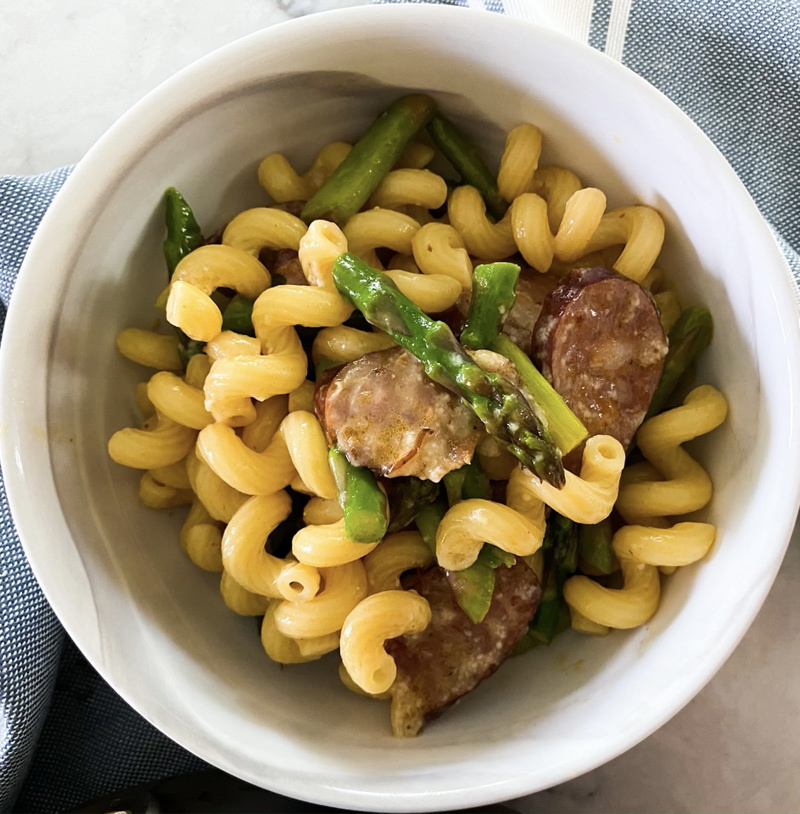
Spring can be a difficult season-but after the long cold, the first spring plants are very welcome! Even when there’s still snow in the ground, the first “spring” garlics and onions planted in the fall are coming up long, thin, and tender, but delicious! Asparagus is another vegetable that comes early and spring and pairs well with lemon. Adding some local meat in the form of sausage really takes this spring recipe over the top!
Asparagus is old—really old! 5000-year-old asparagus was found in Egyptian tombs, and ancient poems tell us that the Greeks prized it as well, searching for it and harvesting it in swampy marsh areas. And it was so popular with the Romans that someone used the term faster than asparagus is cooked! That meant it was something happening really fast—because you have to watch out. Asparagus, being so new and tender, cooks almost instantly. This recipe isn’t quite THAT fast, but it is a good busy weekday choice, because cooking the pasta is really the longest step.
One small note: asparagus—the fruit where the seeds come from—is actually poisonous to humans! So if you are growing asparagus, make sure kids and dogs stay away from the bright, cheery looking berries it puts on when summer starts! But other than that one small downside, asparagus has been loved in Raton for a long time. Old coal camp histories mention the asparagus growing in Sugarite—since it’s such a long lasting perennial and comes back year after year without really anything special, it’s a great low maintenance vegetable even today!The older, non commercial varieties of asparagus can be really pretty—they come in different colors like green, purple and white (though, the white ones are otherwise colorful asparagus that has been covered from the sun, so it hasn’t formed any coloring compounds!) White asparagus is also sweeter and thicker than green—if you’re feeling fancy, the white and green varieties would make for a beautiful dish!
After a hard day, nothing is better than being able to go to the asparagus patch and make yourself some delicious pasta. Maybe enjoy it with a friend!
One Pan Spring Pasta
Ingredients
- 1 pound (16 oz) ground sausage
- 1/2 cup diced green onion
- 1 clove garlic, minced
- 3 cups uncooked pasta
- 3 cups chicken broth
- 3 cups 1-inch asparagus pieces
- 1/4 cup minced fresh or dried dill
- Pinch red pepper flakes (more to taste)
- 2 tablespoons fresh lemon juice (about 1/2 a lemon)
Directions
- Heat a large, deep skillet with a cover over medium- high heat. Add sausage and cook, breaking up sausage until browned and cooked through, about 8 minutes. Add garlic and green onion, and cook for 1 minute or until it smells good.
- Add uncooked pasta and chicken broth and turn heat to high. Stir, and cook covered, for about 10 minutes, stirring occasionally so pasta cooks evenly.
- When pasta has about 3 minutes cook time remaining, stir in asparagus.
- When pasta is cooked to your liking, add in Parmesan, dill, red pepper flakes, and lemon juice. Stir to combine and serve.



Posted April 7, 2024 – Strawberry Rhubarb Crepes
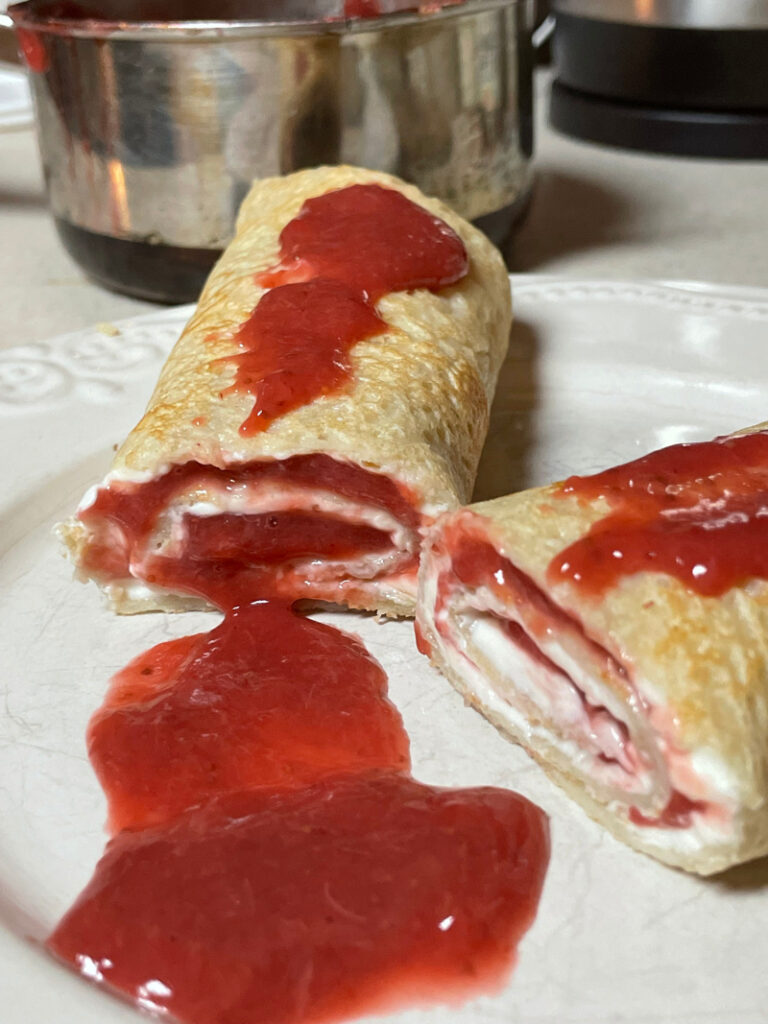
Rhubarb is one of the first fruits—really, a sweet vegetable—to come up in spring. It has been popular in our region for over one hundred years, brought by miners who liked its tart flavor and early appearance after a long winter. I’m not sure how the folks in the mining camp liked their rhubarb, but I think there is no better way to eat it than in crepes with cream cheese and strawberries!
Crepes sounds like a fancy treat but it really is not that fancy. They are made from very simple ingredients you probably have lying around your kitchen, and while a special crepe pan helps, you can make them easily in a regular frying pan. What actually makes this recipe special, in my opinion, is the filling!
We are lucky to be able to grow our own rhubarb here in Raton, but did you know, the Rhubarb Triangle, an area of Britain outside of South Yorkshire grows enough rhubarb to satisfy all of Britain, and used to grow enough rhubarb for the world! At their peak, they supplied 90% of the world’s commercial rhubarb, and every single stalk is picked by hand in candlelight! The rhubarb is grown for two years outdoors to create a strong root, and then moved into a dark shed to “force” the rhubarb up without any exposure to strong light. The plant turns the stored root energy into glucose, or sugar, making for an extra sweet-tart treat! But even regularly grown rhubarb doesn’t need any preparation to eat it, you can just eat it straight out of the ground. Just don’t eat the leaves! The leaves contain a lot of oxalic acid and can make you sick—only eat the crispy crimson red stems.
The other star component in the filling is strawberries, another early garden contender. Strawberries have been held in high regards since the 18th century but that wasn’t always the case. In pre-modern Europe, there were three different strawberries, but all were smaller and rounder than our modern berries. They were also significantly tougher and less less sweet than modern hybrids. In fact, strawberries remained mostly wild fruits until Virginia strawberries were brought back from North America and crossed with varieties from South America to create the garden strawberry. There are now many kinds available, and they can be preserved in many ways, including frozen, if you don’t have any fresh ones for the year yet!
Put together, these two spring favorites make for a delicious filling for your basic crepes! Try making some for someone you love, and impress them with this “fancy” dish!
Ingredients
Crepes:
- 3 TBS butter, melted; +3 TBS for pan
- 1 cup all-purpose flour
- 1 TBS granulated sugar
- 1/8 teaspoon salt
- 3/4 cup milk, room temperature
- 1/2 cup water
- 2 large eggs
- 1 1/2 TSP vanilla extract
Cream cheese filling :
- 1 1/2 cups farmers cheese
- 4 OZ cream cheese (1/2 cup)
- 1/4 cup sugar
- 1 TSP vanilla extract
- Fruit filling :
- 1 cup strawberries
- 1/2 cup rhubarb, chopped
- 1/2 cup sugar
- 1 teaspoon lemon juice plus more if needed
Instructions
For the crêpes
Melt 3 Tablespoons of butter in the microwave or on the stove. Cool for about 5 minutes before using in the next step. The remaining butter is for the skillet.
Combine the cooled melted butter, flour, sugar, salt, milk, water, eggs, and vanilla in,a large mixing bowl and whisk by hand. Mix until everything is combined. The mixture will be silky-smooth and the consistency of cream.
Cover the bowl tightly cover tightly, and chill in the refrigerator for 30–60 minutes and up to 1 day. (After refrigerating, if the batter looks separated, give it a quick stir before cooking)
Cook the crepes using the remaining butter for greasing the pan between each crepe and put a skillet over medium heat and generously grease it with some of the reserved butter.
Once the skillet is hot, pour approximately 3TBS of batter into the center of the pan. Tilt/twirl the pan so the batter stretches as far as it will go. The thinner the crepe, the better the texture, but if there’s big lumps, that’s actually ok too!
Cook for 1–2 minutes, then flip as soon as the bottom is set. Don’t wait too long to flip crepes or else they will taste rubbery! Cook the other side for 30 seconds until set.
Transfer the cooked crepe to a large plate and repeat with the remaining batter, making sure to butter the pan between each crepe.
For cream cheese filling:
Mix cream cheese together in a bowl with sugar, vanilla, and lemon until everything is smoothly combined.
For strawberry rhubarb filling:
In a sauce pan, put the strawberries and rhubarb into the pan, covered with the sugar and put on low heat, giving a stir every once in a while
When berries break down, blend into smooth purée and return the pan. Add lemon juice; the lemon juice will help it thicken. Cook until desired thickness.
To fill the crepes:
After the crêpes are cooled, place a few spoonfuls of your cream cheese filling in the center of the crepe. Spread it around so there’s an even layer and then add the fruit filling.
Fold opposite sides slightly in, then turn crepe like you are going to roll a burrito. Roll it up!
Crepes are delicious with toppings, too, such as a drizzle of melted chocolate and powdered sugar, or any combination of fruits and nuts!
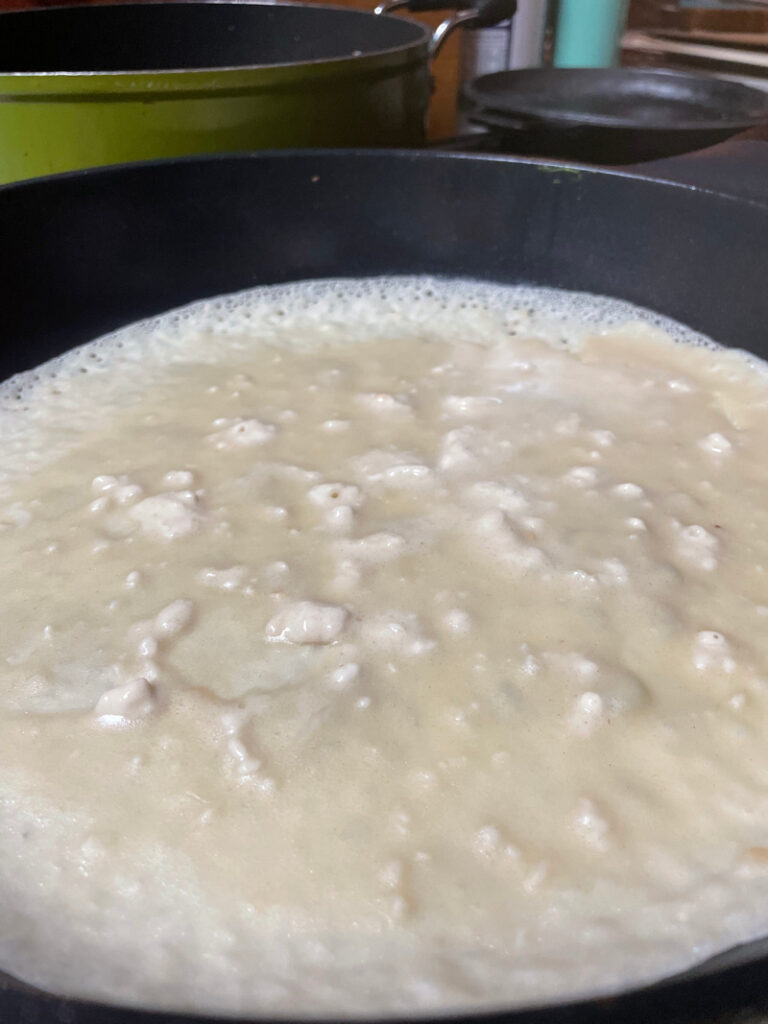
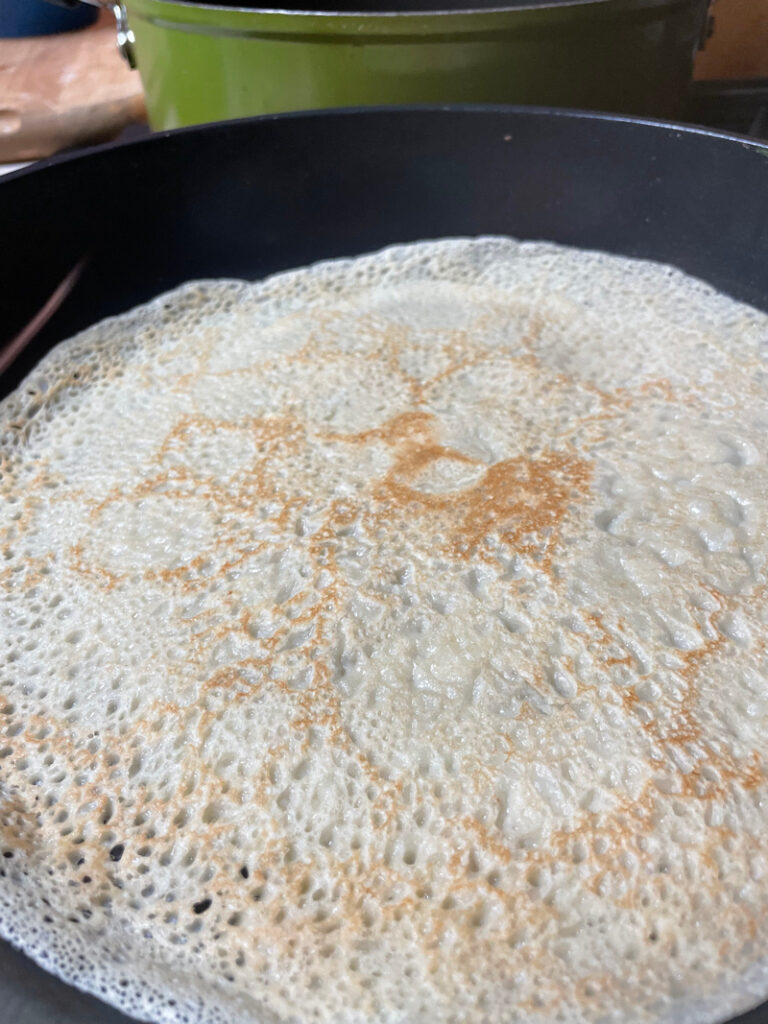

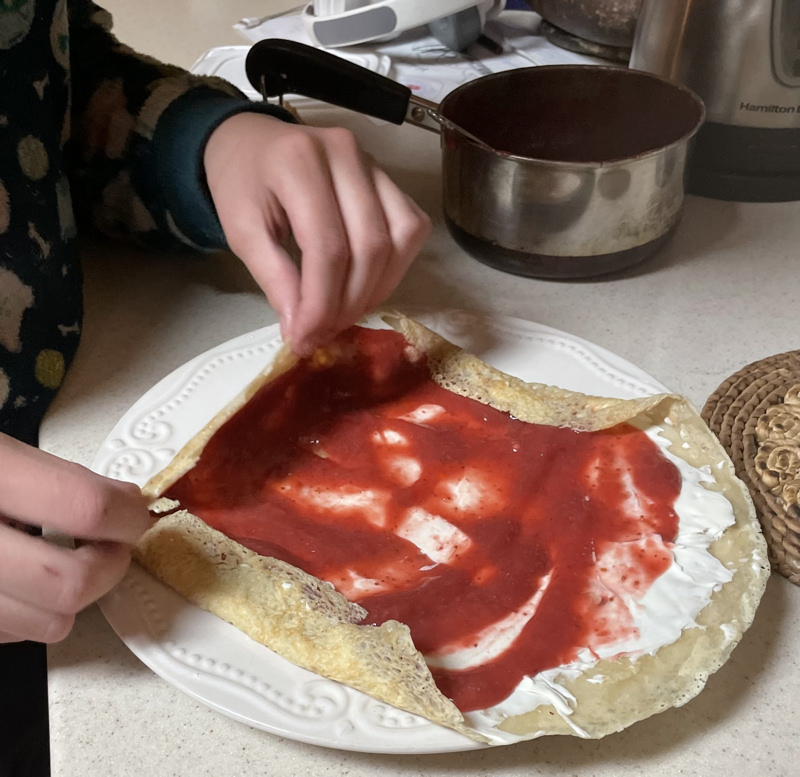


March 31, 2024 – Homemade Marshmallow Peep
Happy Easter!
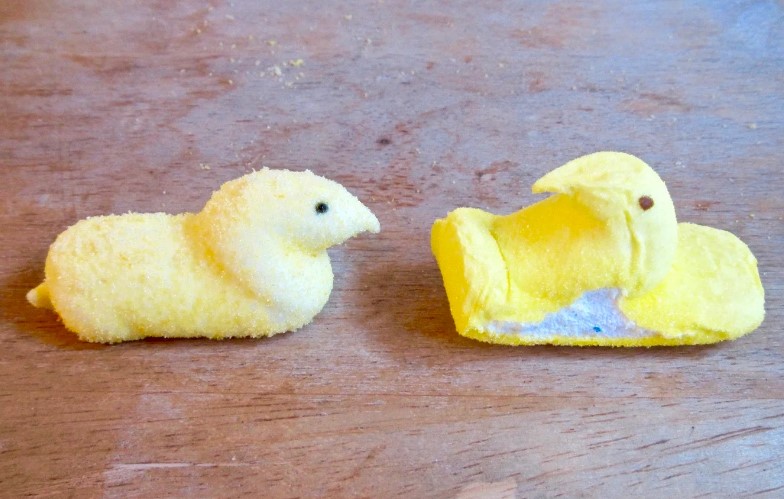
Today’s recipe is a classic Easter treat, along with chocolate eggs, chocolate bunnies, and jelly beans—Peeps™️! Or at least, a homemade version of the smooshy, yellow little marshmallow treats. The Peep may be well known, but less well known is how marshmallows began their culinary journey into an Easter staple.
Marshmallows were originally made from the root of the marshmallow plant, which like its name implies can be found growing in marshes. In fact, the ancient Egyptians who lived and farmed along the Nile were likely the first to squeeze sap from the mallow plant and mix it with nuts and honey, but no one really knows what the candy would have looked like in those times. The French were the first to introduce the modern fluffed marshmallow candy in the early 1800s. Owners of small confectioneries whipped sap from the mallow root and poured the sweet concoction into a candy mold. The mass produced marshmallow as we know today in the USA did not exist until years later, when a patented machine was made to extrude the marshmallow syrup. One thing hasn’t changed throughout 2000 years of marshmallow making is that you don’t want to burn your syrup—so patience is key!
That said, you can make marshmallows in a variety of ways. Some recipes call for egg whites to get the marshmallow to set up faster. Others call for them to be made without egg whites but with gelatin instead: those set slower, but are really good! This week’s recipe calls for gelatin, which is made from animal collagen, but if you want a vegan alternative, agar-agar is made from seaweed and sets just as well! It’s also likely a traditional ingredient from the ocean marshes, same as the mallow.
In fact, that seaside association long stuck with the marshmallow. Over 120 years ago, newspapers raved about “the latest thing in the way of summer resort diversions! The simplicity of this diversion is particularly charming, and the idea is sure to grow in favor.” It was referring to the the new-fangled idea of marshmallow roasting! They were talking about the young people at beach resorts, roasting marshmallows over the bonfire—not people camping out in the mountains! That may be what we think of as the way to eat them today—roasted over a campfire—but it wasn’t always that way, clearly!
However you like your marshmallows—shaped like a bird, whipped into fluff, roasted on a fire or maybe, mixed with nuts and honey Egyptian-style—enjoy a few this easter!
Marshmallow recipe
INGREDIENTS:
- Butter for greasing
- 3 envelopes of un-flavored gelatin (7 teaspoons)
- 1⁄2 cup of cold water
- 2 cups of granulated sugar
- 1 cup of light corn syrup
- 2 tsp of vanilla extract
- 1⁄8 tsp of salt
- 2⁄3 cup of confectioners’ sugar, plus more for dusting the pan
INSTRUCTIONS
1. Grease a 9×13 inch baking dish well with butter or if you’re going to pipe peeps, grab a cookie sheet and put a silicone mat or parchment paper down.
2. In the bowl of a stand mixer (or a large heat-proof bowl), mix the cold water and gelatin. Set aside while continuing the rest of the steps.
3. In a medium saucepan, add the sugar, corn syrup, and 1⁄2 cup of water. Stir gently to combine. Put the pan over medium-high heat and bring it to a boil. Keep cooking the mixture until it registers 235-240 ̊F on a candy thermometer or cooking thermometer.
4. When the sugar syrup reaches the right stage, remove it from the heat and let it cook slightly.
5. Turn the standmixer with the gelatin and water mixer on medium speed and slowly pour in the sugar syrup. Alternatively, you can use an electric hand-held mixer and have someone help you pour the syrup mixture in.
6. Once all the syrup has been added, mix on medium-high speed for 10-12 minutes, or until the mixture is white and it makes stiff peaks. Add the vanilla extract,and salt. Mix for 1 more minute to fully combine.
8. Pour the marshmallow mixture into the greased pan, and using a greased spatula or spoon, spread the marshmallow out evenly. Dust with powdered sugar and let set. Cut into marshmallow cubes when cooled (6 hours).
- For bird shaped marshmallows, put marshmallow paste into a piping bag. Pipe a body, and then a head, pulling the piping bag away from the face, sideways, to make a “beak”. There are good videos to follow online. You can roll even them in colored sugar to make them extra fancy!

March 24, 2024 – Hot Cross Buns
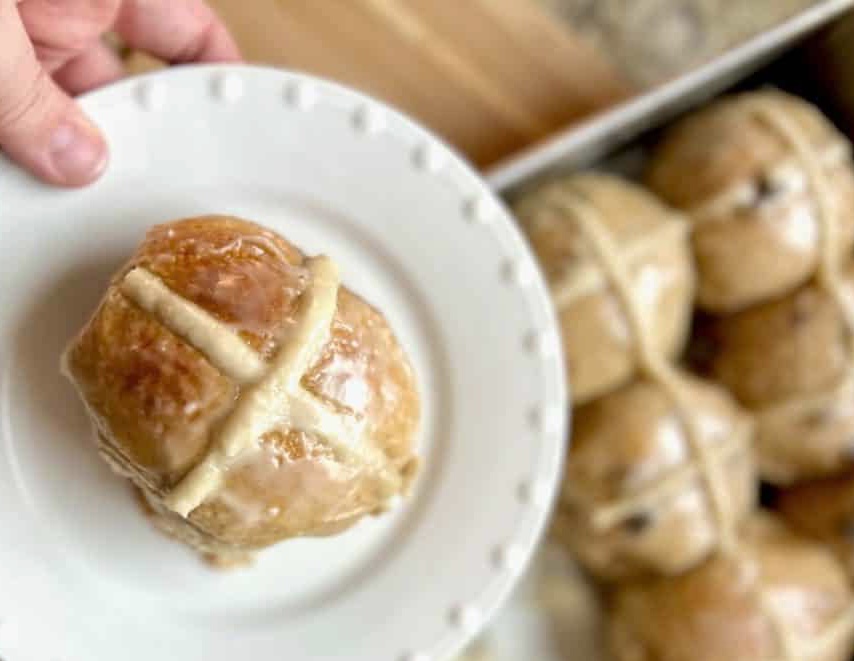
It’s officially spring—on the calendar!—and also Easter Season. This week’s Hot Cross Bun recipe, then, is perfect because it actually used to be illegal to sell hot cross buns on any day except Christmas and Good Friday. An exception was made for funerals, too.
Nowadays, there are many different types of hot cross buns—and you can get them or make them any day of the year. Fun variations on the standard bun can include hot cross chocolate chip buns, gluten-free buns, buns with icing in place of the traditional sugar dough, and even savory hot cross buns with bacon crosses! Today’s take uses New Mexican elderberries in place of the usual raisins or currants, but other than that consider it a jumping off point to try your own unique variations.
Historically, hot cross buns were hung from the kitchen rafters for a whole year, and replaced each Good Friday. The belief was that they would ward off evil spirits because of the cross on top, and sometimes were taken as a folk medicine as well. They were popular with the common people of the United Kingdom long before the hot cross bun song came along. But the song didn’t actually start as a rhyme 300 years ago. It was one of the earliest examples of a marketing jingle! It was used as a street cry to market buns, and the street sellers probably said something more along the lines of, “Hot cross buns, hot cross buns, one a-penny, two a-penny!” to advertise their pricing: one large bun or two small buns for a penny!
A cute but lesser known Irish rhyme says this about the buns: “Half for you and half for me, between us two, good luck shall be!” So share one of these with a friend, and ensure an extra lucky friendship in the coming year! Also, come back next week for an extra special Easter recipe—
Peep peep!
RECIPE:
Dough:
- 1 cup hot juice
- 3/4 cup dried fruit
- 1 package (0.25 oz) active dry yeast – (equiv. to 2 ¼ teaspoons)
- 3/4 cup warm milk
- 3 to 3 1/2 cups bread flour, plus more as needed
- 1 teaspoons Kosher salt
- 3/4 teaspoon ground cinnamon
- 1/4 teaspoon ground allspice
- 1/8 teaspoon ground nutmeg
- 1/2 cup granulated sugar, plus 1 teaspoon
- 6 tablespoons unsalted butter, melted and cooled (I use coconut oil)
- 2 large eggs, beaten
- 1 tablespoon orange zest
Flour paste for cross:
- 1/2 cup all-purpose flour
- 3 to 5 tablespoons water
- 1 tablespoon granulated sugar
Egg wash:
- 1 large egg
- 1 tablespoon heavy cream or whole milk
Sugar glaze:
- 1/2 cup granulated sugar
- 6 tablespoons water
- Egg wash: whisk 1 large egg and 1 tablespoon heavy cream or whole milk. Brush buns with egg wash after they have risen.
Instructions:
* Soak dried fruit in juice of your choice. Traditionally, that might be raisins or currants in apple cider, but I’m using elderberries and elderberry juice. Let sit for about 30 minutes. Then, drain and set aside. Pat dry.
*Set up the dough hook attachment of a stand mixer if you have one. In the bowl, add the warm milk (about 110-115 degrees F, or feeling warm to your hand) and active dry yeast, along with 1 teaspoon granulated sugar to wake up the yeast. Stir and let it stand for 10 minutes until foamy.
* In a large bowl, whisk the flour, salt, cinnamon, allspice, nutmeg, and sugar. Set aside.
*With the mixer on low speed, add half of the dry ingredients to the yeast mixture until just combined (keep using the dough hook if you have it). Then add melted butter, eggs, and the other half of the dry ingredients, and mix.
*Increase to medium speed and mix for about 5-6 minutes, adding more flour as necessary until it pulls away from the bowl and is slightly sticky but manageable.
*Add the raisins(or whatever dried fruit you choose) and orange zest, and mix until incorporated, about 30 seconds.
* Transfer to a floured surface and knead a few times until smooth, elastic, and slightly sticky.
*Form into a ball and place on a lightly oiled bowl (olive oil is fine), making sure to coat the dough with some of the oil. Cover with plastic wrap and let it rise in a warm and draft-free environment for about 1 hour, or until doubled in size.
* Punch down the dough and transfer to a floured clean surface. Knead a few times, and cut the dough into 12 equal pieces. Shape into balls, pinching at the bottom, and place on a lightly greased sheet pan or baking pan. Cover and let rise about 30 minutes in a warm and draft-free environment, until doubled in size.
* Preheat oven to 375 degrees F.
Flour paste for the cross: combine the 1/2 cup all-purpose flour, sugar, and water. Add the water, 1 tablespoon at a time, until you get a thick but pipeable paste. Fill a piping bag with the paste and pipe over the buns to form a cross on each bun.
* Bake at 375 degrees for 20 to 25 minutes, until golden brown and puffed. Remove buns from oven. Cool for 10 minutes.
* Meanwhile make the sugar glaze: in a small saucepan combine sugar and water. Bring to a boil and simmer about 10 minutes, until thickened.
* Brush hot cross buns with the sugar glaze when cool.

March 17, 2024 – Corned Beef and Cabbage
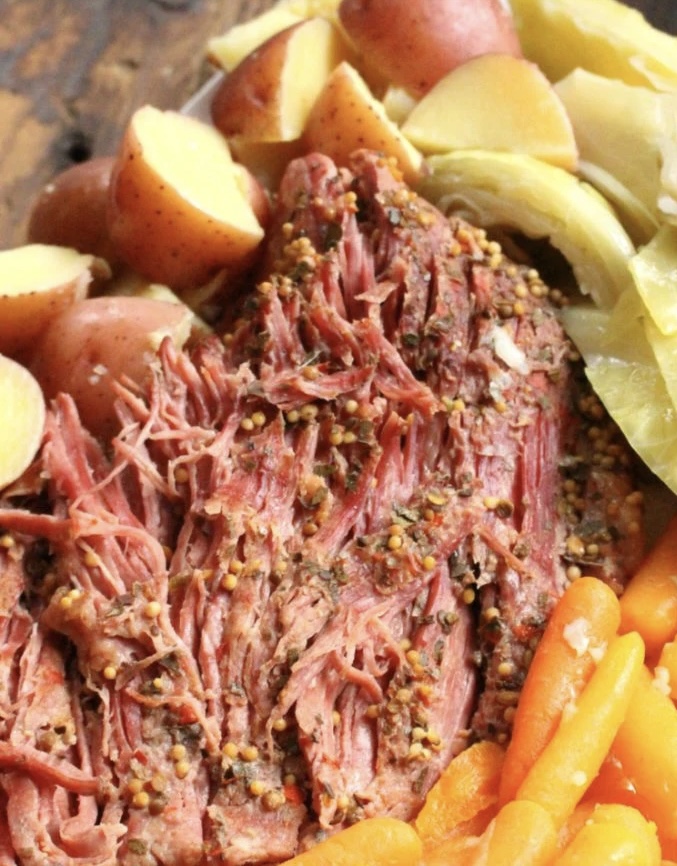
It’s St. Patrick’s Day, the day of leprechauns and silly green hats, pots of gold at the end of the rainbow, and best of all: corned beef and cabbage. Corned beef and cabbage the way we enjoy it today is associated with Ireland, but hasn’t been particularly popular there until recently!
Salted beef, however, was popular across Europe and the Middle East during the Middle Ages, especially in the British Isles. It wasn’t common further north in Ireland and Scotland though. There, cows were a symbol of wealth and a sacred animal. Because of their sacred association, they were only killed for their meat if the cows were too old to work or produce milk. So, beef was not even a part of the diet for the majority of the population. When they had beef, they usually salted it too so they would last longer. In fact, the corned part of corn beef and cabbage is referring to the size of the salt on the meat: “corns” refer to grains like rye or wheat in Britain, and not maize corn. Still, that’s pretty big salt!
But corned beef wasn’t produced at a large scale until the British Industrial Revolution and the Cattle Acts. The Cattle Acts stopped the export of live cattle to England, the biggest market for beef in English-controlled Ireland. That flooded the Irish market with more cattle than anticipated and lowered the cost of meat available for salted beef production. In turn, the Irish corned beef became a huge export to Britain, where it fed the British Navy and the British colonies—but not the Irish.
Most Irish first met corned beef in America, after 1845. When Phytophthora infestans, the potato blight, hit Ireland, it wiped out much of the potato fields, all planted with the iconic Irish Lumper potato. The susceptible plants—almost all of them, since they were only one variety!—turned to mush, and the Irish turned to America. Landing on the east coast, many of these new immigrants settled near other new immigrants from Eastern and Central Europe. The corned beef the Eastern European Jewish immigrants made was from brisket, a kosher cut of meat that is a much tougher cut. Brining it transforms the meat into the extremely tender, flavorful corned beef we know of today.
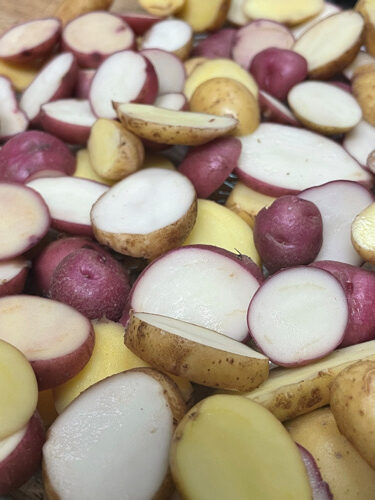
Most recipes call for late winter cabbage to be added in addition to root vegetables. Onion, carrot, and of course, the staple potato are all recommended. My family likes to add potatoes and carrots to corned beef and cabbage. We all think it needs the potatoes and carrots—both are deliciously sweet and earthy when added to the salty meat. I suggest you try potato varieties other than the Lumper, though!
I hope you enjoy this recipe—it makes the perfect leprechaun bait, and if it does happen to lead you to the pot of gold at the end of the rainbow, then your St. Paddy’s Day is doubly lucky! But even without all that, you’ll feel like a million bucks when you have this simple classic.
Corned Beef with Veggies
Ingredients:
- 10 baby potatoes, quartered
- 4 large carrots, cut into matchstick pieces
- 4 cups water
- 1 (4 pound) corned beef brisket
- 1 head cabbage, coarsely chopped
- 3 bay leaves
- 1/2 tbs coriander
- 1/2 tbs mustard seeds
- 2 tsp salt
- 1 tsp pepper
- 1/2 tsp juniper berries
Directions:
- Place potatoes and carrots into the bottom of a slow cooker; place brisket on top of vegetables. Pour water over brisket; sprinkle over spices and cover.
- Cook on High for 7 hours; stir in the cabbage and cook for 1 more hour.
- Serve with a pat of butter and enjoy!

March 10, 2024 – Mashed Potato Leftover Waffles
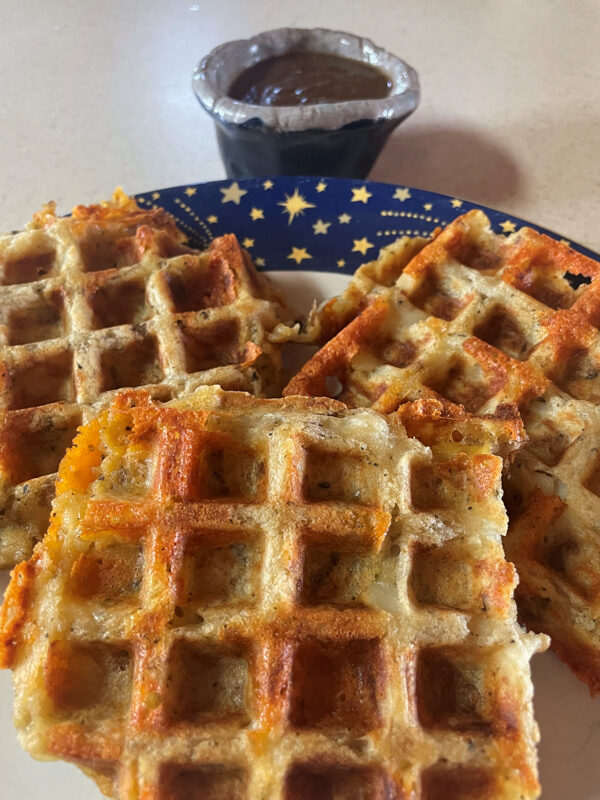
With daylight saving time here, it’s time for spring cleaning, so here’s a delicious recipe to tackle some of those leftovers in your fridge!
In fact, this week’s recipe is even an adaptation from a “leftover” library book—picked up at the AJM library books sale! Christina Tosi’s “Milk Bar: Kids Only” is a great book (you can also check out a copy from the library). Her leftover waffles can be made with just about any type of leftover—Spanish rice, extra cookie dough, mac and cheese, cut up hotdogs and waffle batter!—but my favorite is mashed potatoes. You heard that right—mashed potato waffles (with cheese).
In England and Ireland, these have been a junk-food-adjacent staple since 1981! The pioneering frozen foods company Bird’s Eye took a chance on a junior advertising agent’s suggestion and the potato waffle in a box was born. Quickly beloved, the boxed waffles are sold frozen, and may be baked, grilled, or fried. However they’re cooked, they stay nice and light and airy. They can be just a snack, or a side dish, or eaten as a breakfast with sausages or bacon.
But best thing about potato waffles, especially the ones you make yourself, is there’s no rules for eating them. You can stuff them with cheddar or cream cheese, put in bacon bits, or a handful of green onion. And then there’s the toppings! You can use a huge range of toppings. If it goes with potatoes or waffles, it’ll work with this. I like to use sour cream on mine personally, but you could use anything from maple syrup to mushroom gravy.
Speaking of mushrooms: yuck. I’m not a fan. Their texture, the flavor, all of it. However, my family really likes mushrooms, and gets very excited for mushrooming season. In the spring, when it’s warm and wet, you can forage for mushrooms outside in northern New Mexico and Colorado. You can also try all kinds of interesting mushrooms from the store. If you don’t have fresh mushrooms or aren’t a fan of their texture though, you can use dried mushroom powder, like I did for the bonus gravy recipe!
However you eat your potato waffles, I hope you enjoy them!
- Mashed potato leftover waffles
- 2 1/2 cups mashed potatoes
- 1/2 cup cheddar cheese (or whatever cheese you would prefer) cut into small squares
- 1/4 cup flour + more on reserve if needed
In a medium sized bowl, pour the mashed potatoes, cheese and flour. Start with the recommended amount of flour, keeping in mind you can always add more if it’s too watery. Once you have that mixed, it should feel kind of like Play-Doh.
- Preheat the waffle maker or stovetop waffle iron. When your waffle maker is preheated take some of the mashed potato dough and form it into a waffle sized pancake shape. Most waffle makers will fit 4 of them at a time.
- Cooked until the green light appears (on most new waffle makers) or until it is crispy and golden.
- Let them cool on the wire rack a bit and then enjoy.
This recipe makes about 8 standard waffles.
Mushroom Gravy
1/4 cup extra-virgin olive oil
1/4 cup onion, finely chopped
1/2 cup mushrooms, finely chopped
OR – Mushroom Gravy
1 1/2 tablespoon dry mushroom powder
1/4 cup all-purpose flour
2 cups stock (or water)
1/2 teaspoon soy sauce, more to taste
1/8 teaspoon black pepper
- In a large skillet, heat oil over medium-high heat. Add onion and mushrooms or mushroom powder; cook, stirring, until well browned, 8 to 10 minutes.
- Sprinkle in flour and cook, stirring, until golden brown, 3 to 5 minutes.
- Slowly whisk in vegetable stock, a little at a time, until a smooth sauce forms.
- Simmer 2 to 3 minutes until thickened and season with soy sauce, salt and peppers.
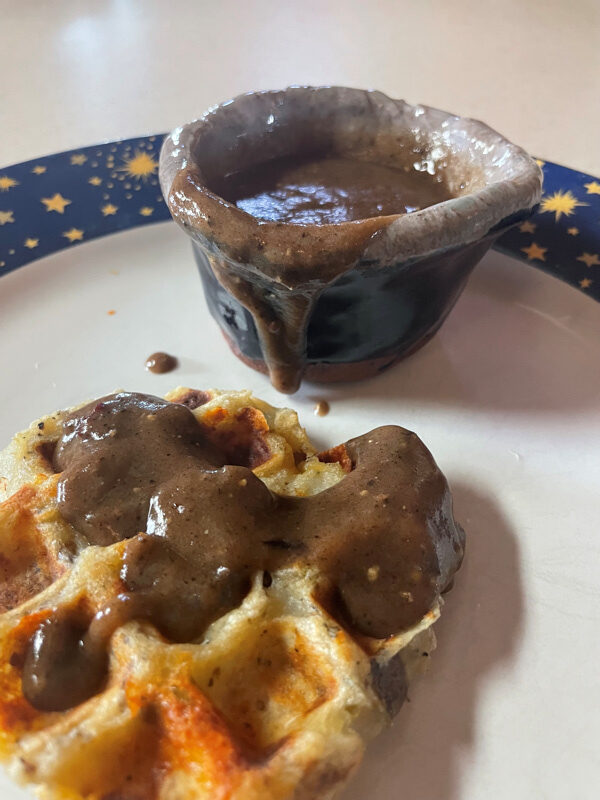
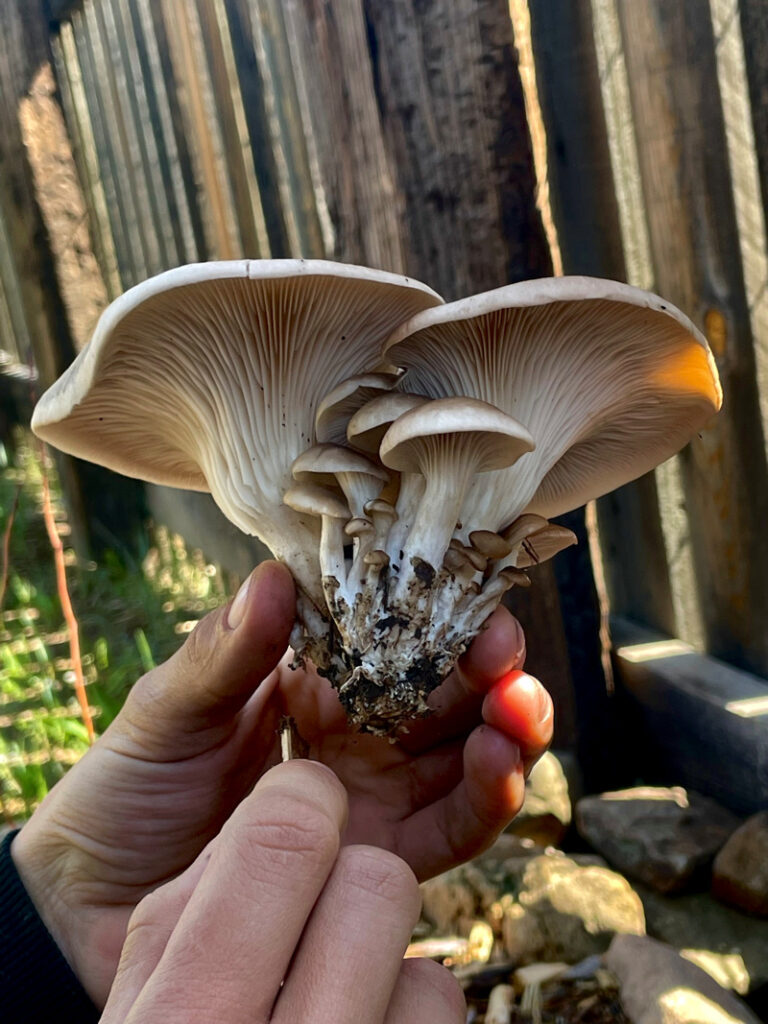

March 3, 2024 – Basic Egg Bread
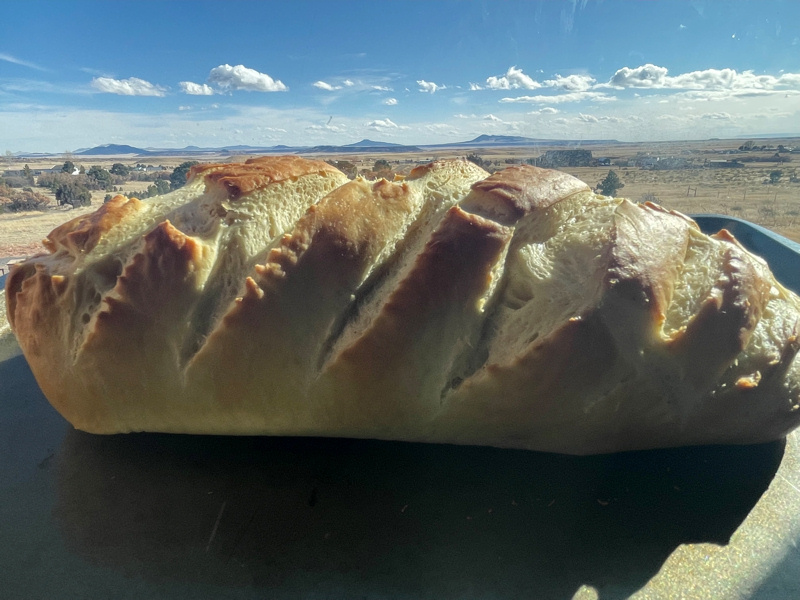
Egg bread is one of my family’s favorite recipes! All it is really is an enriched bread—or a bread that’s higher in fat because of its egg, milk or butter content. In this case, the bread is filled with lots and lots of eggs. Enriched breads take longer to rise, but are a lot softer and more tender. Since they are so soft, braiding them helps them keep their shape. The recipe I’m using today makes two medium sized braided loaves, but usually, I make a double batch. Not only does it make four good sized loaves—enough to share with family and friends—but it also uses 18 eggs that way! Since we have chickens, that’s OK; we have excess eggs!
This is a basic recipe that is popular all over the northern hemisphere: used for brioche French toast in Korea and Japan, known for rolls on the islands of Hawaii (and on Thanksgiving dinner tables across the mainland USA!), braided up as challah for a Kosher treat or eaten as pasca in springtime in eastern Europe. It’s even found down in the boot of Italy, where they make a variation of this bread called Easter bread, or Pane de Pasqua. Their take on Easter bread is a soft, flaky brioche, like this egg bread, decorated with colored eggs and topped with colored sugar or sprinkles. The eggs can be dyed raw and set into the bread, where they’ll bake as the bread cooks (though, it’s best to poke a small hole in the eggs to keep them from exploding!)
It’s kind of the perfect centerpiece for an Easter gathering, because then you can use the leftover Easter bread with eggs to make yourself an egg salad sandwich! Just slice yourself a few slices of bread and crack open the eggs from the bread to make a quick Easter Day dinner. But egg sandwiches aren’t all it’s good for; this bread is good for a lot of things. It’s great for French toast, if you want to use up the rest of your extra egg white from the recipe. If you want to get REALLY fancy, you can try stuffed French toast (ie a French toast sandwich stuffed with jam and cream cheese!) It is also good for grilled cheese sandwiches and will make an extra toasty golden brown lunch. You could also tear it up to make bread pudding, and add spices or dried fruit, or even citrus peels. any extra dough you have rolled up with cinnamon sugar makes good little cinnamon roll bites. Like I said, there are lots of options. Maybe you’ll even be called to make Easter bread sometime soon—whatever you do with this recipe, I’d love to see!
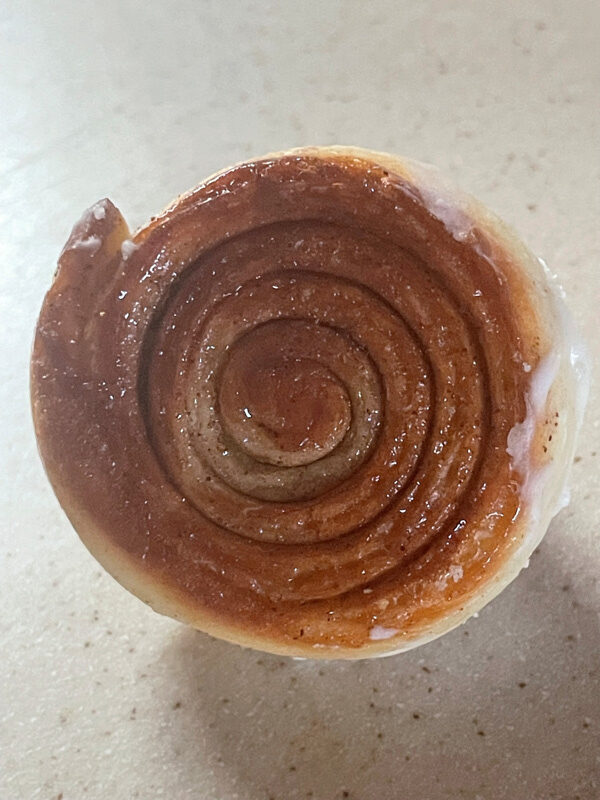

Ingredients:
- 4 1/2 teaspoons active dry yeast
- 2/3 cup warm water
- 6 large egg yolks
- 3 large eggs, at room temperature
- ½ cup vegetable oil
- ¼ cup white sugar
- 1 teaspoon salt
- 4 ½ cups all-purpose flour
- 1 pinch salt (did you know: a pinch, officially, is 1/8 tsp)
Directions:
Dissolve yeast in warm water in a large bowl and let stand until yeast softens and foams—about 5 minutes.
2. Stir in 6 egg yolks, 3 whole eggs, oil, sugar, and salt. Mix in 3 1/2 cups to 4 1/2 cups of flour to make a soft, sticky dough. Usually about 4 cups is right, but it could be a little more or less.
3. Turn dough out onto a lightly floured surface and knead until smooth and elastic, about 7 minutes.
4. Transfer dough to a well-oiled bowl and turn until entire surface is coated with oil. Cover with a damp cloth and let rise in a warm place until doubled in volume, about 1 1/2 hours. Punch down the dough and divide into thirds. Roll each piece into a 12-inch long rope. Braid the three strands together and seal the ends. Transfer the bread to a cookie sheet.
5. Whisk the egg whites with a pinch of salt; brush on top and sides of bread. Set eggwash aside. Let bread rise until doubled in volume, about 45 minutes.
6. Preheat the oven to 375 degrees F. Brush bread again with eggwash.
7. Bake in the preheated oven until golden, about 15-35 minutes (depending on the shape of bread; less for buns, longer for loaves).
8. Cool on a wire rack. Enjoy.
*A note, this recipe makes two medium sized loaves, or about 18 rolls.

February 25, 2024 – Nana’s Favorite Chocolate Chip Cookies
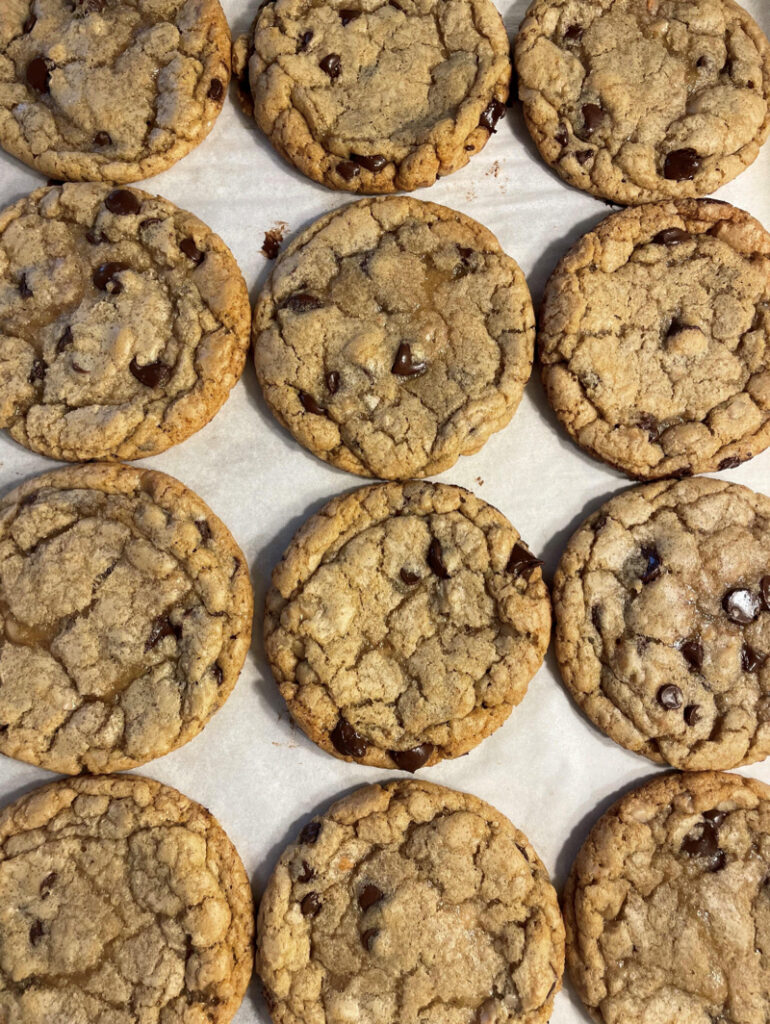
A warm cookie and a cold glass of milk is a great way to end the day, but baking those cookies yourself makes them even better! Homemade cookies rarely last long enough to get stale, unlike cookies that have been sitting on a store shelf for weeks. In fact, these cookies are so good, my nana calls to ask me for the recipe! If it’s nana approved, it has to be good! I think it’s mostly because the chocolate chips in these cookies stay melty for an unbelievably long time in a way that store-bought cookies can only envy.
Before the first chocolate chip cookies could ever hit the shelves, however, someone had to come up with the idea for chipped chocolate! The very first chocolate chip cookie recipe was invented by an inn owner named Ruth Wakefield, who ran the Tollhouse Inn. In 1937 she printed the recipe in the “Ruth Wakefield’s Tollhouse Tried and True Recipes Cookbook” where the cookies were billed as “Chocolate crunch cookies”—because chocolate didn’t come in chip form yet! Ruth Wakefield chopped up semi-sweet Nestlé candy bars to make her cookies. The cookies were a huge success, and Nestlé’s chocolate sales in New England, where the Tollhouse Inn was located, had bumped up by 500% by 1939. That’s a lot of chocolate!
That same year, Nestlé came knocking on Ruth’s door to get her official endorsement, and she soon reached an agreement with Nestlé to add her recipe to the chocolate bar’s packaging in exchange for a lifetime supply of chocolate—and a dollar. (She never got the dollar, but still a pretty good deal, I think!) She gave the company the right to use her recipe as well as the Tollhouse name.

But these chocolates were still in bar form, only they now came with a chopping tool and pre-indented score lines. It wasn’t until 1941 that Nestlé and at least one of its competitors started selling the chocolate in “chip” form, which they called morsels. WWII saw Nestlé and these new chocolate morsels campaigning to bring Tollhouse cookies to our boys fighting overseas—”Dear Mom!” one postcard recipe read, “The Boys will make you an honorary General if you’ll just send us more Tollhouse cookies!”
I can’t promise this recipe will help you become a general, but these chocolate chip cookies are perfect for any occasion. You could give them as a gift…or you could just bake them for yourself!
Ingredients
- 2 and 1/4 cups all-purpose flour
- 1 teaspoon baking soda
- 1/2 teaspoon salt
- 3/4 cup unsalted butter, melted & cooled
- 1/2 cup packed brown sugar
- 1/2 cup granulated sugar
- 1 large egg + 1 egg yolk, room temperature
- 2 teaspoons pure vanilla extract
- 3/4 cup semi-sweet chocolate chips or chocolate chunks, whatever brand you prefer
Instructions
- Whisk flour, baking soda, and salt together in a large bowl. Set aside.
- In a medium bowl, whisk the melted butter, brown sugar, and granulated sugar together until no brown sugar lumps remain. Whisk in the egg and egg yolk. Finally, whisk in the vanilla extract.
- **The mixture will be thin. That’s ok!
Instructions continued
- Pour the wet ingredients into dry ingredients and mix together with a large spoon or rubber spatula. The dough will be very soft, thick, and appear greasy and shiny.
- Fold in the chocolate chips. The chocolate chips may not stick to the dough because of the melted butter, but do your best to combine them!
- Cover the dough tightly and chill in the refrigerator for AT LEAST 15 minutes.
- Meanwhile, preheat oven to 350°F. Line baking sheets with parchment paper or silicone baking mats (I prefer reusable mats!). Set aside.
- Using an ice cream scoop, scoop the dough and roll into a ball. Repeat with remaining dough. Place 8–9 balls of dough onto each cookie sheet. These cookies will spread and stay chewy so space generously!
- Bake the cookies for 12–13 minutes or until the edges are very lightly brown. The centers will look very soft, but the cookies will continue to set as they cool, so pull them earlier rather than later!
- Cool on the baking sheet for 10 minutes. After 10 minutes of cooling on the baking sheets, transfer cookies to a rack to cool completely. Or grab a glass of milk and eat!

February 18, 2024 – Sourdough
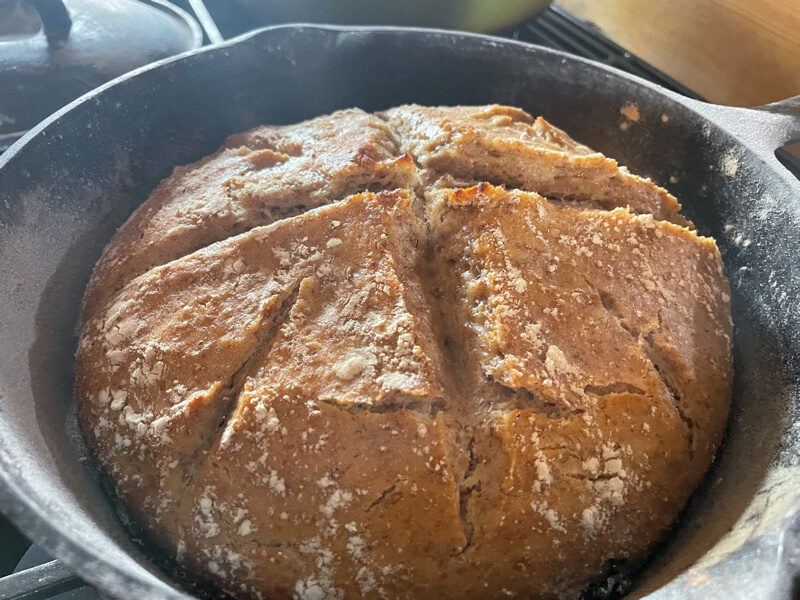
Spring isn’t quite here yet, but thankfully for our tastebuds, warm fresh bread is always in season! Fragrant, crunchy and yummy right out of the oven or cooled off, a simple loaf of sourdough only takes four ingredients. Did you know, grocery store Wonder Bread contains 20–many unpronounceable!—ingredients. That’s a big difference that translates to a much simpler, healthier bread.
One of the reasons sourdough gets away with so few ingredients is that you aren’t adding any yeast—you’re actually setting a trap for wild yeast and bacteria! If you’ve never caught wild yeast before, check out the instructions below. All you need to start your microscopic safari is flour, water, and a jar.
With time, the wild yeasts and bacteria around your house—in your kitchen, on your hands, even in the flour and water itself—will begin to colonize the flour-water slurry. They’ll multiply and make bubbles that eventually help give your bread the rise it needs to become a fluffy firm loaf. In addition to helping the bread rise, these sourdough microbes help break down the flour, enhancing the nutritional quality of the bread by making it easier to digest. They also add flavor by “burping out” waste products like lactic acid and acetic acid, which make the bread taste tangy. This also rasies the pH and makes it harder for harmful pathogens and molds to form in your food!
The way you bake your sourdough and what you bake it in changes its final characteristics. You could bake it in a fireplace, in a cast-iron skillet. You could bake it in the oven on a cookie sheet. The different ways you bake it will give it a different crust, and my personal favorite way to bake sourdough is in a cast iron skillet in the fireplace. It gives it a nice, crunchy, golden brown crust when you lump the hot coals on top of a cast iron pot lid.
But I want you to figure out your favorite way to bake sourdough—play with the kinds of flour, and where you bake it, and let me know any good tips you find out!
Ingredients
- 1 cup ripe (fed) sourdough starter
- 1 1/2 cups water, lukewarm
- 2 1/2 teaspoons salt
- 5 cups Flour
But wait! What if you don’t have a starter? It’s not hard, just time consuming. All you need is:
- 1 cup water
- 1 cup flour
- Jar
- In the jar, mix the water and flour together and leave out overnight.
- Scoop out half the starter and set aside. Feed the jar again with equal amounts water and flour, and let it sit overnight.
*You can use the starter you scooped out in place of flour in any recipe, or just discard/compost.
- Repeat step two for about seven to ten days.
- Congratulations, your sourdough is now ready to use!
*You still need to feed it once in a while though, maybe once a week in warm weather or twice a month in the winter (or if kept in the fridge). Whenever you’re working on your starter, aim for 50% water, 50% flour—you can eventually make a larger jar if you want by not disposing of as much starter when feeding it. You also can just keep it manageable around two cups if you want.
*Keep in mind you also need to feed the starter the night before you bake with it to make sure all the yeast and bacteria are awake and active.
Instructions:
- Combine all of the ingredients—flour, salt, starter and water—kneading to form a smooth dough.
- Allow the dough to rise in a bowl covered with a damp cloth until it’s doubled in size, or about 90 minutes in a warm house or sunny window.
- Gently divide the dough in half; it’ll deflate some but that’s ok. Shape each piece of dough by pulling the edges into the center, turning it over so the seam is on the bottom, and rolling under your cupped hands to form a ball. Let the dough rest, covered, for 15 minutes more.
- To make fat oval loaves, elongate each ball of dough you’ve preshaped by gently rolling it back and forth on an unfloured work surface several times until it makes an oval 10″ to 11″ long.
- Put long loaves on a cookie sheet and let rise until very fluffy, about the one hour. Towards the end of the rising time, preheat the oven to 425°F.
- Spray the loaves with lukewarm water and dust generously with sifted flour.
- Make two fairly deep diagonal slashes in each like an X; a serrated knife like a steak knife works well for this.
- Bake the bread for 25 to 30 minutes, until it’s a very deep golden brown. Remove it from the oven, and cool on a rack.

February 11, 2024 – Valentine’s Day special German Chocolate Cake
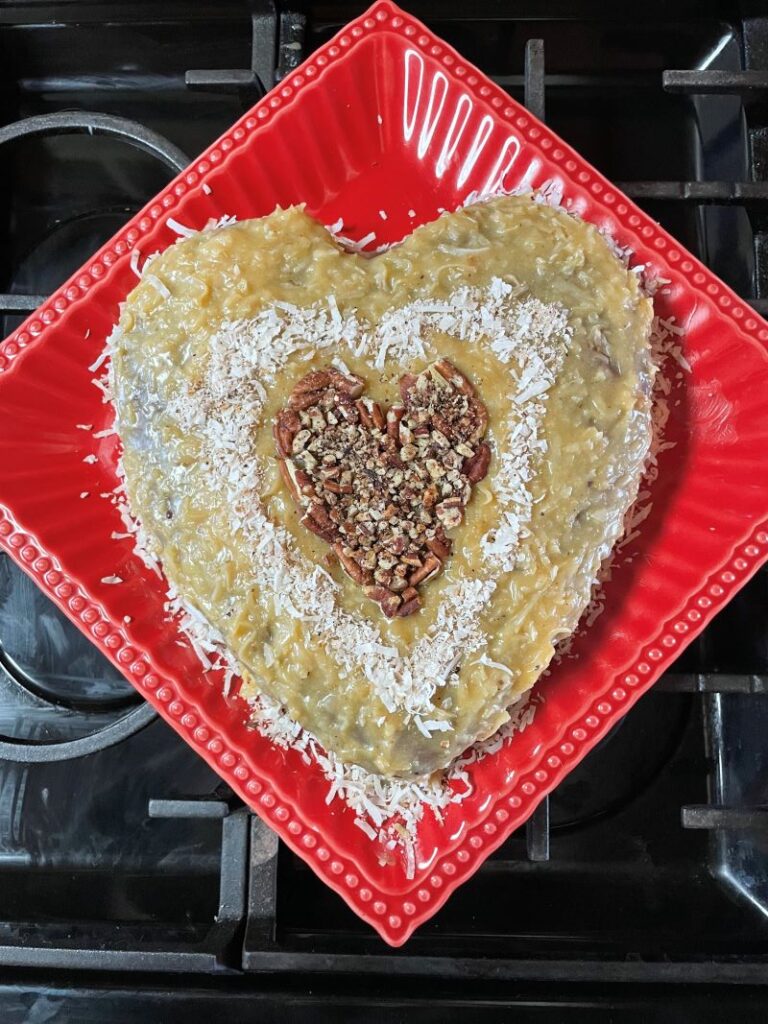
It’s almost Valentine’s Day and this cake is perfect for someone special. I’m giving it to my grandpa; he LOVES German chocolate cake! But even he was surprised to learn that “German chocolate cake” is not from Germany! Not by a long shot: it’s from Dallas, Texas.
German’s chocolate cake, as it was originally known, was created by a Mrs. George Clay and contained “Samuel German’s baking chocolate”—a popular brand at the time. Her recipe was featured in the Dallas Morning News as a “Recipe of the Day” in 1957 and the coconut in the frosting was a big deal in the 1950s! Hawaii didn’t become a state until two years later, but after World War Two, the United States went coco-nuts for all sorts of island fruits! Dried coconut could be transported more easily—it was lighter and stayed fresh longer than whole coconut, making it perfect for adding to all sorts of sweet treats.
I think it can be made even better today by substituting some of the butter for coconut oil—it’s extra coconutty! I’ve also added an extra egg to the cake itself, for more rise. Watch your cake for peak fluffiness somewhere between 25 and 30 minutes—being at a higher elevation means things bake a bit faster and tend to be a little drier than most recipes account for, so the time will vary. I find 30 perfect for tray cakes, 25 for shaped cakes like this week’s Valentine’s Heart Cake!
Ingredients
- 1 1/2 cups unsalted butter, softened (I use half butter and half coconut oil, or 3/4 cup each for an extra coconutty taste)
- 1 1/2 cups white granulated sugar
- 7 large eggs
- 1 cup semi-sweet chocolate chips, melted in a double boiler
- 2 tsp vanilla extract
- 1 1/2 cups milk
- 3 cups all-purpose flour
- 1/2 cup cocoa powder
- 2 tbsp baking powder
- 1/2 tsp salt
For German Chocolate icing:
- 3/4 cup unsalted butter (Or coconut oil!)
- 12 oz evaporated milk
- 6 egg yolks
- 1/2 cup sugar
- 1/2 cup brown sugar
- 1 tsp vanilla extract
- 3 cups coconut flakes; divided
- 1/2 cups chopped pecans roasted
- Preheat oven to 350F. Butter your pan—either a heart shaped tin, or a regular 9×13.
- In a large mixing bowl, cream together the softened butter and sugar for 3 to 4 minutes until light and fluffy. Then add in the eggs and vanilla extract. Mix again until creamy, then add the 1/3 cup milk to the batter, along with the melted chocolate. Whisk again for a minute until the mixture is smooth.
- Add the remaining milk but don’t mix it in yet (you want the liquid on top when the dry ingredients get sifted in, to make it easier to not over mix).
- In a separate bowl, combine all the dry ingredients: flour, cocoa powder, salt and baking powder. Mix together, then sift into the cake batter to get rid of any clumps.
- Using a hand whisk, mix the flour into the batter just until combined. Be careful not to over-mix the batter!
- Pour your batter into the prepared baking pans. Bake in oven for 30 minutes, or until a toothpick inserted into the center comes out clean. Allow the cakes to cool in the pan.
Frosting Time
- While the cake layers are cooling, prepare the coconut pecan filling by placing all 3 cups of the unsweetened coconut into a large saute pan. Toast on high heat for 3 to 4 minutes, until the flakes are golden. (This can also be done using a baking sheet; bake under the broiler for several minutes and toss often instead!) Reserve 1/2 cup of the flakes for garnishing the cake.
- Into a medium-sized saucepan, add the butter and melt it over medium heat. To the melted butter, add the evaporated milk, egg yolks and sugars. Whisk for a minute until smooth. Cook the custard over medium-low heat, stirring constantly with a rubber spatula, for 10 to 12 minutes, until the custard thickens and holds its shape on the back of the spatula (think Jello pudding!). Do not boil the custard; reduce heat when needed otherwise you’ll have scrambled egg frosting!
- Once the custard has thickened, remove it from the heat and add the vanilla, toasted coconut and half of the chopped pecans. Mix until well combined, then allow the filling to cool completely. Place into the refrigerator to cool faster.
- Once the cake and frosting have both cooled, frost the cake with the coconut frosting and garnish with the reserved pecans and coconut.
*It isn’t just pecans and coconut—this dark cake pairs well with all kinds of nuts and fruit! Try walnuts, pine nuts, fresh cherries, raspberries…and share with someone you love!

February 4, 2024 – Pumpkin Ravioli
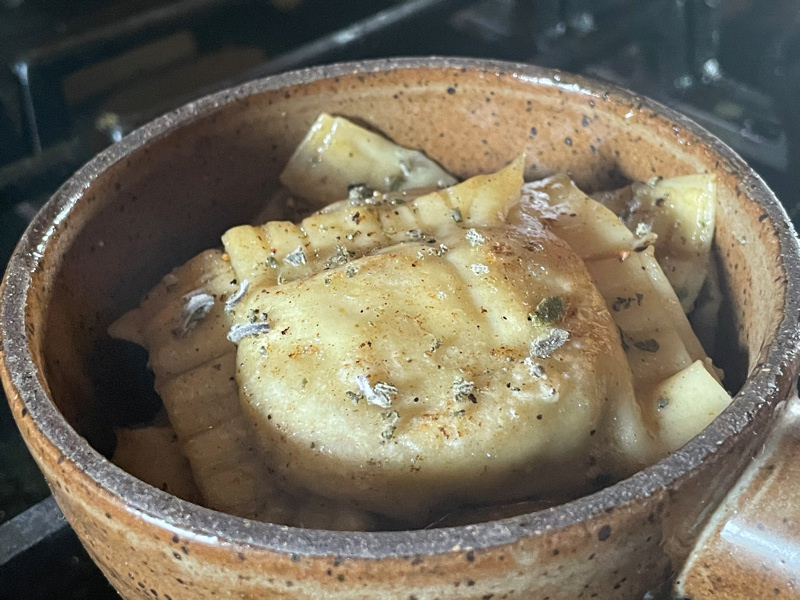
When it’s cold outside, and you need to warm yourself up, nothing beats a cozy bowl of pasta! One of the best pastas to warm yourself with this winter is pumpkin cheese ravioli.
Pumpkins, a North American native that belong in the gourd family, ripen in the fall but will keep for months depending on the variety and the way it is stored—we have a bunch in the basement right now! While people know them best as jack-o-lanterns, pumpkins can be used in a variety of ways. One of my family’s favorite ways to eat vegetables is with pasta, and I think the best pasta is ravioli! So it was easy to make the decision to try a pumpkin ravioli recipe. If you don’t have fresh pumpkins, canned pumpkin is just fine—but also isn’t “pumpkin!” Most canned pumpkin is technically made from Dickenson squash, a different type of gourd! So with that in mind, feel free to stuff your pasta sheets with whatever pumpkins (or squash) you can get your hands on.
The cheeses you use can similarly be swapped around—the recipe I started with asked for ricotta, but the store didn’t have any. We opted for mozzarella, queso fresco and Parmesan instead, but you can use any mild, melty cheese. Just don’t call it Parmesan if it isn’t from Parma or Reggio Emilia, in Italy—their cheese is so famous it has a protected designation of origin, or PDO! Using local cheeses would give it a special New Mexican flair. As is, there’s nothing wrong with these mildly pumpkiny, ooey-gooey cheesey, and definitely buttery ravioli. Watch out when rolling out the dough, though, because rolling it too thin will lead to the dough breaking open when it cooks and expands—all your filling will leak out!
Ingredients
For the Pasta Dough
- 2 1/4 cups flour
- 3 large eggs
- 1 large egg yolk
- 1/4 cup water
- Salt to taste
- Olive oil to taste
Ravioli Filling
- 1 1/2 cups roasted squash
- 1/2 cup mozzarella
- 1/2 queso fresco
- 1 1/2 tsp pepper
- Generous pinch of salt
To Serve
- 8tbs salted butter
- 1/2 tbs dried sage
- 1/4 cup parmesan
Instructions
- Make Pasta Dough: Add the flour, eggs and olive oil (if using) to a bowl and mix thoroughly. Move to your work surface and knead the dough into a ball, about 1-2 minutes. Let this rest while you make your filling.
- Make the filling by mixing the roasted squash, butter and cheeses together. Taste and season with salt and pepper as needed. Transfer to a bowl. Chill until it’s cool to touch: you can’t use hot filling to assemble ravioli because the dough will get soggy.
- Roll out your pasta dough with a pasta roller or a rolling pin until it’s just slightly see through. Trim into a long rectangle about 1 ft long and 3 inches wide.
- Grab a pasta sheet and put in filling (1 tbs at a time) along the bottom half of the sheet, spaced 2 finger widths apart. Fold the top sheet over.
- Gently push between the filling spots. Press to seal the edges and sides. Cut in between the filling spaces.
- Crimp the edges with a fork.
- Boil a pot of water; salt it generously. Put pasta in boiling water and cook until they float.
- Start the butter sage sauce in a medium frying pan ; as the raviolis cook, place 4 or 5 at a time and fry in the browned butter with sage.
- Top with Parmesan.




